Get Featured on Banaras Trip
Host Your site in just 1000/Year


Top 10 Best places to visit in Sarnath [Updated List]
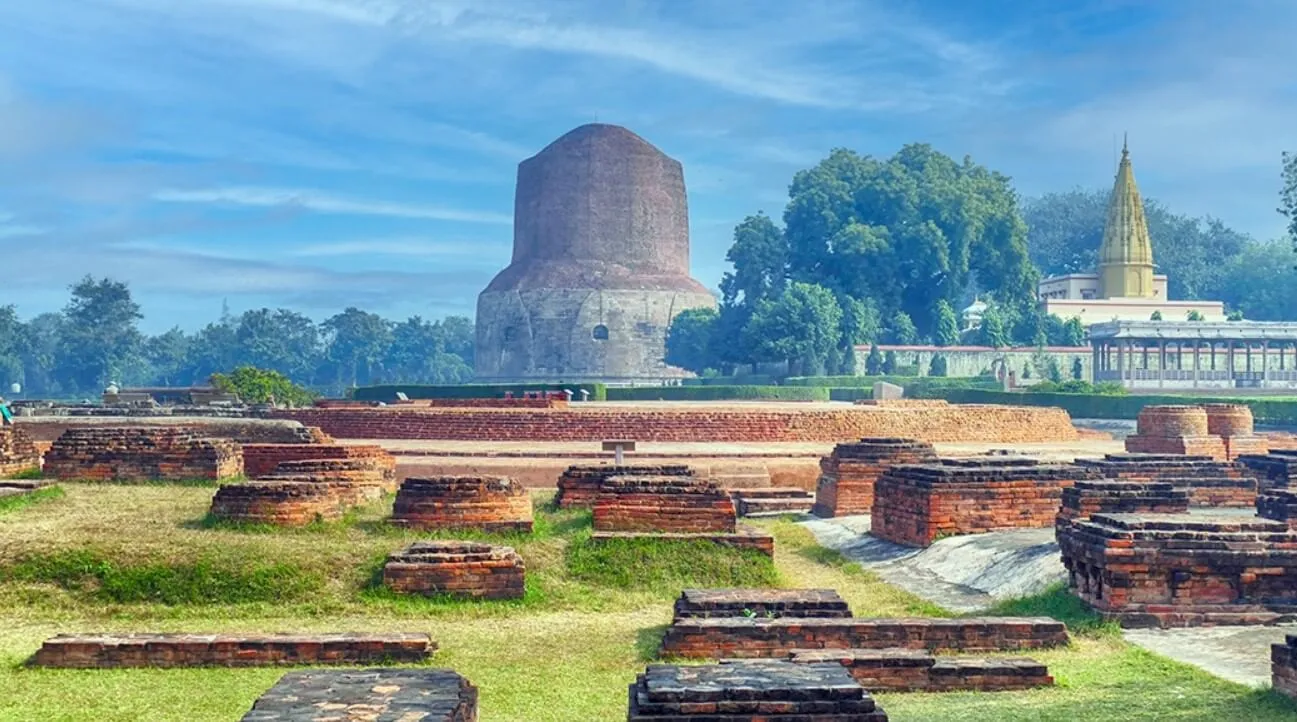
Sarnath, a small city in Uttar Pradesh, India, is considered one of the most sacred places in Buddhism. It is here that Lord Buddha preached his first sermon after attaining enlightenment. The city is famous for its ancient stupas, temples, and monasteries that reflect the rich cultural heritage of the region. Apart from being a pilgrimage site, Sarnath also attracts tourists from all over the world who come to explore its historical and cultural significance. With so much to see and do, it can be overwhelming to pick the best places to visit in Sarnath.
In this blog post, we will guide you through the top attractions that you should not miss when visiting this holy city. From the ancient ruins of Dhamekh Stupa to the magnificent Mulgandha Kuti Vihar, we will take you on a journey through the rich history and culture of Sarnath. Whether you are a history buff, a spiritual seeker, or just someone who loves to explore new
Table of Contents
Best places to visit in Sarnath
1. explore the ancient stupas, 2. visit the dhamekh stupa, 3. see the mulagandha kuti vihar, 4. marvel at the archeological museum, 5. experience buddhist culture and history, 6. meditate at deer park, 7. discover the thai temple, 8. go on a pilgrimage journey, 9. experience the local cuisine, 10. shop for souvenirs and crafts, faqs related to places to visit in sarnath.
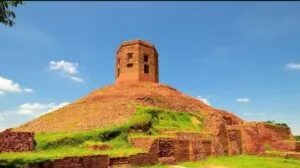
Sarnath is a city that is steeped in history and is a significant destination for those interested in Buddhist culture and spirituality. One of the best ways to experience this is by exploring the ancient stupas that can be found throughout the city. These stupas, which are architectural structures that are typically used as a place of meditation and worship, have a rich history and are an important part of the cultural heritage of the city. Tourists can visit the Dhamekh Stupa, which is the largest and most impressive of the stupas in Sarnath, standing at a height of 43.6 meters.
This stupa is believed to have been built by the Mauryan emperor Ashoka in the third century BCE, and it is said to mark the spot where the Buddha gave his first sermon after attaining enlightenment. Other notable stupas in Sarnath include the Chaukhandi Stupa, the Mulagandha Kuti Vihar Stupa, and the Sarnath Museum Stupa. Exploring these ancient stupas is an enriching experience that provides a glimpse into the spiritual and cultural history of Sarnath.
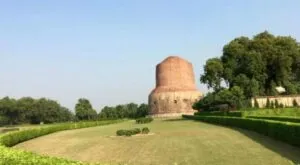
One of the top destinations to visit while in Sarnath is the Dhamekh Stupa. This impressive structure is a significant Buddhist monument and was built in the 5th century AD. The stupa is an impressive sight, standing at a height of 43.6 meters and a diameter of 28 meters. The structure is a testament to the rich history and culture of the region, and its intricate design is sure to captivate visitors.
The Dhamekh Stupa is surrounded by lush green gardens, offering a peaceful and serene environment for visitors to relax and take in the surroundings. A visit to this historic site is a must for those interested in Buddhism and the rich cultural heritage of Sarnath.
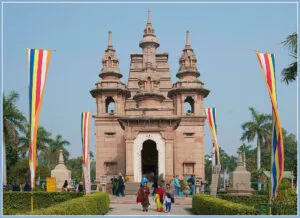
Sarnath is a serene and historic place where you can experience the spiritual and cultural heritage of India. Amongst the many attractions, the Mulagandha Kuti Vihar stands out as a must-visit destination for any traveler to Sarnath. The Mulagandha Kuti Vihar is a Buddhist temple that is famous for its exquisite architecture and its historical significance.
The temple is believed to have been built at the spot where Lord Buddha gave his first sermon. The temple is adorned with beautiful murals and frescoes that depict the life of Buddha and his teachings. The serene and peaceful atmosphere of the Mulagandha Kuti Vihar is sure to leave a lasting impression on any visitor. It is a perfect place to meditate and reflect on the teachings of Lord Buddha.
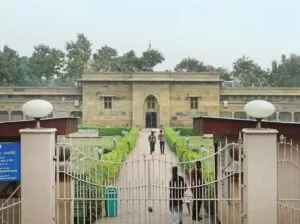
If you’re planning a trip to Sarnath, the archeological museum is a must-visit destination. Located within the Sarnath complex, this museum showcases a vast collection of artifacts, sculptures and relics that date back to the 3rd century BC. The museum is home to an impressive collection of Buddhist art, including the famous Ashoka Pillar, which is one of the most iconic symbols of Buddhism.
In addition to the Ashoka Pillar, visitors can marvel at the numerous statues of Buddha and Bodhisattvas on display in the museum. With its impressive collection of ancient artifacts, the archeological museum is a must-see for anyone interested in the rich history and cultural heritage of Sarnath.

Sarnath, located in the Indian state of Uttar Pradesh, is a renowned pilgrimage destination for Buddhists from around the world. One of the top attractions in Sarnath is the chance to experience Buddhist culture and history firsthand. Visitors can explore the sacred sites and monuments in the region, such as the Dhamekh Stupa, Mulagandha Kuti Vihar Temple, and Chaukhandi Stupa. These sites are integral to the history of Buddhism, as Sarnath is where the Buddha gave his first sermon after achieving enlightenment.
The region is also home to several museums, including the Sarnath Archaeological Museum, which is dedicated to preserving the rich cultural heritage of Sarnath and showcasing the evolution of Buddhism over the centuries. For those seeking to immerse themselves in Buddhist culture and history, Sarnath is a must-visit destination.
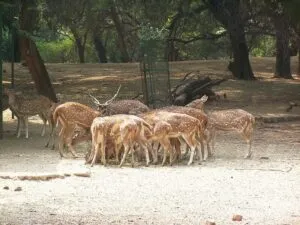
Sarnath, located near Varanasi in the Indian state of Uttar Pradesh, is a popular destination for those seeking spiritual enlightenment and historical significance. One of the best places to visit in Sarnath is the Deer Park, where the Buddha is said to have given his first sermon after achieving enlightenment. The park is a peaceful and serene environment that is perfect for meditation. Visitors can sit in the shade of the trees, listen to the sound of the nearby river, and reflect on their own spiritual journey.
The Deer Park is also home to several ancient Buddhist structures, including stupas and monasteries, making it a fascinating place for history buffs. Whether you’re seeking inner peace or simply want to explore the rich history of Buddhism, the Deer Park is a must-visit destination in Sarnath. Don’t miss the opportunity to meditate in this beautiful and historic location.

Located in the historic city of Sarnath, the Thai Temple is a must-visit destination for anyone interested in exploring the city’s rich cultural heritage. The temple is known for its stunning architecture, which is a blend of Thai and Indian styles, and features colorful murals and intricate carvings that showcase the best of both cultures. The temple also houses a magnificent Buddha statue, which is one of the largest in the country, and is a popular spot for meditation and quiet reflection.
Visitors can also take part in the temple’s daily rituals and ceremonies, which offer a unique glimpse into the spiritual practices of the local community. Whether you are a history buff, a spiritual seeker, or simply looking for a peaceful retreat, a visit to the Thai Temple is an experience not to be missed.
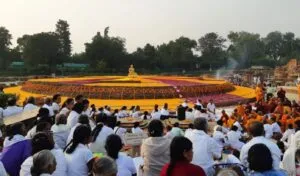
Sarnath is a sacred city for Buddhists, and a pilgrimage to this holy place is an incredible experience that can be life-changing. The city is located in the Indian state of Uttar Pradesh and is considered one of the four most significant places associated with the life of Gautam Buddha. A pilgrimage to Sarnath is an opportunity for visitors to connect with Buddhism’s roots and gain a deeper understanding of the religion’s philosophy.
The city is home to several significant Buddhist sites, such as the Dhamek Stupa, the Chaukhandi Stupa, and the Mulagandha Kuti Vihar. These sites are steeped in history and are places of immense spiritual importance. A pilgrimage journey to Sarnath is a transformative experience that can bring peace and clarity to one’s mind, body, and spirit.

One of the best ways to truly immerse yourself in a new culture is by experiencing the local cuisine. Sarnath is no exception as it is known for its diverse and delectable food offerings. From street vendors to high-end restaurants, there is no shortage of options for food enthusiasts to explore. Some of the must-try dishes in Sarnath include the popular chaat, a savory snack made with potatoes, chickpeas, and spices, and the mouth-watering lassi, a yogurt-based drink that comes in different flavors such as mango, rose, and saffron.
Additionally, the city is also known for its fragrant and aromatic biryanis, which are a perfect blend of spices and rice. Overall, experiencing the local cuisine is a must-do when visiting Sarnath, as it provides a glimpse into the city’s unique culture and flavors.

When visiting Sarnath, one of the top activities to enjoy is shopping for souvenirs and crafts. Sarnath is renowned for its exquisite handicrafts, including intricate wood carvings, stone sculptures, and fine silk weaves. The best places to find these unique treasures are the local markets and bazaars, where you can browse a vast array of handmade items and support the local artisans. The Sarnath Handicrafts Emporium is a popular shopping destination that offers a wide range of handicrafts and souvenirs, including Buddhist prayer flags, incense sticks, and figurines.
Another excellent place to shop for souvenirs is the Tibetan market, which sells an eclectic mix of handcrafted jewelry, pottery, and textiles. Be sure to bargain with the vendors to get the best price for your purchases. Shopping for souvenirs and crafts is a great way to take home a piece of Sarnath’s rich cultural heritage and support the local economy.
In conclusion, Sarnath is a place of great historical and cultural significance and a must-visit destination for anyone interested in the ancient history of India. From the majestic Dhamek Stupa to the serene Mulagandha Kuti Vihar, Sarnath offers a wealth of fascinating attractions that will captivate and inspire visitors. Whether you are a history buff, a spiritual seeker, or simply looking for a peaceful and beautiful place to explore, Sarnath has something to offer everyone. So, if you are planning a trip to India, be sure to include Sarnath on your itinerary and experience the wonder and beauty of this amazing destination.
What is Sarnath known for, and why is it a popular tourist destination? Sarnath is known for being the place where Lord Buddha delivered his first sermon after attaining enlightenment. It is a popular tourist destination due to its rich Buddhist heritage and historical significance.
What are the must-visit historical sites in Sarnath? The must-visit historical sites in Sarnath include the Dhamek Stupa, Chaukhandi Stupa, Ashoka Pillar, and Mulagandha Kuti Vihar.
Are there any important Buddhist landmarks in Sarnath? Yes, there are important Buddhist landmarks in Sarnath, such as the Mahabodhi Temple and the Thai Temple.
How far is Sarnath from Varanasi main city, and how can I reach there? Sarnath is approximately 10 kilometers away from Varanasi main city, and you can reach there by taxi, auto-rickshaw, or public transportation.
What are the best times of the year to visit Sarnath? The best times of the year to visit Sarnath are during the winter months (November to February) and the early spring (March) when the weather is pleasant.
Can you recommend some good hotels or accommodations in Sarnath? Some good hotels or accommodations in Sarnath are Hotel Surya, Hotel Buddha, and Hotel Sarin Inn.
Is there an entry fee to visit the major attractions in Sarnath? There might be an entry fee to visit the major attractions in Sarnath. It is recommended to check with each site individually for the current fees.
What are the top things to do in Sarnath besides visiting the historical sites? Besides visiting historical sites, you can attend meditation sessions, explore the Sarnath Archaeological Museum, and witness the evening light and sound show.
Are there any local festivals or events that travelers should consider attending in Sarnath? Sarnath hosts several Buddhist festivals, and the most notable one is Buddha Purnima, which commemorates the birth, enlightenment, and death of Lord Buddha.
Are there any nearby attractions or day trips that can be combined with a visit to Sarnath? You can combine a visit to Sarnath with a day trip to Varanasi, as it is nearby and offers a different cultural experience.
Is it possible to explore Sarnath on foot, or should I consider other transportation options? Sarnath can be explored on foot, as the main attractions are relatively close to each other. Alternatively, you can hire a cycle rickshaw or rent a bicycle for convenience.
What are some of the best places to try local cuisine in Sarnath? For trying local cuisine, you can visit eateries near the main attractions or explore nearby restaurants in Varanasi.
Are there any restrictions or guidelines for photography at the tourist sites in Sarnath? There might be restrictions on photography at certain sites, particularly inside temples and museums. It’s essential to respect the rules and guidelines.
What are the opening and closing timings of the major attractions in Sarnath? The opening and closing timings of major attractions in Sarnath vary, but they generally open around sunrise and close by early evening.
Are there any guided tours available for a more immersive experience in Sarnath? Yes, guided tours are available in Sarnath, and they offer a more immersive experience, providing deeper insights into the history and significance of the place.
Is Sarnath suitable for family travel, and are there any kid-friendly attractions? Sarnath is suitable for family travel, and there are kid-friendly attractions like the deer park and the opportunity to learn about Buddhism’s teachings.
What are the key historical and cultural insights that visitors can gain from a trip to Sarnath? A trip to Sarnath offers visitors key historical and cultural insights into the development of Buddhism and its impact on Indian civilization.
How much time should I allocate to explore Sarnath thoroughly? To explore Sarnath thoroughly, allocate at least half a day to a full day, depending on your level of interest and pace.
What are some recommended souvenirs or items to buy as mementos of the visit to Sarnath? Some recommended souvenirs to buy as mementos of the visit to Sarnath include Buddhist prayer flags, statues of Buddha, and traditional handicrafts. Other common souvenirs are postcards, books about Buddhism, and items related to Indian spirituality.
Author: Banaras Trip
Your email address will not be published. Required fields are marked *
Save my name, email, and website in this browser for the next time I comment.

- What is some local food to try in Varanasi?
- What is the best street food You Have Tried in Varanasi?
- What are the best food joints in Varanasi?
- What is Your favorite places to visit in Varanasi?
- What is the best street food in Varanasi?
Don’t wait any longer. Contact us!

Ganapati Niwas, B-24/32
Bhelupur, Varanasi, Uttar Pradesh 221010
Quick Links
Special links.
- Live Darshan
- Banarasi Ghat
- Banarasi Chai
Get Updates & More
Username or email *
Ut enim ad minim veniam, quis nostrud exercitation ullamco laboris nisi ut aliquip ex ea commodo consequat. Duis aute irure dolor in reprehenderit in
+ 844 1755 – 444 11
Sarnath: The Complete Guide
:max_bytes(150000):strip_icc():format(webp)/10947453_10153084623948270_8191342691038933499_o-591d1e8d3df78cf5fa731909.jpg)
Evgenii Mitroshin / Getty Images
- How to Visit
- What to See
- What Else to Do
Sarnath (along with Bodhgaya and Kushinagar in India and Lumbini in Nepal) is one of the four most important Buddhist pilgrimage destinations in the world. It has special significance because it's the place where the Buddha gave his first sermon. However, you don't have to be Buddhist to enjoy visiting it. Sarnath also makes a peaceful and refreshing side trip from Varanasi. Many people are surprised to discover Sarnath has Jain and Hindu connections too. Find out what you need to know to visit in this guide.
History of Sarnath
A long time ago, around the 5th century B.C., a young prince named Siddhartha Guatama was born in Lumbini. He led a very sheltered and lavish life. However, just before he turned 30, he ventured out into the countryside, where he encountered illness and death. This prompted him to give everything up and search for liberation from suffering.
Eventually, he realized that liberation comes from disciplining the mind. He then sat down to meditate under a sacred fig tree and resolved not to get up until he became enlightened. It happened profoundly on one full moon night. The tree (which came to be known as the Bodhi tree in reflection of his awakening) was located at the site of the magnificent Mahabodhi temple in Bodhgaya.
The Buddha didn't start preaching at Bodhgaya, though. There were five people he wanted to teach first. He'd previously practiced physical discipline with them as a means to liberation. They'd left him in disgust after he decided it wasn't the right path to liberation. The Buddha heard they were dwelling in a deer park at Sarnath, so he headed there. They were so impressed with his newfound wisdom and Four Noble Truths that they became his first disciples.
Buddhism flourished in Sarnath due to its proximity to Varanasi. However, most of the structures were built by Mauryan Emperor Ashoka a couple of centuries after the religion was established. Guilt over his brutal invasion of Kalinga (present-day Odisha on India's east coast) caused him to convert to Buddhism and practice nonviolence. He enthusiastically went about constructing stupas and pillars across India to promote the religion.
The most celebrated pillar is the one at Sarnath. The national emblem of India, featuring four lions and a dharma chakra (the wheel representing the Buddhist teachings), is derived from it. The chakra also appears on the Indian flag.
Subsequent rulers added to the stupas and monasteries that Ashoka built at Sarnath. During the reign of the Gupta dynasty in the 4th century A.D., Sarnath was an active center of art and Buddhist sculpture. By the 7th century, Sarnath had become a major center for the study of Buddhism, and thousands of monks were living in monasteries there.
Unfortunately, Turkish Muslim invaders arrived in the 12th century and destroyed much of Sarnath and many other Buddhist sites in North India. Most of what remained of the Dharmarajika Stupa, made by Ashoka, was further demolished in the late 18th century by Jagat Singh (Dewan of Raja Chet Singh of Banaras) and used as building materials. However, this rediscovery of Sarnath prompted British archeologists to excavate the site in the 19th and 20th centuries.
The Indian government is now in the process of getting Sarnath permanently listed as a UNESCO World Heritage Site and has plans to develop world-class facilities for pilgrims and tourists.
How to Visit Sarnath
Sarnath is located about 8 miles northeast of Varanasi in Uttar Pradesh . Travel time is about 30-40 minutes, making it an easy half-day trip from Varanasi. There are various ways of getting there, depending on your budget. The most convenient way is to take an auto-rickshaw or Ola cab (the Indian version of Uber. Uber is yet to start operating in Varanasi). Expect to pay around 200-300 rupees for an auto rickshaw and 400-500 rupees for a taxi, one way. Ideally, negotiate the fare for a round trip. Cheaper buses and shared auto rickshaws are also available from Varanasi Junction railway station.
If you don't have your own transport in Sarnath, it's a good idea to hire a bicycle there to see everything.
For a detailed explanation of the history of the monuments, you'll find plenty of local guides waiting at Sarnath. They charge about 100 rupees, or less, if you agree to visit shops where they'll get a commission.
Alternatively, Varanasi Magic conducts a half-day excursion to Sarnath . Indian Railway's special Mahaparinirvan Express Buddhist Circuit Train includes Sarnath on its itinerary too.
Avoid visiting Sarnath on Fridays because the museum is closed. Some monuments require tickets, which can be purchased online from the Archeological Survey of India or at the ticket office at the entrance.
What to See in Sarnath
The main attraction is the Dhamekh stupa complex, where the excavated ruins are located. It's set in a landscaped park and contains the well-preserved Dhamekh Stupa (at the spot where the Buddha is believed to have delivered his first sermon), plus the remains of Buddhist monasteries, the Ashoka Pillar, and Dharmarajika Stupa. The complex is open daily from dawn until dusk. Tickets for foreigners cost 300 rupees (cash) or 250 rupees (cashless). Indians pay 25 rupees (cash) or 20 rupees (cashless).
A new high-tech sound and light show, inaugurated in November 2020, takes place every evening from 7.30 p.m. to 8 p.m. in the park at Dhamekh stupa. It narrates Lord Buddha’s life and teachings in the enchanting baritone voice of popular Bollywood actor Amitabh Bachchan.
On display at the attractive Sarnath Archaeological Museum, next to the Dhamekh stupa complex, are interesting artifacts dating from the 3rd century B.C. to the 12th century A.D. The impressive top of the Ashoka Pillar is also a highlight. The museum is open daily, except Fridays, from 9 a.m. to 5 p.m. Tickets cost 5 rupees for foreigners and Indians. Photography is not allowed.
Modern-day temples and monasteries belonging to various Buddhist countries are dotted around the town. Each has its own architectural style and beauty. The main one is Mulagandha Kuti Vihar. It was built in 1931 by the Sri Lanka Mahabodhi Society in honor of the shrine where the Buddha is said to have sat and meditated in Sarnath. It's open daily from 4 a.m. to 11:30 a.m. and 1:30 p.m. to 8 p.m. The walls are adorned with magnificent art. There's a park behind it where deer sometimes roam.
The Thai temple and monastery is renowned for its 80-foot-tall stone Buddha statue, claimed to be the largest in India.
The Chaukhandi Stupa is another major stupa that's in relatively good condition. It marks the spot where the Buddha met up with his five companions. The Archeological Survey of India has started maintaining the site. There's now an entry fee of 300 rupees (cash) or 250 rupees (cashless) for foreigners and 25 rupees (cash) or 20 rupees (cashless) for Indians.
Next to the Chaukhandi Stupa, the Garden of Spiritual Wisdom is a new attraction with sculptures and exhibits related to Buddhism. It has a section with Ayurvedic plants as well.
The eleventh Jain tirthankara (spiritual teacher) Shreyanshnath was born in the area. There's an important 19th-century Jain temple dedicated to him close to the Dhamekh Stupa complex.
What to Do Nearby
Lamhi village, about 30 minutes west of Sarnath, is the birthplace of acclaimed Hindi and Urdu writer Munshi Premchand. Cattle farms and agricultural fields can be visited there.
Sarai Mohana village, about 20 minutes south of Sarnath, is home to a local weaving community that makes the famed silk Banarasi saris.
Sanchi Stupa: The Complete Guide
Fatehpur Sikri in India: The Complete Guide
Karla Caves in Maharashtra: The Complete Guide
Delhi's Lotus Temple: The Complete Guide
18 Top Things to Do in Bihar, India
14 Famous Forts and Palaces in India that You Must See
Jaipur's Amber Fort: The Complete Guide
The Ultimate Guide to the Taj Mahal in India
One Week in Delhi: The Perfect Itinerary
Varanasi Guide: Planning Your Trip
3 Sacred Odisha Buddhist Sites and Attractions
15 of the Most Beautiful Sacred Sites in Nepal
How to Visit Bodh Gaya India: Where Buddha Became Enlightened
Spiritual India: 7 Top Destinations You Shouldn't Miss
Guide to India's Mahaparinirvan Express Buddhist Circuit Train
Bihar's Mahabodhi Temple in Bodhgaya and How to Visit It
You will be redirected to your dashboard shortly. We will also call you back in 24 hrs .
- 10 Interesting Things To Do In Sarnath For A Memorable Travel Experience
23 Mar 2023
Cover Image Credit: pexels.com
Sarnath in Varanasi is known to be the place of Gautama Buddha. His first ever discourse was held here in the city’s Deer Park. All kinds of travelers feel a beautiful spiritual connection on their visit to this city. Sarnath sits where the sacred Ganga and Gomati rivers merge. It has many names – Mrigadava, Migadāya, Rishipattana and Isipatana, all with a spiritual significance. With so much to explore, there can never be a dearth of things to do in Sarnath . By indulging yourself in some of the best activities here, you won’t only get a glimpse of the city’s historicity but also its cultural aspects.
10 Things To Do In Sarnath
If you are visiting this holy city, keep this list of top 10 things to do in Sarnath handy for a comprehensively fun travel experience.
1. Witness The Majestic Bodhi Tree 2. Visit Chaukhandi Stupa 3. Seek Enlightenment At Dhamek Stupa 4. Visit The Place Where The Buddha Rests In Peace 5. Witness Buddha Purnima Celebrations 6. Travel Back In Time At The Archaeological Museum 7. Visit The Buddhist Temple 8. Try The Local Food 9. Visit The Thai Temple And Monastery 10. Relax At The Garden Of Spiritual Wisdom
1. Witness The Majestic Bodhi Tree
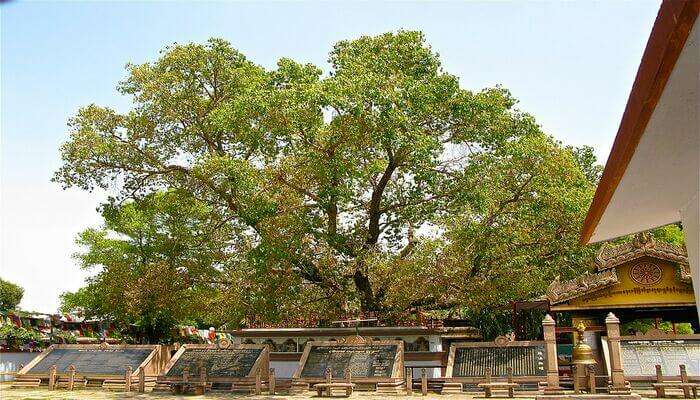
Image Source
Visiting the fresco art rich Mulgandha Kuti Vihar is one of the best things to do in Sarnath. The frescos on the walls of the structure depict important events from Buddha’s life. The murals are painted by renowned Japanese artist Kosetsu Nosu. Since it’s a temple, inside you will find a golden statue of Lord Buddha sitting on a marble platform. Situated just behind this Buddha temple is the Deer Park, the place of Buddha’s first ever sermon.
The highlight of this place, apart from the temple and the surrounding ruins, is the Bodhi Tree. It is said to have been grown from the sapling of the tree in Bodh Gaya under which Buddha attained enlightenment. Don’t leave this place before evening. As the sun is about to set, the place reverberates with the calming voices of monks chanting Buddha’s first sermon.
Must Read: Top 12 Summer Festivals In India You Shouldn’t Miss
2. Visit Chaukhandi Stupa
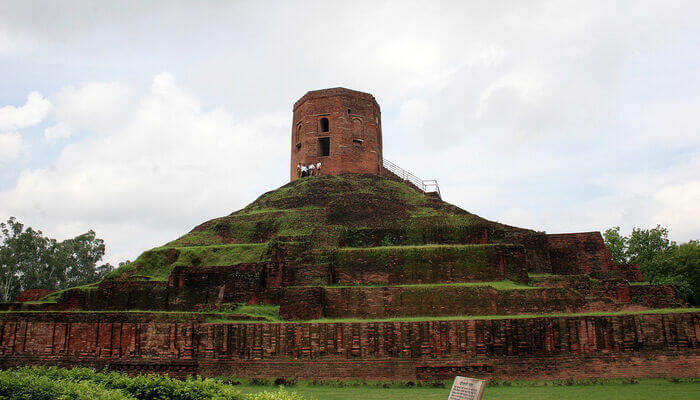
Did you know, Buddha was once deserted by five of his disciples in Rajgir as he travelled from Bodhgaya to Sarnath? Chaukhandi Stupa stands on the spot where Buddha reunited with those pancha vargiya bhikkhus (5 disciples).
The stupa is as old as 5th century AD. The tower atop the stupa was added to the structure in the 16th century to commemorate Emperor Humayun’s visit to the monument. The beautiful structure is worth marvelling at for long hours. After that, sit amidst the green surroundings and attain peace through meditation.
Suggested Read: 12 Best Things To Do In Varanasi For An Enigmatic Vacation
3. Seek Enlightenment At Dhamek Stupa
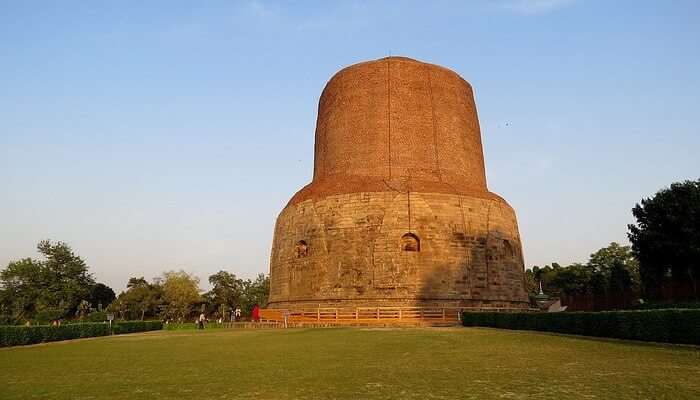
After hearing the sermons of the Buddha in the Mulgandha Kuti Vihar, head to the place where it was actually delivered. Dhamek Stupa is situated just behind Mulgandha Kuti Vihar. Dhamek Stupa is a collection of stupas, monasteries, ruins, temples, museums, gardens and more. Situated inside the Deer Park, this place offers a memorable glimpse of the Buddhist history and culture to the visitors.
4. Visit The Place Where The Buddha Rests In Peace
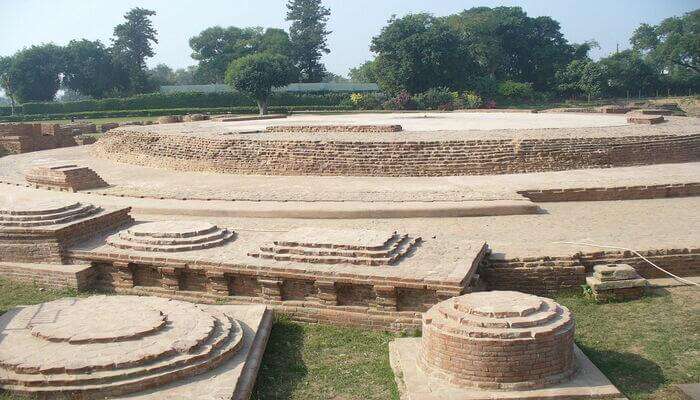
Situated close to Dhamek Stupa is the Dharmarajika Stupa. This stupa is mostly in ruins today. This place is believed to house the mortal remains of Lord Buddha. The remains were divided in 10 parts and buried at different spots atop which monuments were built by the Mughal.
Suggested Read: 23 Places To Visit Near Varanasi That You Cannot Miss Out On
5. Witness Buddha Purnima Celebrations
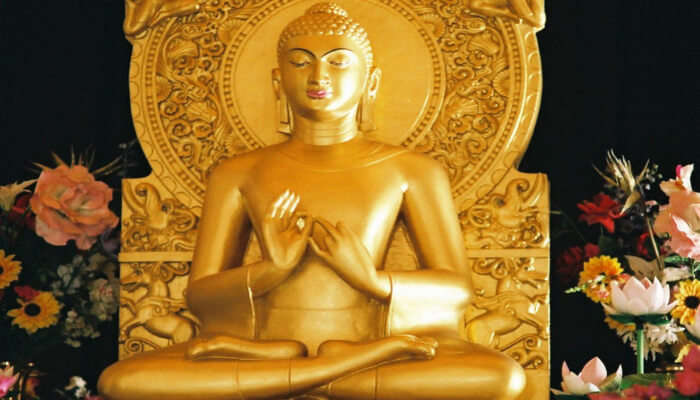
Make sure you plan your holiday to Sarnath around Buddha Purnima, which falls in Vesak month that usually comes in the month of May. The city is something else on Buddha Purnima. Buddhists from all over the world come to the city to celebrate the joyous occasion. Huge processions displaying Buddha relics to the public are held along with grand festivities.
Suggested Read: 14 Varanasi Festivals You Can Attend To Add Those Festive Vibes To Your Trip
6. Travel Back In Time At The Archaeological Museum
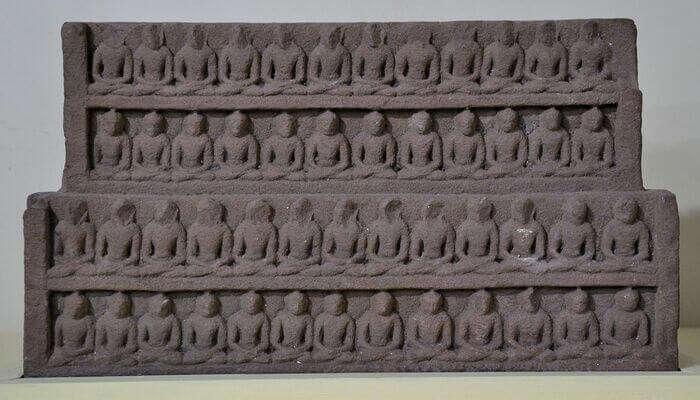
If you are a history buff, you simply cannot give the Archaeological Museum in Sarnath a miss. It lets visitors go back in time when Buddha roamed the land. It houses Buddhist relics that were recovered from the site where Buddha delivered his first sermon. The museum constructed using sandstone is around 100 years old. Apart from the relics from the events of Buddha’s life, the highlights of this museum are the 3rd-century-BC lion capital from the Ashoka Pillar and a 2000-year-old huge stone umbrella featuring Buddhist symbols.
Suggested Read: 23 Best Weekend Getaways In Varanasi Which Will Give You The Urge Of Taking A Road Trip!
7. Visit The Buddhist Temple

Painted soft and dark shades of yellow and red, this cute and calm temple is a must-visit place in Sarnath. if you are tired with your tour or suffering from the heat (if visiting during summers), this temple and its surroundings will immediately put you at peace. The temple is decorated with beautiful Chinese designs and heart-winning Chinese lanterns. Outside it, there is a small garden where you can relax and watch idling pigeons after visiting the temple.
8. Try The Local Food

After the soothing visit at the Chinese Buddhist temple, treat yourself to a sumptuous and tasty meal at Vaishali Restaurant. This is one of the best restaurants offering delicious local cuisine in the city. It is situated close to the temple. The colourful restaurant is on the 1st floor and serves mouth-watering Indian and Chinese dishes.
Suggested Read: 7 Guest Houses In Varanasi To Enjoy A Calm & Serene Stay
9. Visit The Thai Temple And Monastery

Though you will have to do some walking around the Thai Temple to view all the statues, it strangely won’t tire you. The place has a peaceful feel brought on by its beautiful look, serene surroundings and enchanting and enlightening Buddha statues.
Also known as Wat Thai, it is filled with alluring Buddha statues, including the Laughing Buddha and Buddha teaching his disciples. Outside the temple, there is a scenic fountain with blooming lotus and lots of greenery that serves as a good relaxation spot.
Suggested Read: 5 Airports In Varanasi That Offer Some Amazing Services To Its Guests!
10. Relax At The Garden Of Spiritual Wisdom
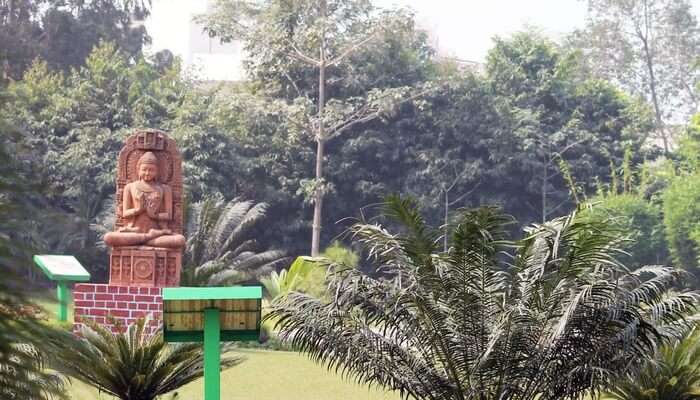
Nature with its best colours and beauty comes together at the Garden of Spiritual Wisdom. This is the place to unwind after a long and tiring trip in the city. This garden, situated just behind the Chaukhandi Stupa, offers bliss of the mind, body and soul to the visitors. The place is alive with beautiful plants and flowers spread across a vast, well-kept landscape.
This place is, undoubtedly, a heaven for nature lovers. They will be delighted to spot many Ayurvedic herbal plants here. Visitors can also enjoy education exhibits imparting knowledge about Buddha, spirituality and the various plants and herbs in the garden.
Further Read: 6 Hotels In Varanasi To Spend A Few Days In The ‘Land Of Gods’
These were some of the best and unique things to do in Sarnath. No matter whether you are visiting this place for the first time or tenth, it never fails to surprise its tourists. This sacred place has a lot to offer to its visitors in terms of rich history, spiritualism, and plenty of calm. Plan your Varanasi trip today with TravelTriangle and get ready for a surreal, enjoyable, and memorable experience in the holy city of Sarnath.
Disclaimer: TravelTriangle claims no credit for images featured on our blog site unless otherwise noted. All visual content is copyrighted to its respectful owners. We try to link back to original sources whenever possible. If you own the rights to any of the images, and do not wish them to appear on TravelTriangle, please contact us and they will be promptly removed. We believe in providing proper attribution to the original author, artist or photographer.
Please Note: Any information published by TravelTriangle in any form of content is not intended to be a substitute for any kind of medical advice, and one must not take any action before consulting a professional medical expert of their own choice.
Frequently Asked Questions About Things To Do In Sarnath
Why Is Sarnath a Famous Tourist Spot?
Sarnath, a city in Varanasi, is a place of great significance. It is the place that the revered Buddha chose for the awakening of his disciples by imparting his first ever sermons here. Places like Dhamek Stupa, Mulgandha Kuti Vihar and Chaukhandi Stupa are the city’s highlights and attract tourists from all over the world because of their connection with Buddha.
Why is Sarnath Important to Buddhist Followers?
Apart from the fact the Lord Buddha meditated and gave his first sermon here, and even was buried here, Sarnath also holds importance to Buddhist followers because the original Buddhist Sangh was formed here. The world-famed mantra ‘Buddham Sharanam Gachhami’ originated in Sarnath. While breathing his last, Buddha also said to his followers to consider Sarnath, Lumbini, Bodh Gaya and Kushinagar as sacred places.
Is Sarnath Worth Visiting for a Non-Believer?
Although Sarnath is a spiritual land, non-believers shouldn’t give this place a miss because of that. Believer or not, this city has a lot to offer you. Peace, quiet, serenity, bliss, loads of history and beauty. And this city is also a paradise for food lovers with its offerings of rich, North Indian and Chinese cuisine!
What Can I Buy in Sarnath?
Sarnath being a holy city doesn’t offer all the usual fancy things a visitor wishes to take away home. Here, you will find beautiful statues and idols of Lord Buddha. Ashtadhatu statues, made from eight sacred metals, are most popular here. You can also buy mini versions of stupas, temples, etc. and saffron robes.
What are the Top 5 Things to Do in Sarnath in 3 Days?
3 days are also enough to cover important sites in the city. Top 5 things to do in Sarnath are- 1. Meditate at Chaukhandi Stupa 2. Visit the Bodhi Tree and listen to monks chanting Buddha’s first sermon at Mulgandha Kuti Vihar 3. Feel the spiritual energy at Dhamek Stupa in Deer Park, the place where Buddha gave his 1st sermon 4. Get a dose of Buddhist culture and history at the Archaeological Museum 5. Visit the Thai or Wat Temple
Who Built Dharmarajika Stupa?
This ruined wonder at Sarnath was originally built by Emperor Ashoka in 3rd century B.C. This place houses mortal remains of Lord Buddha and is counted amongst the sacred pilgrimage sites of Sarnath.
Recent Posts
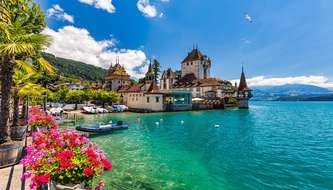
Les meilleurs 20 des choses à faire en Suisse pendant vos vacances en Europe en 2024
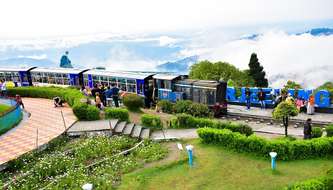
2024 में 20 दार्जिलिंग में करने योग्य चीजें जो आपको किसी भी यात्रा गाइड में नहीं मिलेंगी!
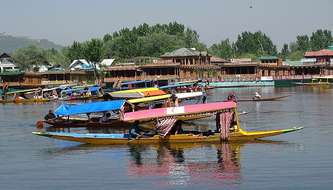
पृथ्वी पर इस स्वर्ग का सर्वश्रेष्ठ देखने के लिए 2023 में 23 कश्मीर में करने योग्य चीजें!
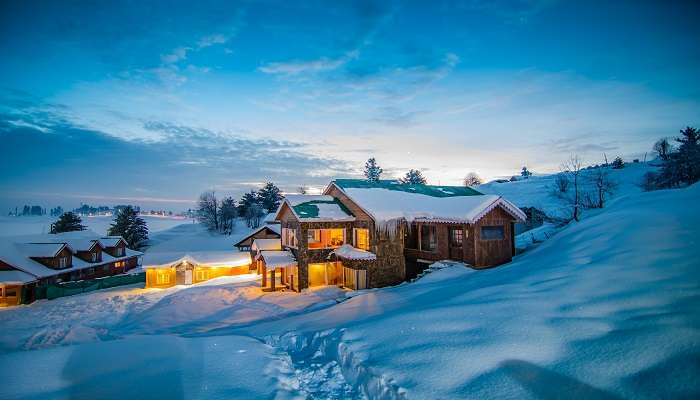
15 श्रीनगर में करने योग्य चीज़ें जो आपको कश्मीरी आकर्षण से प्यार करने पर मजबूर कर देंगी
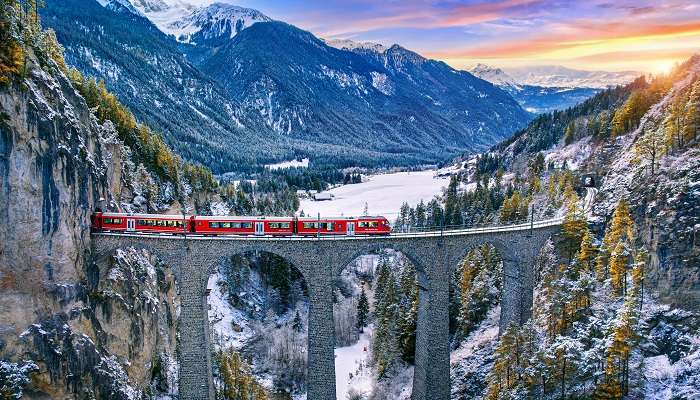
La Suisse en juin: pour une expérience de voyage merveilleuse au milieu des sereines Alpes suisses en 2024.

11 Spectacular Bucket List Ideas For Couples
Trending Blogs

20 Mysterious Places In India To Visit In 2023 More Bizarre Than The Bermuda Triangle

10 Scariest Roads In India That Are A Driver’s Nightmare

101 Places To Visit In India Before You Turn 30 in 2024

35 Exotic Places To Visit In December In India 2024 To Enjoy A Surreal Vacation

60 Best Honeymoon Destinations In India In 2024

95 Best Honeymoon Destinations In The World In 2023 For A Romantic Escape!
Best Places To Visit In India By Month
Best places to visit outside india by month.
- TravelTriangle
- Varanasi »
- Tour Packages
- Honeymoon Packages
- Family Packages
- Budget Tour Packages
- Luxury Tour Packages
- Adventure Tour Packages
- Group Tour Packages
- Kerala Tour Packages
- Goa Tour Packages
- Andaman Tour Packages
- Sikkim Tour Packages
- Himachal Tour Packages
- Uttarakhand Tour Packages
- Rajasthan Tour Packages
- Tour Packages From Delhi
- Tour Packages From Mumbai
- Tour Packages From Bangalore
- Tour Packages From Chennai
- Tour Packages From Kolkata
- Tour Packages From Hyderabad
- Tour Packages From Ahmedabad
- Kerala Tourism
- Goa Tourism
- Sikkim Tourism
- Andaman Tourism
- Himachal Tourism
- Uttarakhand Tourism
- Rajasthan Tourism
- Hotels in Kerala
- Hotels in Goa
- Hotels in Sikkim
- Hotels in Andaman
- Hotels in Himachal
- Hotels in Uttarakhand
- Hotels in Rajasthan

Be back soon!
This website is under maintenance. Check back tomorrow!
*If you’re the owner of this website and have questions, reach out to Bluehost. We’re happy to help.
🗓 Best Time To Visit: October to March
⏰ Open Hours: 6:00 AM to 7:00 PM
🧭 Distances: From Varanasi railway station - 10 km, From Lal Bahadur Shastri International Airport - 24 km
💰 Budget/Entry Fee: Indians - INR 30, Foreigners - INR 500
🏞 Known For: Buddhist historical sites, Dhamek Stupa, Chaukhandi Stupa, Ashoka Pillar, Deer Park
👥 Traveller Types: Historians, Spiritual seekers, Solo travellers, Families
🚩 Things To Do: Visit Buddhist temples, Explore archaeological museum, Meditation, Attend Buddhist teachings
🍽 Nearby Eateries: Green Hut Restaurant, Vaishali Restaurant
🏨 Nearby Stays: Hotel Sarnath, Pinnacle Hotel
👝 Shopping: Local market for Buddhist artifacts, religious items and local handicrafts
🎗 Tips: Respect religious customs, Dress modestly, Photography is prohibited inside the museum
Are you looking for a spiritual and cultural getaway that will enrich your mind and soul? Do you want to explore the ancient and sacred history of one of the world's oldest religions? Do you want to witness the stunning and diverse architecture and art of different Buddhist traditions? If you answered yes to any of these questions, then Sarnath is the perfect destination for you.
Sarnath is a small town near Varanasi in Uttar Pradesh, India, where the Buddha gave his first sermon and taught the Four Noble Truths and the Eightfold Path to his five disciples. It is one of the four most important Buddhist pilgrimage destinations in the world, along with Bodh Gaya, Lumbini, and Kushinagar. Sarnath is also home to some of the most remarkable and impressive monuments and museums that showcase the rich and glorious heritage of Buddhism and India.
In this article, you will learn everything you need to know about Sarnath, including its history, significance, attractions, and activities. You will also find practical information on how to visit Sarnanath, when to go, where to stay, and what else to do in and around Sarnath. Whether you are a devout Buddhist, a curious traveler, or a history buff, Sarnath will offer you an unforgettable and enlightening experience.
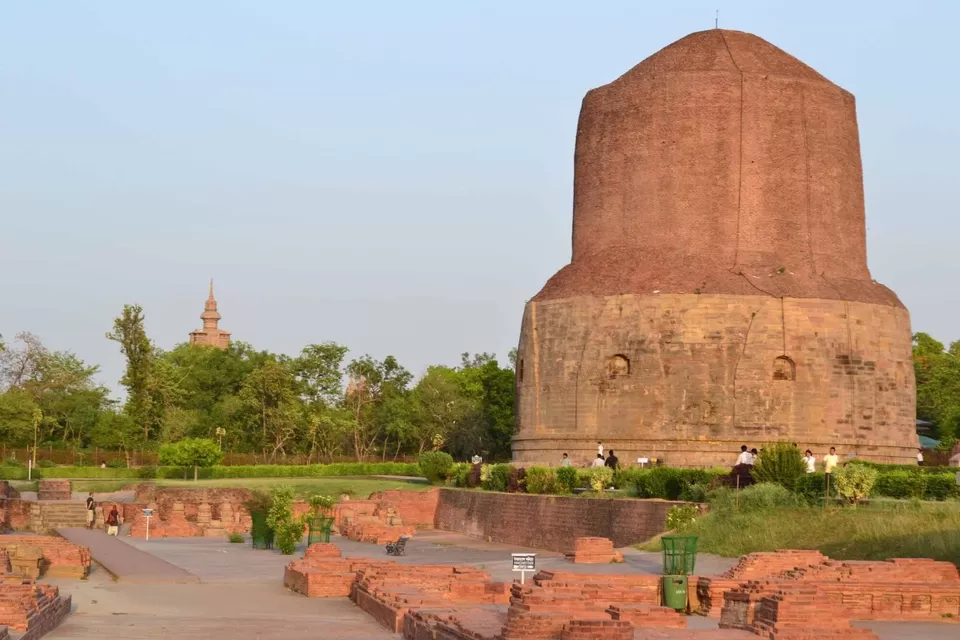
History of Sarnath
The name Sarnath comes from Saranganath, which means "the Lord of the Deer". According to legend, the Buddha was a deer in one of his previous lives, and he saved the life of a doe by offering himself to a king who was hunting. The king was moved by the Buddha's compassion and granted him the deer park in Sarnath, where he later preached his first sermon.
Sarnath is also associated with Jainism and Hinduism, as it is believed to be the birthplace of Shreyansanath, the eleventh Jain Tirthankara, and the site of a Shiva temple called Mrigadava.
However, Sarnath is most famous for its connection to Buddhism, as it is the place where the Buddha set in motion the Wheel of Dharma, or the law of universal truth, after attaining enlightenment in Bodh Gaya. He delivered his first sermon, known as the Dhammacakkappavattana Sutta, to his five disciples, who became the first monks of the Sangha, or the Buddhist community.
Sarnath soon became a center of Buddhist learning and art, attracting thousands of pilgrims and scholars from all over the world. Emperor Ashoka, who converted to Buddhism after witnessing the horrors of war, built several stupas, monasteries, and pillars in Sarnath to commemorate and propagate the Buddha's teachings. The most famous of these is the Ashoka Pillar, which bears the lion capital, the national emblem of India.
Sarnath reached its peak of glory and prosperity between the 3rd century BCE and the 12th century CE, when it was adorned with magnificent structures and sculptures by various rulers and dynasties. However, Sarnath also faced several invasions and destructions, especially by the Muslim armies of Mahmud of Ghazni and Qutb-ud-din Aibak, who plundered and razed the Buddhist monuments and monasteries.
Sarnath remained in ruins and obscurity until the 19th century, when it was rediscovered and excavated by British archaeologists, who unearthed the remnants of the ancient and splendid civilization. Sarnath also played a role in the revival of Buddhism in India, as it was the venue of the fifth Buddhist council in 1904, and the place where the Dalai Lama gave his first sermon in India in 1956.
Today, Sarnath is a UNESCO World Heritage Site , and a testimony to the enduring and inspiring legacy of Buddhism and India.
How to Visit Sarnath
Sarnath is located about 10 km from Varanasi, the holy city of Hindus and one of the oldest cities in the world. You can easily reach Sarnath from Varanasi by train, bus, taxi, or auto-rickshaw. The nearest railway station is Sarnath Railway Station, which is about 2 km from the main attractions. The nearest airport is Lal Bahadur Shastri International Airport in Varanasi, which is about 25 km from Sarnath.
The best time to visit Sarnath is between October and March , when the weather is pleasant and cool, and the festivals of Buddha Purnima, Dhamma Chakra Pravartan Day, and Tibetan New Year are celebrated with great fervor and devotion. You can also visit Sarnath during the monsoon season, between July and September, when the landscape is lush and green, and the crowds are less. However, avoid visiting Sarnath during the summer season, between April and June, when the temperature can soar up to 45°C, and the heat and humidity are unbearable.
Sarnath offers a range of accommodation and dining options to suit your budget and preference. You can choose from luxury hotels, heritage resorts, guest houses, hostels, and homestays, depending on your comfort and convenience. Some of the best places to stay in Sarnath are the Gateway Hotel Ganges, the Clarks Varanasi, the Hotel Surya, and the International Guest House. You can also find many restaurants, cafes, and street stalls that serve delicious and authentic Indian, Chinese, Tibetan, and Thai cuisine, as well as vegetarian and vegan options. Some of the best places to eat in Sarnath are the Lemon Grass Restaurant, the Aum Cafe, the Ming Garden, and the Brown Bread Bakery.
The entrance fee for the archaeological site and museum in Sarnath is Rs. 30 for Indians and Rs. 500 for foreigners. The timings are from 6 am to 6 pm for the archaeological site, and from 9 am to 5 pm for the museum , except on Fridays. You can also hire a guide or an audio guide for a nominal charge, or join a group tour or activity for a more immersive and interactive experience. While visiting Sarnath, make sure to respect the religious and cultural sentiments of the locals and the pilgrims, and dress modestly and appropriately. Also, do not litter or damage the monuments and the environment, and follow the rules and regulations of the authorities.
What to See in Sarnath
Sarnath is a treasure trove of attractions that will mesmerize and enlighten you with their beauty and significance. Here are some of the must-see attractions in Sarnath that you should not miss:
Dhamekh Stupa
The Dhamekh Stupa is the most prominent and impressive monument in Sarnath, and the place where the Buddha gave his first sermon. It is a massive cylindrical structure, about 43 meters high and 28 meters in diameter, made of bricks and stones, and decorated with exquisite carvings of floral and geometric patterns. The stupa was built by Ashoka in the 3rd century BCE, and later enlarged and renovated by other rulers. The stupa is surrounded by a lush and serene garden, where you can meditate and contemplate the teachings of the Buddha.
Ashoka Pillar
The Ashoka Pillar is another landmark of Sarnath, and a symbol of India's ancient and glorious civilization. It is a stone column, about 15 meters high, erected by Ashoka in the 3rd century BCE, and inscribed with his edicts and messages of peace and dharma. The pillar also bears the famous lion capital, which consists of four lions facing the four cardinal directions, standing on a circular base with four animals and a wheel. The lion capital is the national emblem of India, and the wheel is the representation of the Dharma Chakra, or the Wheel of Law.
Archaeological Museum
The Archaeological Museum is a must-visit for anyone interested in the history and art of Sarnath and Buddhism. It is one of the oldest and finest museums in India, established in 1904, and housed in a beautiful building designed by James Ransome. The museum displays a remarkable collection of sculptures, relics, coins, inscriptions, and artifacts that were excavated from the archaeological site of Sarnath. The museum has five galleries, each dedicated to a different period and theme, such as the Mauryan, the Sunga, the Kushana, the Gupta, and the Later Periods. The museum also has a library and a publication section, where you can find more information and resources on Sarnath and Buddhism.
The highlight of the museum is the original lion capital of the Ashoka Pillar, which is kept in a glass case in the central hall. The lion capital is a masterpiece of Indian art and sculpture, and a testimony to the skill and craftsmanship of the ancient artists. The museum also showcases some of the most famous and exquisite sculptures of Sarnath, such as the Buddha in Dharmachakra Pravartana Mudra, the Buddha in Abhaya Mudra, the Buddha in Bhumisparsha Mudra, the Bodhisattva Padmapani, and the Chakreshwara Jataka.
Thai Temple
The Thai Temple is one of the most beautiful and serene attractions in Sarnath, and a reflection of the diversity and harmony of the Buddhist traditions. It is a modern temple, built in 1933, and designed in the typical Thai style, with a sloping roof, golden spires, and colorful decorations. The temple is surrounded by a well-maintained garden, where you can relax and enjoy the tranquility and freshness of the environment. The main attraction of the temple is the large and majestic statue of the Buddha, made of bronze and gold, and sitting in a lotus posture. The temple also has a library, a meditation hall, and a school, where you can learn more about the Thai culture and Buddhism.
Mulagandha Kuti Vihar
The Mulagandha Kuti Vihar is another modern temple in Sarnath, built in 1931 by the Mahabodhi Society of India, and designed by a French architect. It is located at the site where the Buddha used to meditate and deliver his sermons, and where the original Mulagandha Kuti, or the Fragrant Hut, once stood. The temple is a splendid example of Indo-Japanese fusion, with a red brick exterior, a conical roof, and a golden spire. The temple is adorned with exquisite murals and frescoes, painted by a Japanese artist, depicting the life and teachings of the Buddha. The temple also houses a golden statue of the Buddha, a relic of the Buddha's bones, and a Bodhi tree, which is a descendant of the original tree under which the Buddha attained enlightenment.
One of the most popular and enchanting activities to do in Sarnath is to attend the evening prayer at the Mulagandha Kuti Vihar, which takes place every day at 6 pm. You can join the monks and the devotees in chanting the hymns and mantras, and experience the peace and bliss of the divine atmosphere. You can also witness the spectacular sight of the temple illuminated by hundreds of lamps and candles, creating a magical and mesmerizing effect.
Chaukhandi Stupa
The Chaukhandi Stupa is one of the oldest and most mysterious monuments in Sarnath, and the place where the Buddha met his five disciples for the first time. It is a square-shaped structure, made of bricks and stones, and topped by an octagonal tower, which was added by the Mughal emperor Akbar in the 16th century. The stupa is surrounded by a high wall, which has four gates, each facing a different direction. The stupa is also decorated with various carvings and inscriptions, some of which date back to the 5th century CE. The stupa is believed to have some supernatural powers, and is revered by the locals and the pilgrims alike.
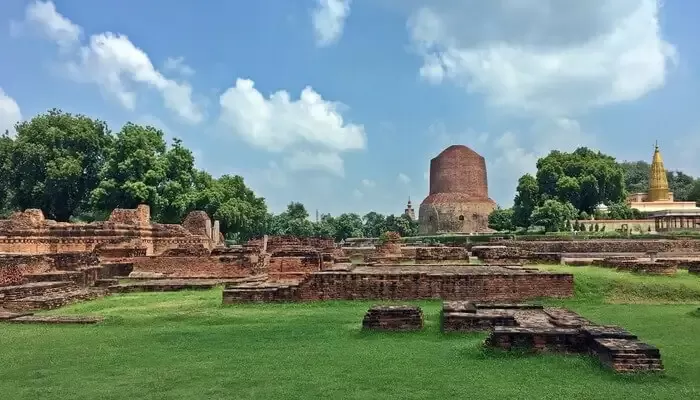
What Else to Do in Sarnath
Sarnath is not only a place to see, but also a place to do. There are many other activities and experiences that Sarnath offers to visitors, that will make your trip more memorable and enjoyable. Here are some of the other things to do in Sarnath that you should try:
Visit the Deer Park
The Deer Park is a natural and serene sanctuary, located next to the archaeological site of Sarnath, where you can see and interact with the gentle and graceful deer, who are considered sacred in Buddhism. The deer park is also a great place to relax and enjoy the greenery and freshness of the environment, and to spot some of the other wildlife, such as peacocks, monkeys, and birds. The deer park also has a small zoo, a children's park, and a cafeteria, where you can have some fun and refreshment.
Take a Day Trip to Chunar Fort or Vindhyachal
If you have some extra time and want to explore some of the other places near Sarnath, you can take a day trip to Chunar Fort or Vindhyachal, which are both about 40 km from Sarnath. Chunar Fort is a historical and architectural marvel, built on a rocky hill overlooking the Ganga river, and dating back to the 11th century CE. The fort has witnessed many battles and changes of hands, and has many legends and stories associated with it. The fort also offers a panoramic view of the river and the countryside, and has a museum, a temple, and a garden within its premises.
Vindhyachal is a religious and cultural town, famous for its temples dedicated to Goddess Vindhyavasini, who is believed to be an incarnation of Durga, the supreme mother goddess in Hinduism. The town is also a center of Tantra, a mystical and esoteric branch of Hinduism, and has many shrines and rituals related to it. The town also hosts a grand fair during the Navratri festival, which attracts thousands of devotees and tourists.
Sarnath is a place that will inspire and enlighten you with its history, culture, and spirituality. It is a place that will connect you with the Buddha, his teachings, and his followers, and with yourself. It is a place that will offer you an unforgettable and enriching experience, that you will cherish for a lifetime.
Sarnath Reviews

Places To Visit In Varanasi
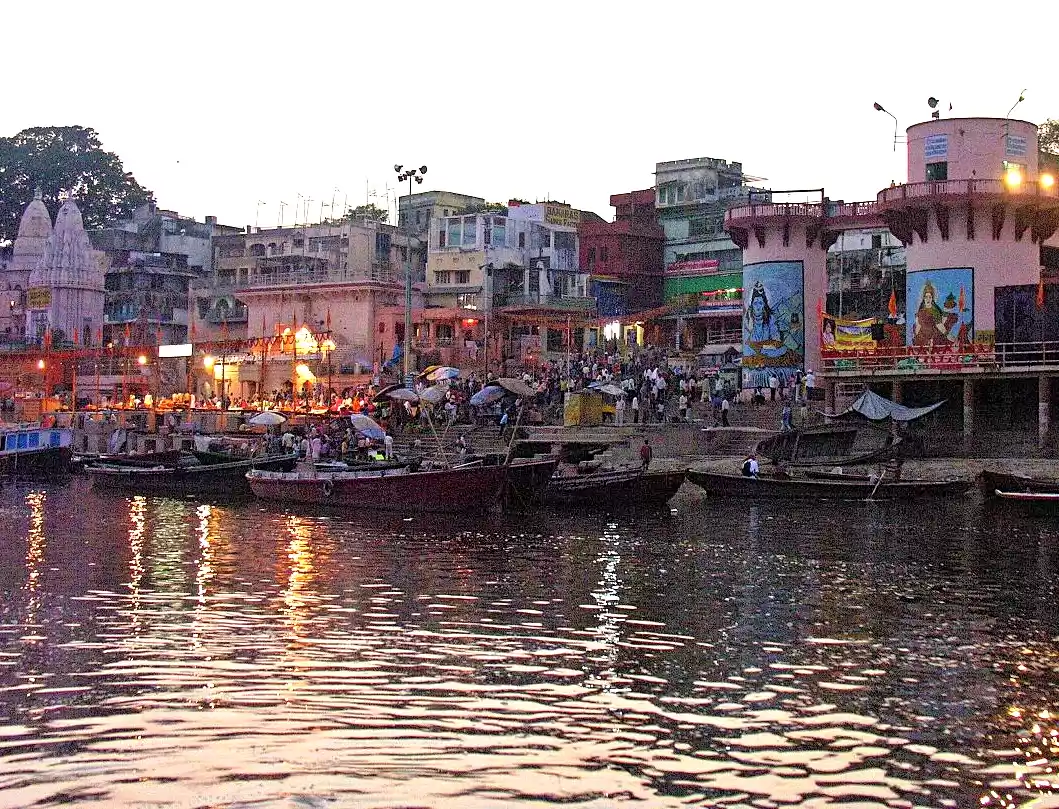
Travel Blogs for Sarnath
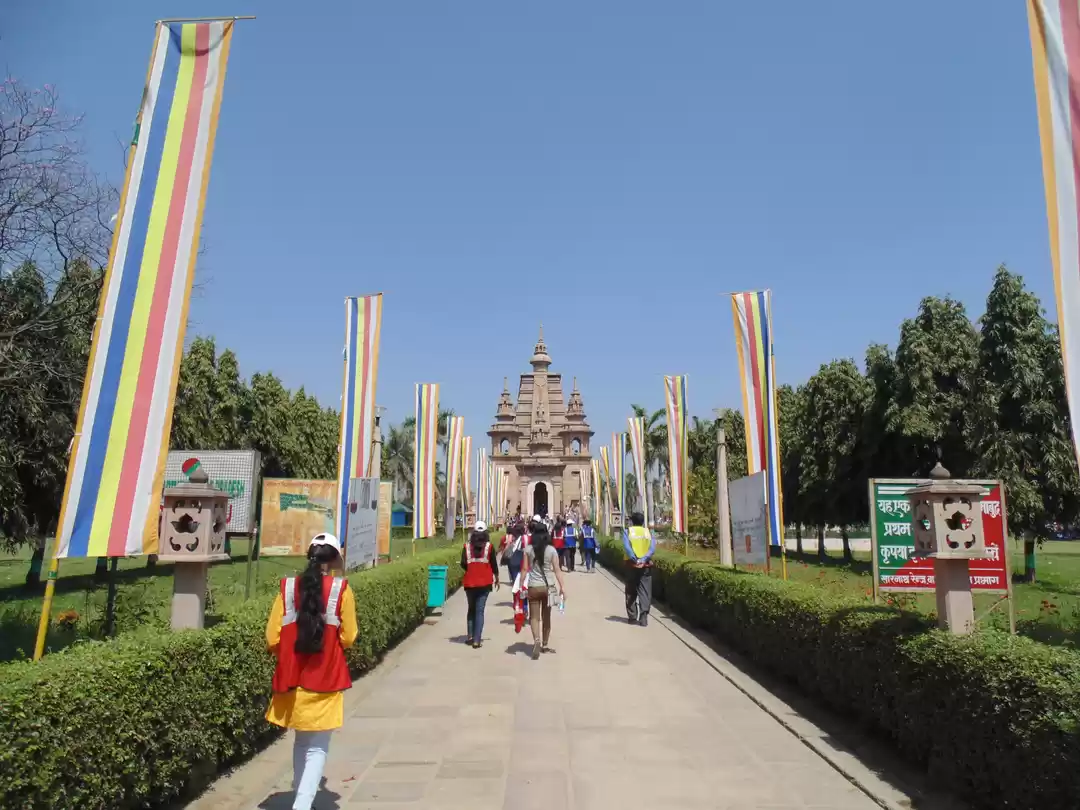
- 1 Understand
- 2.1 By plane
- 2.2 By train
- 2.4 By taxi/rickshaw
- 3 Get around
- 4.1 Historical sites
- 4.2 Active religious sites
- 4.3 Museums
- 8.2 Mid-range
- 8.3 Splurge
Sarnath is a small village in Uttar Pradesh , India , about 13 km north-east of Varanasi . It's famous as the site of the deer park where Gautama Buddha first taught the Dharma and also where the original Sangha was formed. Consequently, it is one of the 4 main Buddhist pilgrimage destinations .

Within the deer park complex is the large Dhamekha Stupa, constructed by the Emperor Ashoka in 249 BCE, and several other Buddhist structures that were added between the 3rd century BCE and the 11th century CE. The town is relatively peaceful and green, and provides a welcome accommodation alternative to those wishing to visit Varanasi but not be immersed in it 24 hours a day.
Understand [ edit ]
Sarnath along with Lumbini , Bodh Gaya and Kushinagar are places directly involved with the life of Buddha and are part of the Buddhist Circuit . Lumbini was the place of his birth, while Kushinagar was the place of his death. Buddha attained enlightenment at Bodh Gaya and preached his first sermon at Sarnath. Sarnath is located just 10 km from Varanasi and is best explored in a day trip.
Get in [ edit ]

Sarnath is best accessible from Varanasi which is located just 10 km away. Airports, major railway stations and bus terminus are all located in Varanasi. Autos and taxis are readily available from the Varanasi Junction station and bus terminus.
By plane [ edit ]
Lal Bahadur Shastri Airport ( VNS IATA ) is 24 km from Sarnath and is the nearest airport.
By train [ edit ]
The nearest major station is Varanasi Junction (6 km), which is connected to most major cities in the country. Sarnath does have a small 25.375998 83.032634 1 railway station with local trains from Varanasi serving every 2-3 hours, but most trains terminate in Varanasi City (instead of Varanasi Junction) station. A few express trains also stop here.
By bus [ edit ]
Local bus No107E departs from near Varanasi Cantt train station (coordinates: 25°19.74981'N, 82°59.36062'E), and costs ₹25 (2023) to Sarnath
By taxi/rickshaw [ edit ]
The town is easily reached by taxi or auto rickshaw from Varanasi. If you're non-Indian and arriving in Varanasi by train, a taxi driver will probably descend on you before you leave your train platform. Make no commitment there! You can negotiate a better rate with an autorickshaw driver, outside the station. If you have tons of luggage though, go with the taxi -- it won't fit in the rickshaw. The route, though once somewhat rural, is now noisy, busy, and almost completely built up till you're on the road just outside Sarnath. Rates from ghat area of Varanasi (Approx one hour journey) : Auto - ₹400 one way - ₹700 return, including an hour waiting time. Taxi - over ₹1,500 for a return journey, including one hour waiting time. (Updated April 2023.)
Get around [ edit ]
The tourist attractions of Sarnath a spread over a small area and can be very well covered on foot. However, for people who don't want to walk much there are autos. The autos have no fixed fare and routes. So, before you hop in confirm the route and the price. Also, prices are subjected to heavy bargaining.
See [ edit ]

Historical sites [ edit ]
There is a ₹300 fee for non-Indians to enter the site that houses the Damekh Stupa, stupa relics, and Ashoka Pillar. The ticket office is on the left, next to the main gate.
- 25.381491 83.022723 1 Ashoka Pillar . Only the base remains. The base of the pillar has been enclosed in a glass enclosure. The lion capital, which topped the pillar has been displayed at the nearby site museum.
- 25.381438 83.022979 3 Mulagandhakuti Vihara . The ruins of the temple where the Buddha spent his first rainy season.
- 25.381008 83.022897 4 Dharmarajika Stupa . Dharmarajika Stupa dates back to the time of Ashoka. Sadly it is in complete ruins and only its base remains. ( updated Apr 2023 )
Active religious sites [ edit ]
Apart from the historical sites related to Buddhism, Sarnath houses several active Buddhist temples managed by several Buddhist trusts in India and abroad. Sarnath has temples from majority of the Buddhist countries, which includes - China , Japan , Thailand , Myanmar and even Tibet .
- 25.379785 83.028365 6 Chinese Buddhist Temple . ( updated Apr 2023 )
- 25.377161 83.026471 7 Tibetan Buddhist Temple . ( updated Apr 2023 )
- 25.376958 83.028601 8 Japanese Buddhist Temple . ( updated Apr 2023 )
- 25.378309 83.021779 9 Thai Buddhist Temple . A standing Buddha statue, 24.3 metres (80 feet) in height, inspired by the Bamiyan Buddha is located inside the temple complex. ( updated Apr 2023 )
- 25.376577 83.028949 10 Vishwa Shanti Stupa . ( updated Apr 2023 )
- 25.380721 83.026626 11 Mulagandha Kuti Vihara . ( updated Apr 2023 )
- 25.379642 83.026158 12 Maha Bodhi Temple . ( updated Apr 2023 )
- 25.376425 83.023578 13 Shechen Stupa . ( updated Apr 2023 )
- 25.377695 83.024 14 Padma Samye Chokhor Ling Monastery . ( updated Apr 2023 )
- 25.380511 83.02386 15 Sri Digamber Jain Temple , Dharmapala Rd . A Temple near Dhamekh Stupa. Accessible by main road that runs along Dhamekh Stupa. Learn about Digambara monasticism, a branch of Jain Dharma.
Museums [ edit ]
Do [ edit ], buy [ edit ].
- Stone carved Buddhas - a specialty of Sarnath. Available at stalls near the entrance to Deer Park.
Eat [ edit ]
- Holiday Inn , Main road ( opposite Mahabodhi Temple entrance ). 11AM-6PM . One of 2-3 restaurants in Sarnath. Good food and reasonable prices. Opening hours limited and closed for holidays, weddings, funerals etc.
Sleep [ edit ]
Budget [ edit ].
- Jain Paying Guest House . Cheap and spartan, but with great family hospitality. ₹300 per night, possibility of eating breakfast and lunch with the family (and Buddhist guests passing by).
- Mahabodi Dharmshala Temple , Thai Temple and the Burmese Temple . All of these temples offer very cheap but spartan accommodation.
- 25.378152 83.027492 1 UPSTDC Rahi Tourist Bungalow , Sarnath Station Rd, Ashok Rd crossroad, Baraipur ( Near Maha Bodhi Inter College ), ☏ +91 542 2595969 , fax : +91 (0542) 259-5379 . A government-run establishment: drab and uninspiring, but conveniently located.
- 25.3791 83.0294 2 Chinese Temple , ☏ +91 5422595280 . This temple is nearby the main areas of visit, around 5-10 mins walk to Dhamekh Stupa. Offers small room or big bunk room, depending on availability. Costs ₹200-300 per bed or room. Clean and simple stay. ( updated Aug 2016 )
Mid-range [ edit ]
- 25.374335 83.028019 3 The Golden Buddha Hotel ( Golden Buddha Marriage Lawn ), Sarangnath Colony , ☏ +91-993-503-9368 , +91 98074 74018 . Probably the best hotel in town. Offers such facilities as Ayurvedic massage, a restaurant serving fresh Indian dishes, a peaceful lawn, and outdoor hot tub. Special rates for backpacking groups. Its walking distance from the main temple. The hotel can arrange a taxi to pick you up from the train station or airport. ₹400-1200 .
Splurge [ edit ]
Respect [ edit ].
In the vicinity of sacred sites :
- Wear clothing that expresses respect for the sacred nature of the site.
- Circumambulate the stupa and other sacred objects in a clock-wise direction.
- Preserve the peace and tranquility.
- Do not climb onto statues or other sacred objects.
Connect [ edit ]
Go next [ edit ].
- Varanasi - one hour to ghat area (One way - auto: around ₹350, taxi: ₹750).
- Has custom banner
- Has mapframe
- Has map markers
- Eat listing with no coordinates
- See listing with no coordinates
- Has Geo parameter
- All destination articles
- Outline cities
- Outline articles
- City articles
- Pages with maps
Navigation menu
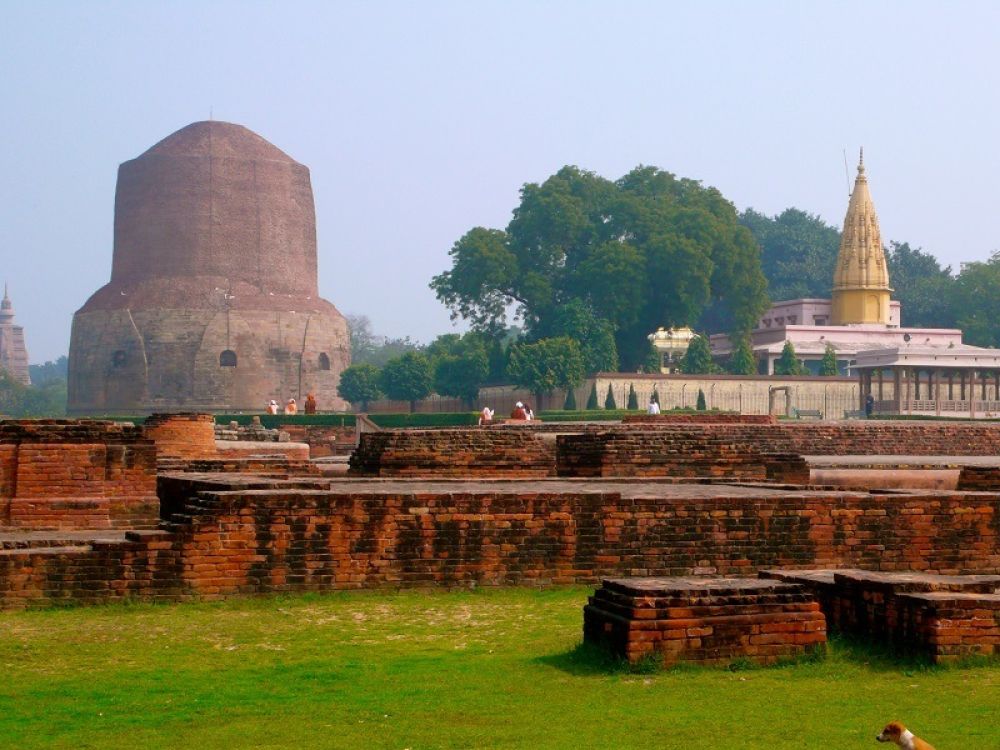
Places To Visit In Sarnath
- Dhamek Stupa
- Chaukhandi Stupa
- Sarnath Museum
- The Ashoka Pillar
- Mulagandha Kuti Vihar
- Tibetan Temple
- Deer Park (Rishi Park)
- Thai Temple
- Japanese Temple Sarnath
- View all 9 places
- Things to do
- Best time to visit
- How to Reach
- Tourist Map
- within 25kms
- within 50kms
- within 100kms
- within 150kms
- within 200kms
- within 250kms
- within 300kms
- within 500kms
Top 9 Places to Visit in Sarnath
Table of contents.
Places to Visit in Sarnath
- 1. Dhamek Stupa
- 2. Chaukhandi Stupa
- 3. Sarnath Museum
- 4. The Ashoka Pillar
- 5. Mulagandha Kuti Vihar
- 6. Tibetan Temple
- 7. Deer Park (Rishi Park)
- 8. Thai Temple
- 9. Japanese Temple Sarnath
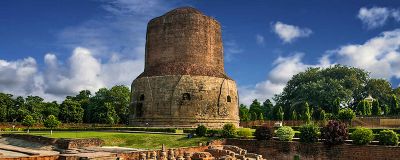
Explore Places to Visit Near Sarnath by Type
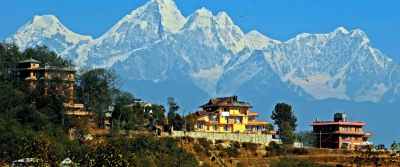
Other Suggested Reads for Sarnath
- About Sarnath Tourism
- Things to do in Sarnath
- How to Reach Sarnath
- Best time to Visit in Sarnath
- Sarnath Tourism History
- Food in Sarnath
- FAQS about Sarnath
- Sarnath Tourist Map
- Tour Enquiry
- Sign up | Login
- My Bookings
- New User? Sign-up
- Domestic Tours
- South India
- Maharashtra
- Golden Triangle
- North India
- North East India
- International
- Maldives (Discontinued)
- All Domestic Tours
- All International Tours
- Offbeat Tours
- Domestic Cruise Tours
- Jungle Lodges by JLR
- Kabini River Lodge
- Bandipur Safari Lodge
- JLR Kings Sanctuary
- River Tern Lodge
- Kali Adventure Camp
- Hampi Heritage & Wilderness Resort
- K Gudi Wilderness Camp
- Car Rentals
- Destinations
- Tourist Places on Drive
- Driving Directions
- * Workation
- * Tour Plans
- List Property
Please wait... the destination details are being loaded
- Uttar Pradesh
Places to Visit in Varanasi
India | Uttar Pradesh | Varanasi
#10 of 29 places to visit in varanasi, distance (from varanasi): 9 kms, visited from: varanasi, trip duration (including travel): 4 hours/half day, place location: not available, transportation options: cab / auto, website: na, phone no: na, place address: na, travel tips: none.
At a distance of 9 km from Varanasi Junction, Sarnath is a revered Buddhist pilgrimage center located near the confluence of Ganga and Varuna Rivers in Uttar Pradesh. It is one of the popular Buddhist pilgrimage sites in India and also one of the must visit Varanasi Tourist Places. Also known as Ishipatna and Mrigadaya, Sarnath is one of the four most important Buddhist pilgrimage centers of India, the other three are Lumbini, Bodh Gaya and Kushinagar. According to the legend, Lord Buddha after attaining enlightenment at Bodh Gaya came to Sarnath and delivered his first sermon to his five disciples. It is also the place where the original Sangha was formed and a new order of religious doctrine (Dhamma) was laid. Sarnath is also sacred to the Jains as it is the site of asceticism and death of Shreyamshanath, the 11th Trithankara. The great emperor Ashoka visited the holy land around 234 BC and constructed a Stupa. During the Golden Age of Gupta King Chandragupta II (376-414 AD), Sarnath developed as a flourishing center of art and culture. This prosperity continued till 1017 AD, when Mahmood Gajni began plunder and destruction of all monuments in Sarnath. These monuments were extensively plundered for building materials and have been in ruins since then, until Angarik Dharampal, a Srilankan Buddhist disciple restored the ruins. There are many Buddhist monuments and edifices in Sarnath. Some of the important Buddhist monuments at Sarnath are the Dhamekha Stupa, the Chaukhandi Stupa, monasteries and temples. The Dhamekha Stupa is the best preserved and most impressive edifice at Sarnath. Standing tall with a height of 128 feet, this is the spot where the Buddha is said to have preached his first sermon. Tourists can also visit the nearby attractions such as Dharmarajika Stupa, Ashoka Pillar and Mulagandhakuti temple. Behind this complex, there is a Deer Park, which is maintained as an open animal park. Sarnath Museum is one of the oldest museums in India, which was created by Sir John Marshall in order to preserve the antiquities that were found from the Sarnath excavation site in 1904. It displays a small collection of artifacts ranging from the 3rd century BC to 12th century AD. The main attraction of the Sarnath Archaeological Museum is the superb Ashokan Pillar. The Chaukhandi Stupa is believed to be the place where Buddha met his first disciple. The stupa was originally built by Ashoka the great after he converted to Buddhism. There are a number of 20th century Buddhist temples in Sarnath. Many of these Buddhist temples at Sarnath are built and maintained by monks from Tibet, China, Sri Lanka and Japan. Tibetan Temple is the most popular place in Sarnath which houses the statue of Shakyamuni, the Buddha. Wat Thai Sarnath temple is one of the well-known temples built by Thai dignitaries in 1933. Museum Timings: 9 AM - 6 PM, Closed on Sunday
10 Must Visit Places in Varanasi
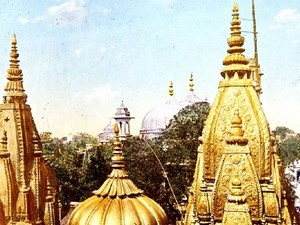
View Details
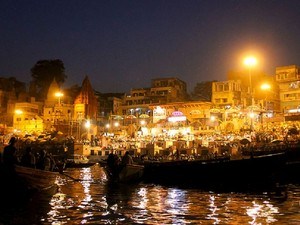
Varanasi Tourism
Varanasi Tour Packages
Best Time to Visit Varanasi
How to Reach Varanasi
Planning a Trip?
Need customized tour request quote.

100% SECURE PAYMENTS
Domestic & international cards accepted.

Our WhatsApp Numbers
International tours, +91-8217845740, south india tours, +91-7995649483, goa, maharashtra, gujarat tours, +91-7032828835, north india tours, +91-9535139583, rest of india, +91-7799591230, request quote, travellers #.
Explore Tour Packages
Discover Affordable Tour Packages
Login / sign-up, your sign in was successful itinerary will be downloaded shortly., sign up with trawell.in.
Already Created Account? Login Here
Sign in with Trawell.in Account
Forgot Password?
New User? Sign Up Here
Activate Your Trawell.in Account
Your account is activated successfully. Login Here
Reset Your Trawell.in Password
Your password has been reset successfully. Login Here
Booking Policy
- Today's deals
- Search travel guides

Places to Visit in Sarnath: The Buddhist Circuit
The mystical region of Sarnath provides visitors the opportunity to explore both the spiritual, cultural and natural heritage of India. Situated along the banks of the Ganges River just north of the bustling streets of Varanasi , Sarnath provides a sanctuary, especially for travelers looking to experience India’s rich traditions. The region also attracts tourists due to its fascinating geography, architecture and history. The architectural heritage of Sarnath is apparent in the many ruins, monasteries, stupas and temples, and the top places to visit in Sarnath include many of these ancient structures. Discover more about why Sarnath is a major site on the Buddhist Circuit, along with the most recommended things to do while in the region.
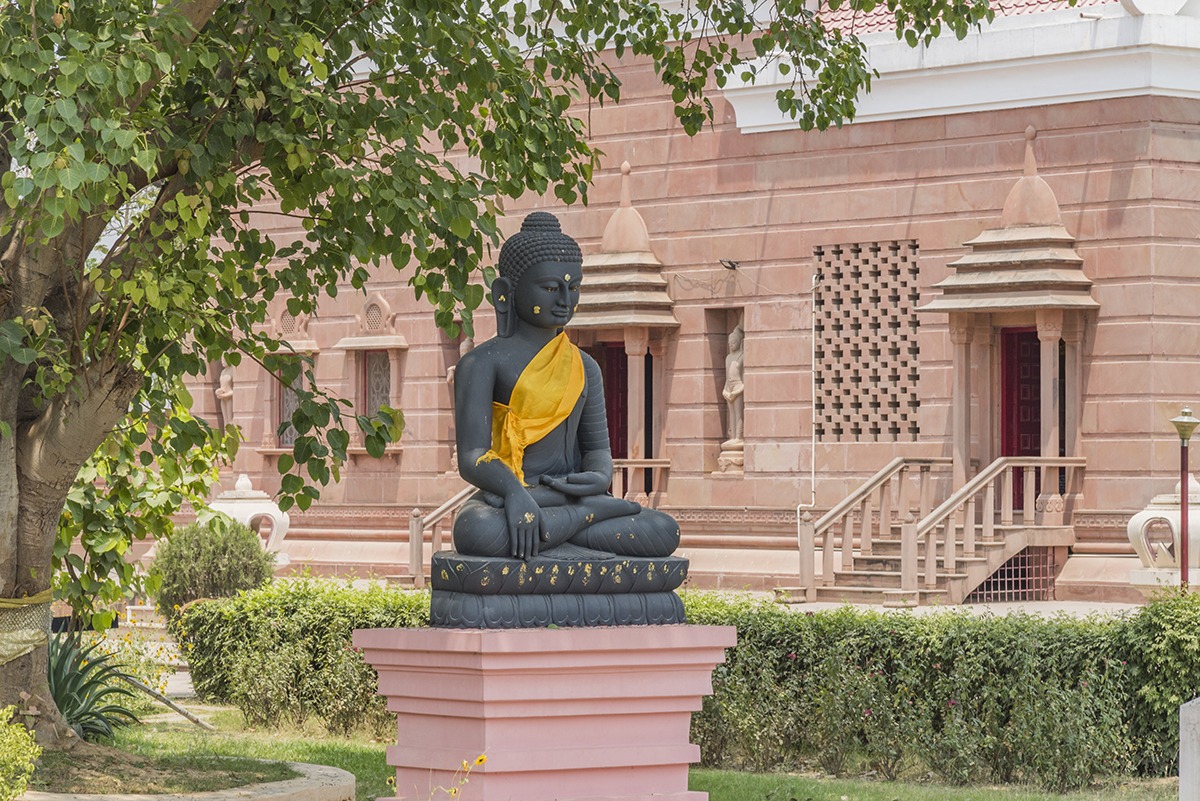
Introduction to Sarnath as Part of the Buddhist Circuit
Known as the place where Buddha delivered his first sermon to his five disciples after attaining enlightenment, Sarnath holds a profound historical and spiritual significance for Buddhists. It is a major site on the Buddhist Circuit and one of the most important Buddhist pilgrimage sites in India. The area contains several ancient structures and artifacts preserved since Buddha traveled through the region. Visitors making pilgrimages will find open meditation spaces and places to reflect on their spirituality, while tourists can admire ancient architecture and soak up the historical energy that Sarnath exudes.
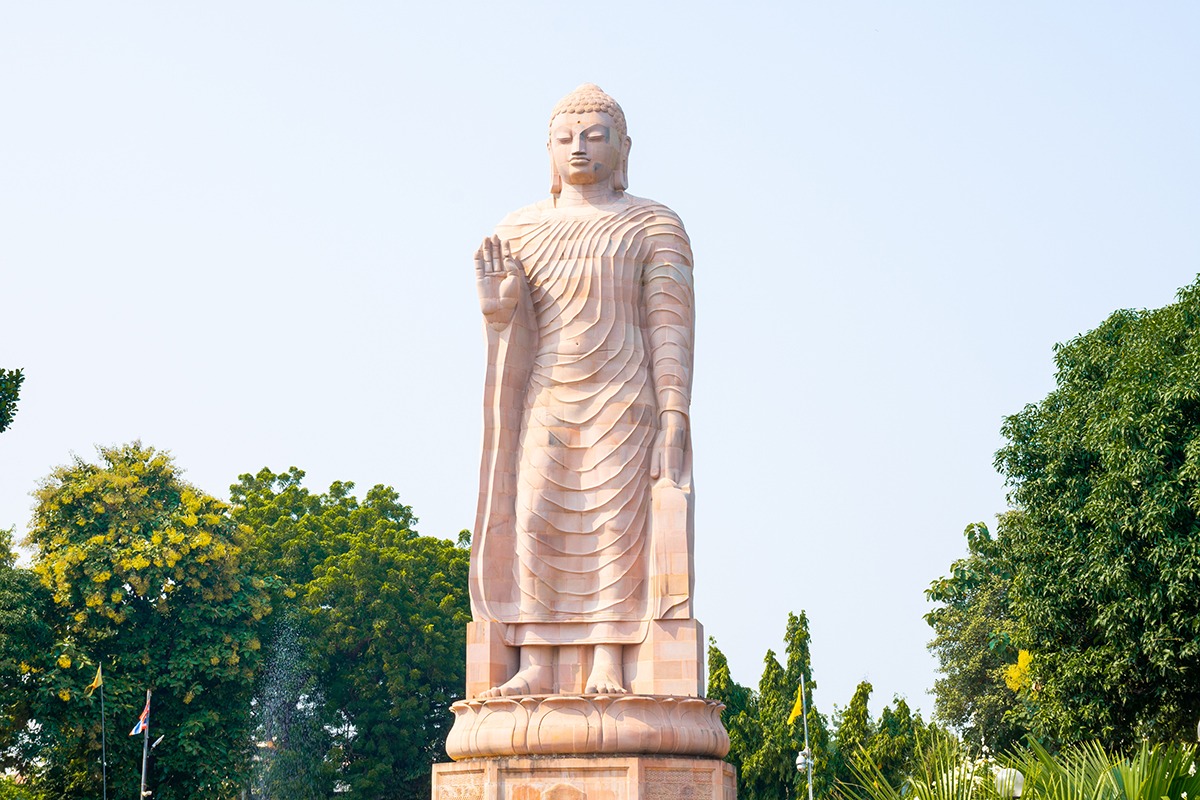
Sarnath Importance and Places to Visit
Sarnath is a treasure trove of historical artifacts. A few must-see places to visit in Sarnath include Dhamekh Stupa, Sarnath Archaeological Museum and Chaukhandi Stupa. Not only do these landmarks feature panoramic views of the landscape, but they also provide insights into Buddhist culture and opportunities for meditation. Exploring ancient ruins of monasteries and stupas adds a historical dimension to a pilgrimage to Sarnath. Together, the following places to visit in Sarnath create an itinerary that is complete with spirituality, culture and history.
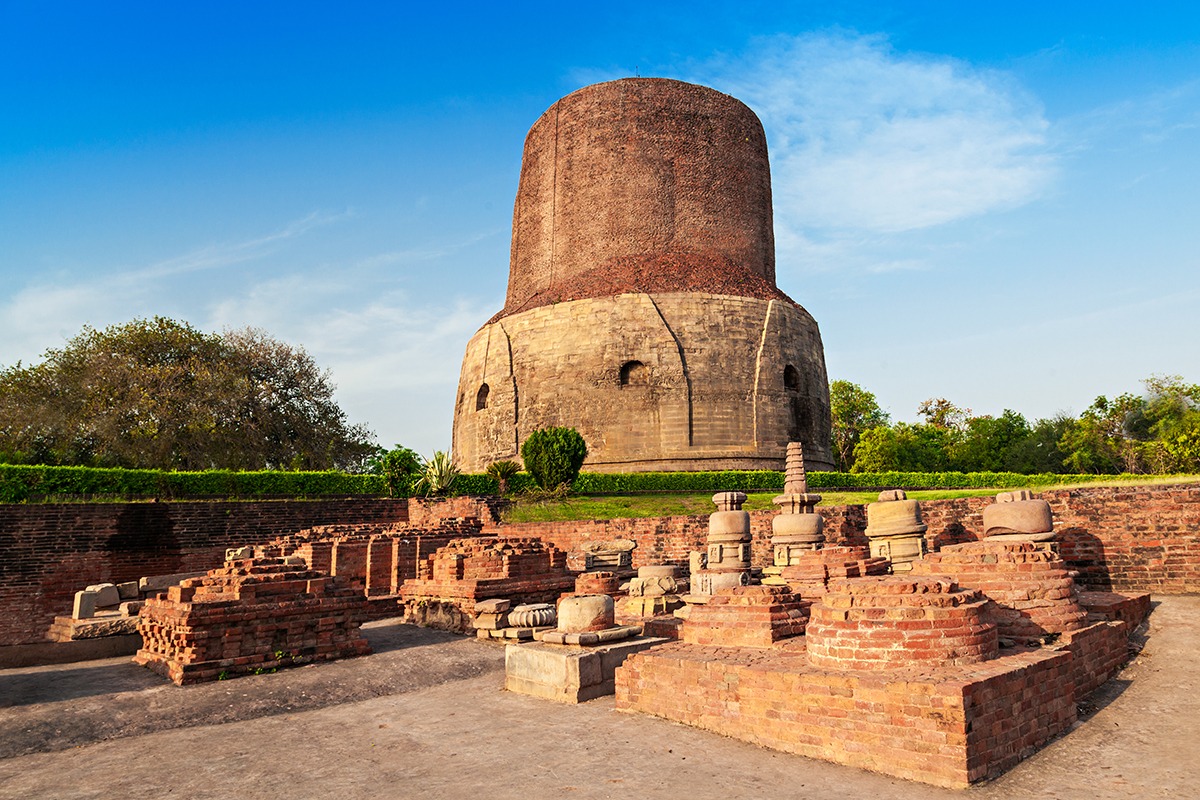
Dhamekh Stupa
The dominant Buddhist landmark in Sarnath, Dhamekh Stupa marks the location where Buddha delivered his first sermon. The event is considered a pivotal point in the development of Buddhism, and the stupa stands as a representation of Lord Buddha’s own transformation. Dhamekh Stupa towers over the region at 143 feet (43.6 meters) and is 92 feet (28 meters) in circumference. The red brick and stone structure is covered in intricate carvings that depict scenes from Buddha’s life. Dhamekh Stupa is a significant pilgrimage site for Buddhists and a major stopping spot on the Buddhist Circuit. Pilgrims pay their respects to Buddha at the stupa by offering prayers and meditating. Buddhist ceremonies and rituals also are conducted at the site, making it a hub of spiritual activity and devotion.
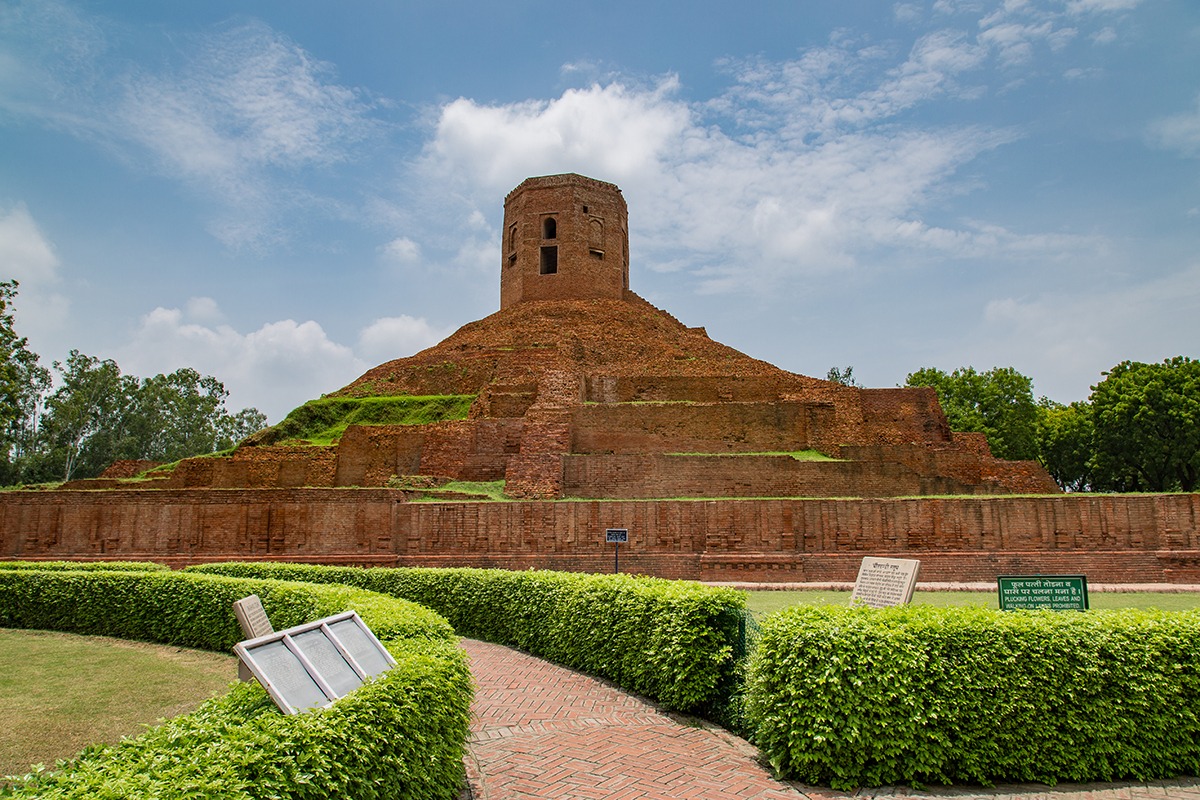
Chaukhandi Stupa
Chaukhandi Stupa is a captivating destination for pilgrims and tourists interested in exploring the roots of Buddhism and the evolution of the region’s culture. Visitors can immerse themselves in the tranquil atmosphere surrounding this ancient monument that represents the place where Buddha met his disciples upon arriving in Sarnath after his enlightenment. It also symbolizes the beginning of Buddha’s teaching of the Dharma, or the Four Noble Truths of Buddhism. The stupa’s distinctive architectural style of both Buddhist and Islamic elements sets it apart from other landmark structures in the region. The monument, built in the fifth century, symbolizes the evolution of art and culture that took place in Sarnath following Buddha’s presence. Visitors are welcome to climb the stupa to enjoy a panoramic view of Sarnath’s lush landscape and the Ganges River.
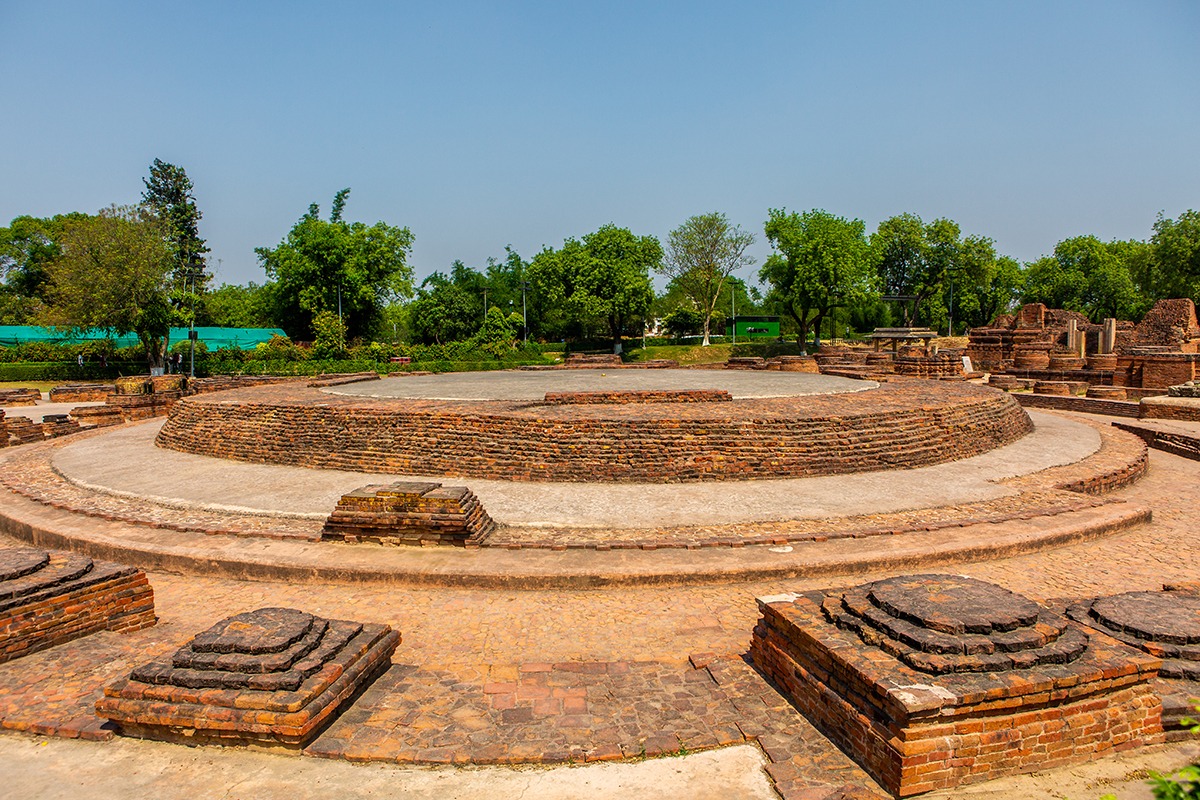
Dharmarajika Stupa
The Dharmarajika Stupa, also known as the Dharmarajika Buddhist Stupa, is a one of Sarnath’s most significant ancient landmarks. The stupa dates to the third century and is believed to contain relics of Buddha after his cremation. The foundation was laid by King Ashoka, a prominent promoter and supporter of Buddhism. The circular stone and brick frame followed traditional architecture of the time, featuring a square base and dome on top. While the stupa is largely in ruins, even after several renovations and complete reconstructions, it is believed to have stood much taller than its present height. Only remnants of the original stone railing that once surrounded the stupa remain. The Dharmarajika Stupa is part of the Archaeological Buddhist Remains of Sarnath and the Sarnath Museum. Entry hours are 10 a.m. to 5 p.m. Saturday through Thursday. The museum is closed on Friday. Ticket prices vary according to citizenship and cash payments.
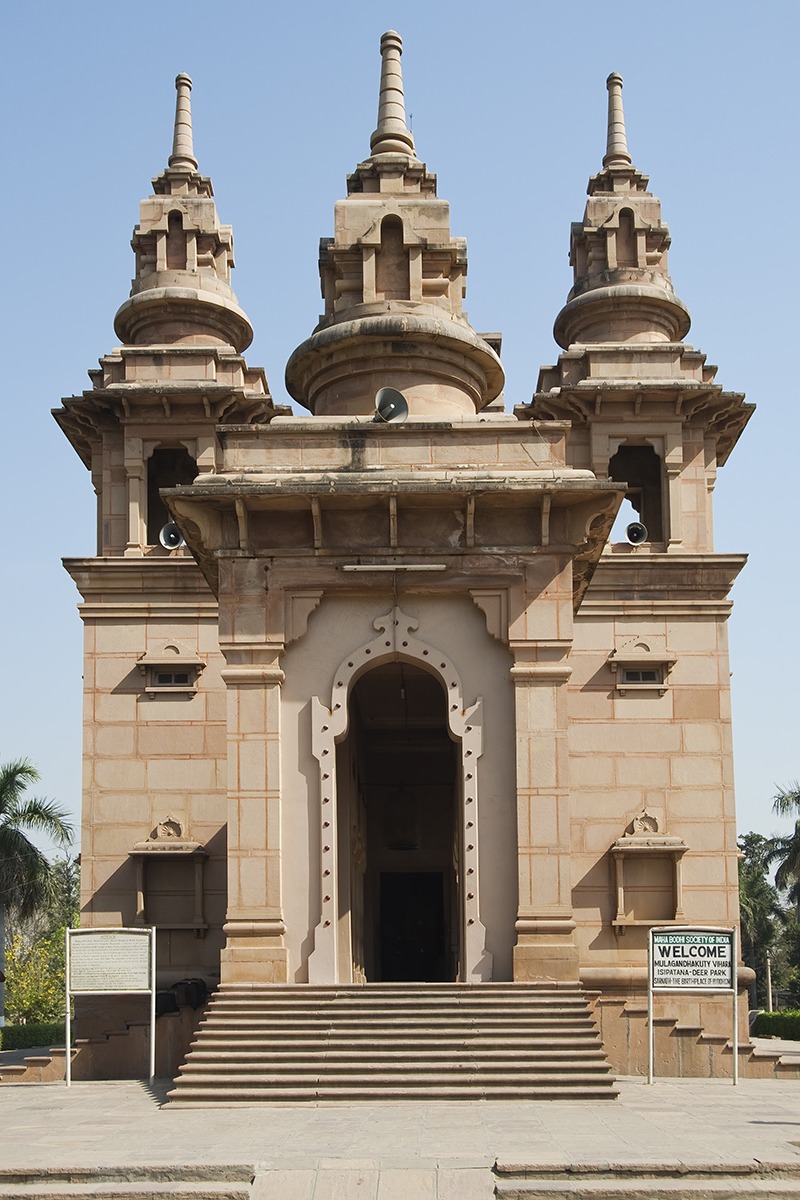
Mulagandha Kuti Vihar
Known for its enchanting frescoes and tranquil walking paths, Mulagandha Kuti Vihar is a Buddhist temple and monastery in Sarnath, India. The complex was built in 1931 by members of the Maha Bodhi Society to commemorate Buddha’s original teachings. Since then, the grounds have remained a center for learning and a popular pilgrimage site for Buddhists seeking deeper spiritual connections. One of the highlights of the temple is the wall frescoes that depict important events in the life of Buddha. Scenes from Buddha’s previous lives also are visualized in the drawings. The temple itself is designed in traditional Buddhist architecture, with Indian and Tibetan elements blended into the artwork. Mulagandha Kuti Vihar consists of meditation halls, prayer rooms and landscaped gardens, giving visitors plenty of space and freedom to contemplate on their own, but visitor also can join resident monks in meditation and worship practices daily.
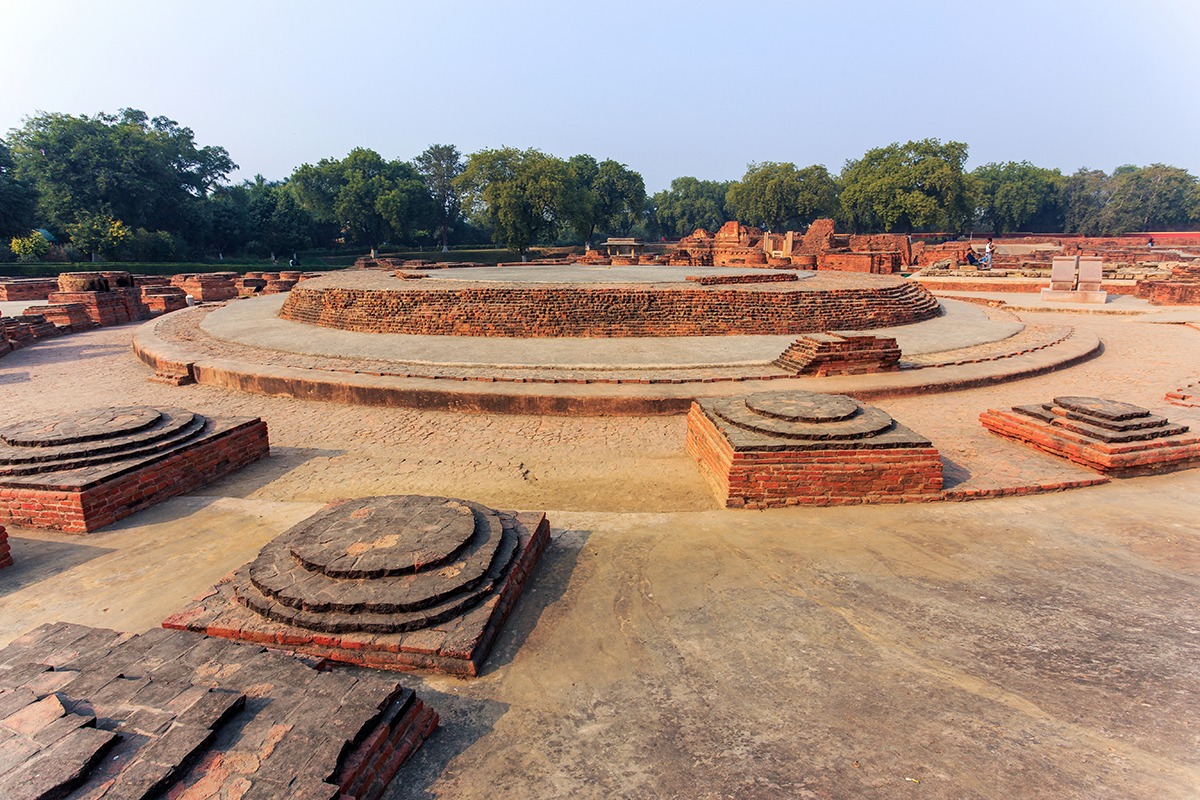
Sarnath Buddhist Complex and Archaeological Site
Many of Sarnath’s most historical structures are enclosed in the Sarnath Buddhist Complex, a UNESCO World Heritage Site. The archaeological compound houses the area’s most notable stupas, monasteries, temples and ruins. Some can’t-miss places to visit in Sarnath Buddhist Complex include Dhamekh Stupa, Chaukhandi Stupa and Mulagandha Kuti Vihar. Sarnath Archaeological Museum, also within the complex, features a vast collection of Buddhist artifacts and sculptures excavated from the sites. The Sarnath Museum is open from 9 a.m. to 5 p.m. daily, except for Fridays. The compound is closed on Fridays. The entry fee is 5 INR.
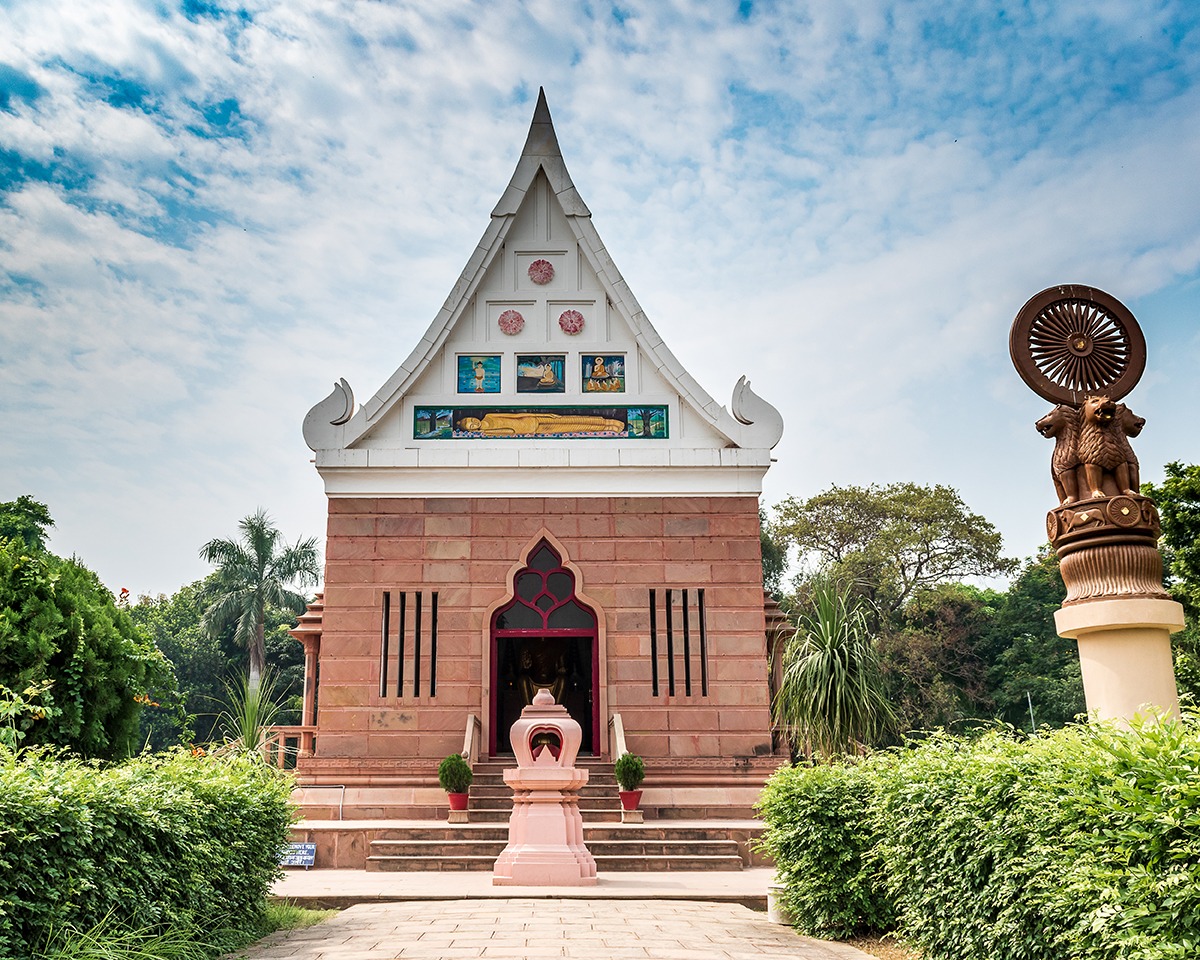
Ashokan Pillar
Erected by Emperor Ashoka in the third century, the Ashokan Pillar in Sarnath represents the pivotal role Ashoka played in the establishment and spread of Buddhism. Historically, Ashoka is one of India’s most beloved ancient rulers, as he embraced Buddha’s teaching after experience great grief about his role in the Kalinga War. Depicting a lion, the pillar was built as a place for Ashoka to inscribe his political and religious beliefs and philosophies. Now, the iconic lion is one of the most recognizable symbols in India, as the Lion Capital of Ashoka is the country’s official emblem.

Garden of Spiritual Wisdom
The sprawling grounds of the Garden of Spiritual Wisdom serve as the backdrop for Chaukhandi Stupa, the place where Buddha first met with his disciples after attaining enlightenment. While the garden is not part of the Buddhist Circuit directly, it offers pilgrims a captivating atmosphere in which to meditate and observe Buddha’s teachings. Tranquil pathways pass by spiritual sculptures that help guide visitors searching for inner peace. The garden is free to enter and open to the public from 8 a.m. to 6:30 p.m. daily.
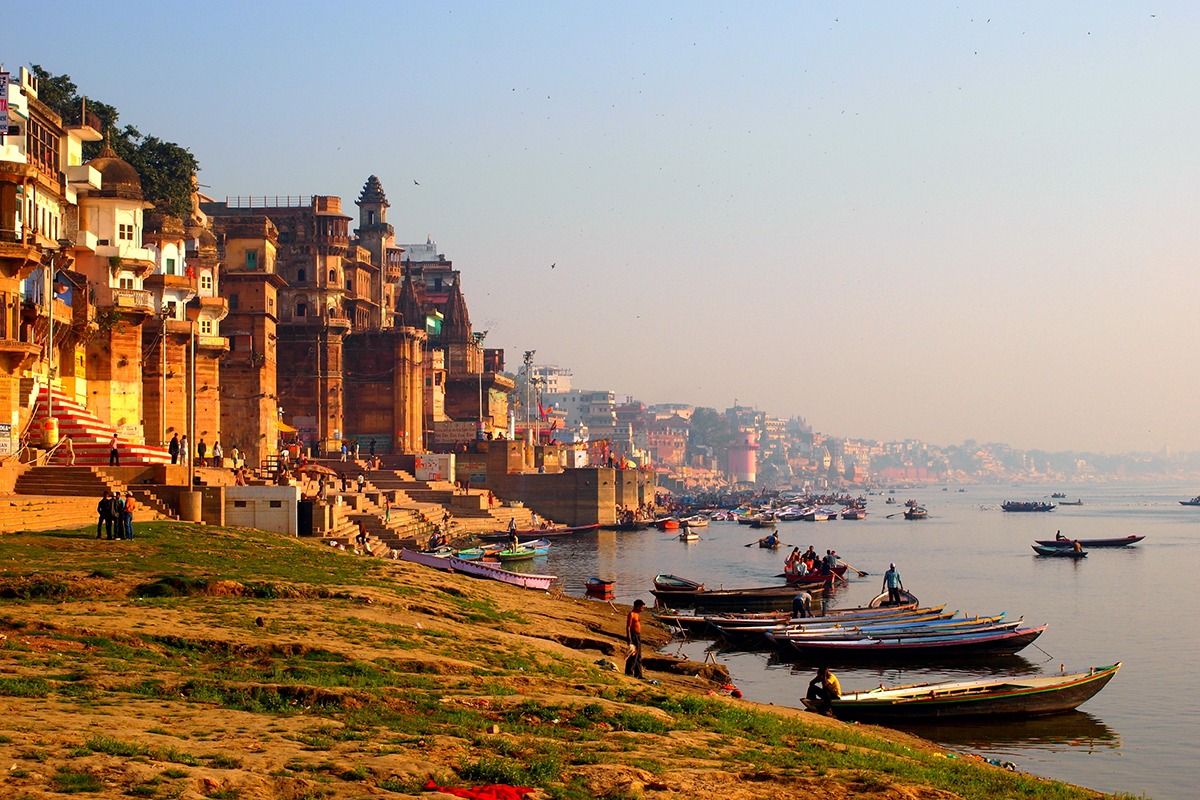
Varanasi, Ganges River & Dashashwanedh Ghat
The bustling city of Varanasi may be known worldwide due to its position along the banks of the famous Ganges River, but as the spiritual and cultural capital of India, this city has some serious tourist attractions. Varanasi is one of the oldest continuously inhabited cities in the world and serves as a prominent pilgrimage destination for Hindus. Varanasi is believed to be the home of Lord Shiva and the holiest of the seven sacred cities in Hinduism. Pilgrims and tourists alike visit Varanasi for its Banarasi silk, Muslin fabrics and ivory creations, as well as for its numerous ancient temples, ashrams and ghats, or stone steps leading to the Ganges River. Consider the following things to do while exploring the vibrant culture, narrow lanes and traditional Indian art scene that make up Varanasi.
- Take a boat ride down or bathe in the Ganges – the Ganges River serves as a source of life for many pilgrims. Along the banks, visitors can witness rituals and devotions. Many pilgrims and tourists come to the river’s edge to bathe, perform religious ceremonies and release cremated remains into the water.
- Tour Ramnagar Fort – open from 9:30 a.m. to 5:30 p.m. daily, this sandstone fort is free to explore. The royal residence and museum feature vintage cars and even a whole armory.
- Visit Kashi Vishwanath Temple – this ancient riverside temple is cherished for its gold-plated spire and sacred water well. It is open from 6 a.m. to 6 p.m. every day except Sunday.
- Catch a sunset along the ghats – partake in a mesmerizing and spiritual experience by watching the sun descend over the sacred Ganges River. The famous golden glow is what holiday fairytales are made of.
- Attend an evening Aarti ceremony at Dashashwamedh Ghat – the Aarti, or dance of fire and devotion, symbolizes the transition from day to night, so it’s no surprise that an Aarti ceremony starts at dawn. One of the most colorful and spiritually uplifting Aartis in India takes place along the Ganges River at Dashashwamedh Ghat, the most famous of the 84 ghats along the Ganges.
- Visit the weavers’ village of Sarai Mohana – here is where the ancient art of silk weaving comes alive! This quaint village nestled on the outskirts of Varanasi uses centuries-old traditions to create some of the world’s most exquisite silk fabrics, particularly Banarasi sarees. For an authentic local experience and a testament to India’s skilled craftsman, a visit to Sarai Mohana is a must.
- Join a sightseeing group tour of Sarnath – for a glimpse of a major site along the Buddhist Circuit, book a day tour from Varanasi to Sarnath. The region is one of the most important holy lands in the world, as it represents the place where Buddha delivered his first sermon following his enlightenment. It is said that Buddha walked the lands of Sarnath with his five disciples. Many artifacts and relics, as well as ancient architecture and historical remains, can be enjoyed during a tour of Sarnath.
- Explore Indian history at Bharat Kala Bhavan Museum – within the sprawling campus of Banaras Hindu University in Varanasi lies a treasure trove of art, culture and history. This remarkable museum houses a diverse and extensive collection of artifacts, sculptures, paintings and textiles that showcase the rich and multifaceted heritage of India. The museum’s galleries offer a fascinating journey through time, with exhibits that span from ancient archaeological finds to contemporary art. The museum is open from 10:30 a.m. to 4:30 p.m. Monday through Saturday. Hours are 10:30 a.m. to 4 p.m. on Sunday. Entry fees are 10 INR for Indian citizens and 100 INR for foreigners.
- Shop at a local market – head to Vishwanath Galli to find souvenirs, authentic Indian saris, handmade jewelry, religious artifacts and more at some of the city’s most popular local markets. Godowlia Market is one of Varanasi’s oldest market places, and Thateri Bazaar and Varanasi Silk Emporium deserve a browse as well. For more modern shopping experiences, check out JHV Mall and IP Sigra Mall.
- Eat a famous Varanasi snow cone – or snack on roasted peanuts or pani puri or kachoris or … the possibilities are endless! Head to the ghats for charming rooftop restaurants that serve up favorites like Banasari paan, or betel leaf-wrapped goodness, and baati chokha, a regional specialty that combines mashed vegetables with roasted wheat.
You may also like

Explore Malang: A 5-Day Adventure through Java's Hidden Gem
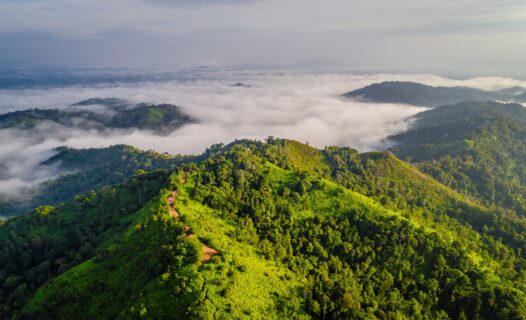
Welcome to Kuantan: A Gem on Malaysia's East Coast
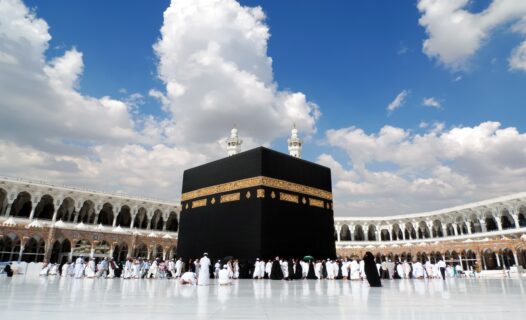
6 Days in Mecca Itinerary: Discovering the Spiritual Heart of Islam

Unveil the Magic of Cameron Highlands: A 3-Day Itinerary of Tea, Hikes, and Strawberries
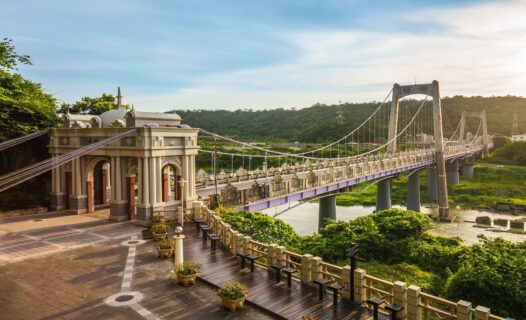
Weekend Getaway in Taoyuan Itinerary: Top Experiences
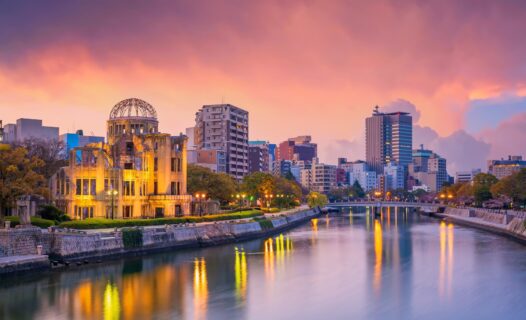
3 Days in Hiroshima Itinerary: A Journey Through Peace and Memory

Discover Fujikawaguchiko: A 3-Day Itinerary of Breathtaking Views, Culture, and Serenity
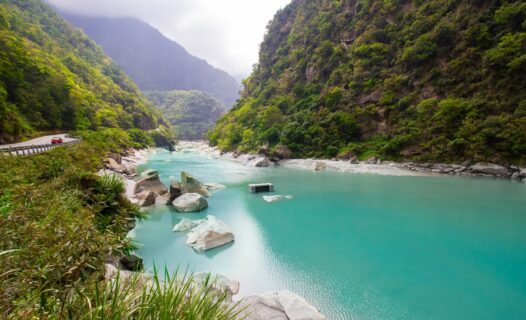
Explore Hualien: A 3-Day Itinerary Through Mountains and Seas

Exploring the Windy City: A 3-Day Chicago Itinerary

Welcome to Paradise: Your Ultimate Weekend Getaway in Boracay Island
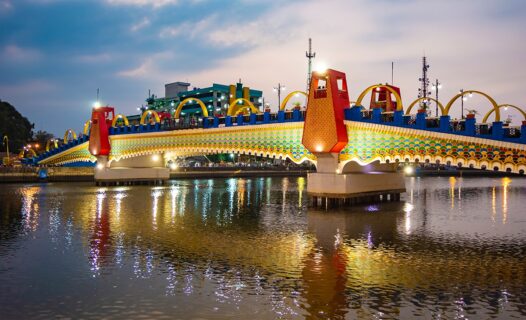
A Culinary Journey Through Tangerang: Traditional Dishes You Must Try

Welcome to Houston: The Ultimate 5-Day Itinerary

Your Ultimate 3 Days in Rome Itinerary

Welcome to Your Unforgettable Weekend Getaway in Barcelona!
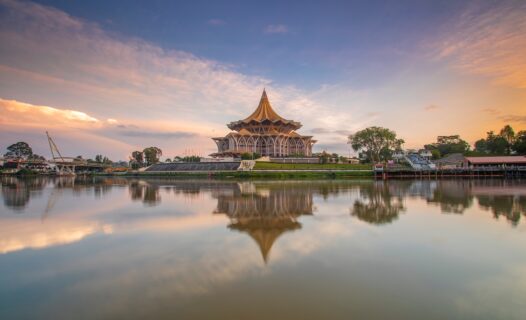
Weekend Getaway in Kuching: A Journey Through Borneo's Enchanting Heart
Discovering the hidden gems of east java: 7 days in malang itinerary.
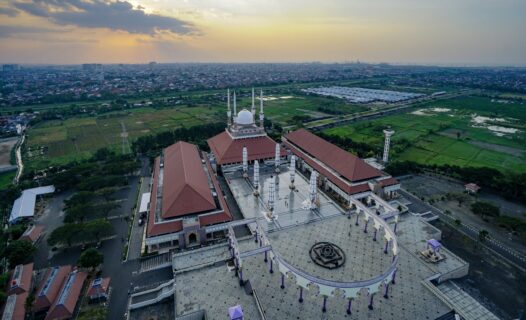
7 Days in Semarang Itinerary: Unveiling the Charm of Central Java

7 Days in Melbourne Itinerary: Exploring the Cultural Capital of Australia
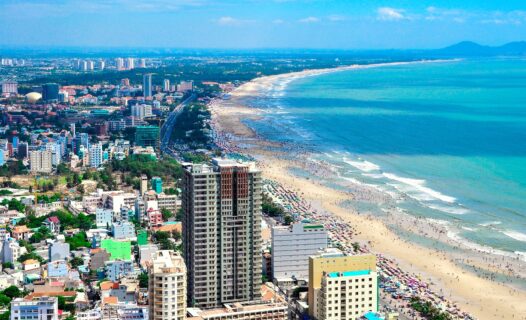
Welcome to Vung Tau: A Coastal Retreat Awaits

Family Fun in Batam: A 5-Day Itinerary for Memorable Vacations

3 Days in Chonburi Itinerary: Exploring the Best Beaches and Natural Wonders

Explore Malang: A 5-Day Adventure through Java's Hidden Gem
Embark on an unforgettable journey through Malang with our comprehensive travel guide. Discover the city's vibrant culture, breathtaking natural wonders, and culinary delights.

Welcome to Kuantan: A Gem on Malaysia's East Coast
Discover the best of Kuantan in 3 unforgettable days. Dive into our guide for the ultimate itinerary covering serene beaches, rich local culture, and delicious cuisine.

Embark on a life-changing 7-day spiritual journey in Mecca with our comprehensive guide. Discover sacred sites, enrich your faith, and immerse in Islamic culture.

Uncover the serene beauty of Cameron Highlands with our exclusive 3-day itinerary. From lush tea plantations to sweet strawberry farms and mystical hikes, embark on an unforgettable journey.

Dive into a weekend of exploration with our Taoyuan itinerary! Discover the perfect blend of history, nature, and gastronomy in just two days. Plan your unforgettable getaway with top experiences and hidden gems in Taoyuan.

Discover Hiroshima through a 3-day itinerary: from Peace Memorial Park to Miyajima Island's serenity. Embark on a journey of peace, resilience, and beauty.

Unlock the serene beauty of Fujikawaguchiko with our 3-day itinerary guide. Explore majestic Mt. Fuji, cultural gems, and soothing onsens.

Embark on a captivating 3-day journey through Hualien, Taiwan. Explore Taroko Gorge, indulge in local cuisine, and uncover hidden gems with our comprehensive itinerary.

Embark on a captivating 3-day journey through Chicago, discovering the city's skyscrapers, cultural gems, and culinary delights.

Dive into a perfect weekend in Boracay Island with our tailored itinerary. Discover pristine beaches, vibrant nightlife, and culinary delights.

Embark on a flavorful adventure in Tangerang with our 3-day culinary guide. Discover traditional dishes, hidden gems, and unforgettable eating experiences in Indonesia's city of gastronomic delight.

Discover the best of Space City with our ultimate 5-day Houston itinerary. From space centers to culinary delights, explore parks, museums, and markets.

Embark on a captivating 3-day journey through Rome's ancient glory and modern charm. Discover history, art, and culinary delights in the Eternal City.

Explore Barcelona in a weekend with our curated itinerary. Uncover Gaudí's masterpieces, savor Catalan cuisine, and bask in the city's vibrant culture.

Weekend Getaway in Kuching: A Journey Through Borneo's Enchanting Heart
Dive into our Kuching weekend itinerary for top attractions & eats. Discover hidden gems, cultural wonders, and tantalizing food in the heart of Borneo.

Embark on a 7-day journey through Malang, exploring breathtaking landscapes, rich culture, and hidden gems. From sunrise at Mount Bromo to traditional Javanese wellness, our itinerary guides you through unforgettable experiences.

Embark on a 7-day adventure in Semarang, Central Java's coastal charm! From historical marvels like Lawang Sewu to scenic Rawa Pening, our guide unveils must-see spots, local cuisine, and secret gems.

Uncover the best of Melbourne in 7 days with our comprehensive itinerary. From cultural landmarks and lush parks to riverside wonders and culinary delights, get ready to explore the vibrant heart of Australia.

Dive into our Vung Tau Weekend Getaway Itinerary for an unbeatable blend of sandy beaches, historic landmarks, and culinary delights. Start planning your dream coastal escape with Agoda and unlock the secrets of Vung Tau’s charm.

Uncover the ultimate family getaway in Batam Island with our 5-day itinerary! From beach fun to cultural tours, adventure parks, and delicious cuisine, discover activities that appeal to all ages.

Unlock the best of Chonburi in just 3 days! From serene beaches to captivating culture and natural wonders, our comprehensive itinerary guides you through unforgettable experiences.
Current language
All languages.

Sarnath Varanasi
Varanasi is an ancient city in India known for its timeless beauty. The majestic Ghats, the ancient temples, and the zigzag lanes all come together to create an enchanting sight. As the sunsets, the air is filled with the sound of temple bells, the smell of incense and the sight of lit oil lamps floating along the River Ganges. It is said that one can find spiritual peace in this holy city. It is no wonder that the city has attracted pilgrims for centuries.
Along with several places to visit, one of the famous places that add one more star to the beauty of Varanasi is Sarnath. Few kilometers away from the city, the place holds immense importance as well as pleasure scenes to the eyes. Sarnath is considered to be one of the four most important pilgrimage places for Buddhists all over the world. As the site of the Buddha’s first sermon, it holds a unique place in history. The Varanasi trip will be totally incomplete without visiting Sarnath.
Diving Deep into the Beauty of Sarnath
Sarnath is a holy place with a lot of spiritual and natural beauty. It is surrounded by beautiful green fields and quiet ponds. Many people visit the deer park and the archeological site to enjoy the quiet atmosphere, especially in the evening when it glows with a gentle orange light and the shadows of the majestic deer.
The name Sarnath comes from “Sarangnath”, who is also known as the Deer God. Among the four most important Buddhist pilgrimage destinations, Lord Buddha himself visited this city, also known as Isipatana. It is also said that Sarnath is the location of Lord Buddha’s “Dhammacakkappavattana Sutta”. Consequently, Sarnath is the place to go if you value peace or want to learn about India’s rich history.
Apart from being a pilgrimage site, Saranath is also an important archaeological location in India. The main attraction of this site is a grand Stupa that was built in 249 BC right after Buddha’s death. The Ashoka Pillar, built in the 3rd century BC along with many other remains of the different dynasties scattered around the site helps to explore the architectural heritage of the place.
Uncovering the History of Sarnath
Sarnath has many names, like Mrigadava, Migadya, Rishipattana, and Isipatana. Each name has a spiritual meaning. Sarnath is believed to be the place where Gautama Buddha shared his first sermon after attaining enlightenment and thus highlighting the significance of four noble truths and eightfold path. In order to spread his teachings of enlightenment and nirvana, Buddha traveled to Sarnath. The deer park was the site of his first sermon.
Multiple Muslim invasions of India caused damage on the country’s cultural treasures throughout the 10th and 12th centuries. Sarnath was left in destruction and almost completely out of the map of India as a result of these invasions, but a small group of British archaeologists recognized the site’s historical value in the nineteenth century. As a result, Sarnath gained popularity as a major Buddhist holy site.
As a means of spreading the dharmic teachings of Buddha, the Great Emperor Ashoka constructed a number of stupas and monasteries in this area. The museum displays a pillar that Ashoka constructed in the third century BC. It stands 15.24 meters tall and depicts four lions. Multiple Buddhist temples and other monuments were built in Sarnath between the third and eleventh centuries BC, when the religion was at its height in popularity.
A Journey to the Holy Land of Sarnath
When it comes to the Indian spiritual and cultural landscape, you can’t miss out on mentioning the ancient city of Varanasi, one of the most sacred places in Hinduism. There are multiple sites of pilgrimage associated with the city, chief of them being the holy town of Sarnath, located 10 kms away from Varanasi.
A trip to Sarnath is certainly worthwhile, giving one the opportunity to explore the ancient world of Indian culture and religion. There is something here to please everyone, from history lovers to devotees and art enthusiasts. From exploring about the sermons of Buddha to appreciating the incredible sculptures from the past, Sarnath will prove to be a memorable journey. With so much to discover, there will never be a shortage of things to do in Sarnath
Exploring the Mystical Site of Sarnath
Apart from the archaeological sites, there are also many temples that are visited by numerous devotees throughout the year. As you walk through the town, many beautiful temples, old monasteries, and grand buildings take you back to a more peaceful time. The places to enjoy near Sarnath are as follows:
Deer Park: It is about 2km from Sarnath Railway Station. Sarnath’s Deer Park (also known as Istipana) is both a sacred site and a small zoo. There are big enclosures for deer and reptiles, as well as a bird house and a pond. There are many deer and blackbucks freely explore the vast, beautiful landscape. There are also a variety of birds, as well as emus, crocodiles, and turtles. The entry hours are from 8 a.m. to 5:45 p.m. The cost to get in is Rs. 10 for Indians and Rs. 50 for foreigners. Different charges are applied for photography.
The Chaukhandi Stupa: It is situated 1.5 km from Sarnath Railway Station. In the fifth century, this stupa was constructed to commemorate the spot where the Buddha gathered with his followers for the first time. This is why the structure is so important to architecture and history. The stupa’s tower was constructed in the 16th century to honor Emperor Humayun’s visit to the site. The entry hours are from 6 a.m. to 5 p.m. The cost to get in is Rs. 5 for Indians and Rs. 100 for foreigners.
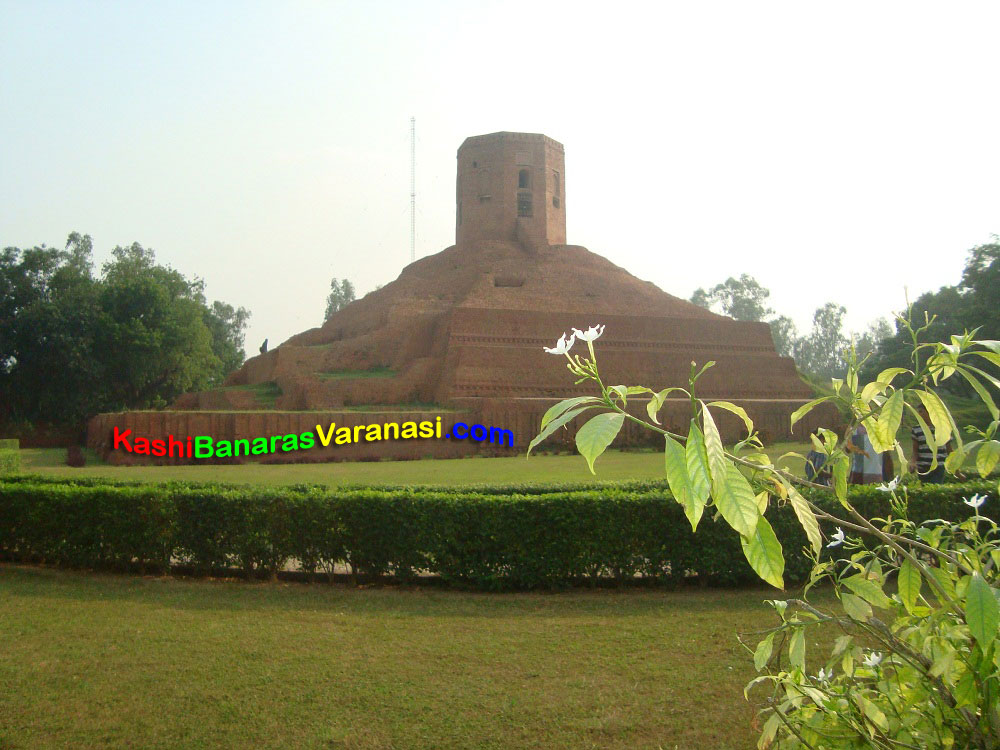
Ashoka Pillar: The great Mauryan emperor Ashoka built the Ashoka Pillar, which serves as the national symbol of our country. Together with Dhamek Stupa, it reaches a height of 50 m. Several monks can be seen meditating in the compound, which is open to visitors. A chakra is depicted at the base of the Ashoka Pillar, which also features four upright lions.
Tibetan Temple: It is situated 1 km from Sarnath Railway Station. There is a statue of Shakyamuni Buddha and Tibetan Buddhist paintings (Thangkas) decorating the walls of the temple’s Buddhist shrine. The prayer wheels are on display in the courtyard of the temple. Prayer scrolls are released when the handles are turned in a clockwise direction. The entry hours are from 6 a.m. to 6 p.m. The cost to get in is free for all the visitors.
Dhamekh Stupa: It is situated 1.5 km from Sarnath Railway Station. This is the most visible structure in Sarnath. Dhamekha appears to be a distorted form of Dharma Chakra, which means rotating the Dharma wheel. The original stupa was built by Ashoka. The stupa is currently 31.3 m high and 28.3 m in diameter. The stupa’s lowest section is entirely covered with finely carved stones. The Dhamekha stupa is regarded as the sacred site where Buddhism’s voice was first heard. The entry hours are from 6 a.m. to 5 p.m. The cost to get in is Rs. 25 for Indians and Rs. 100 for foreigners.
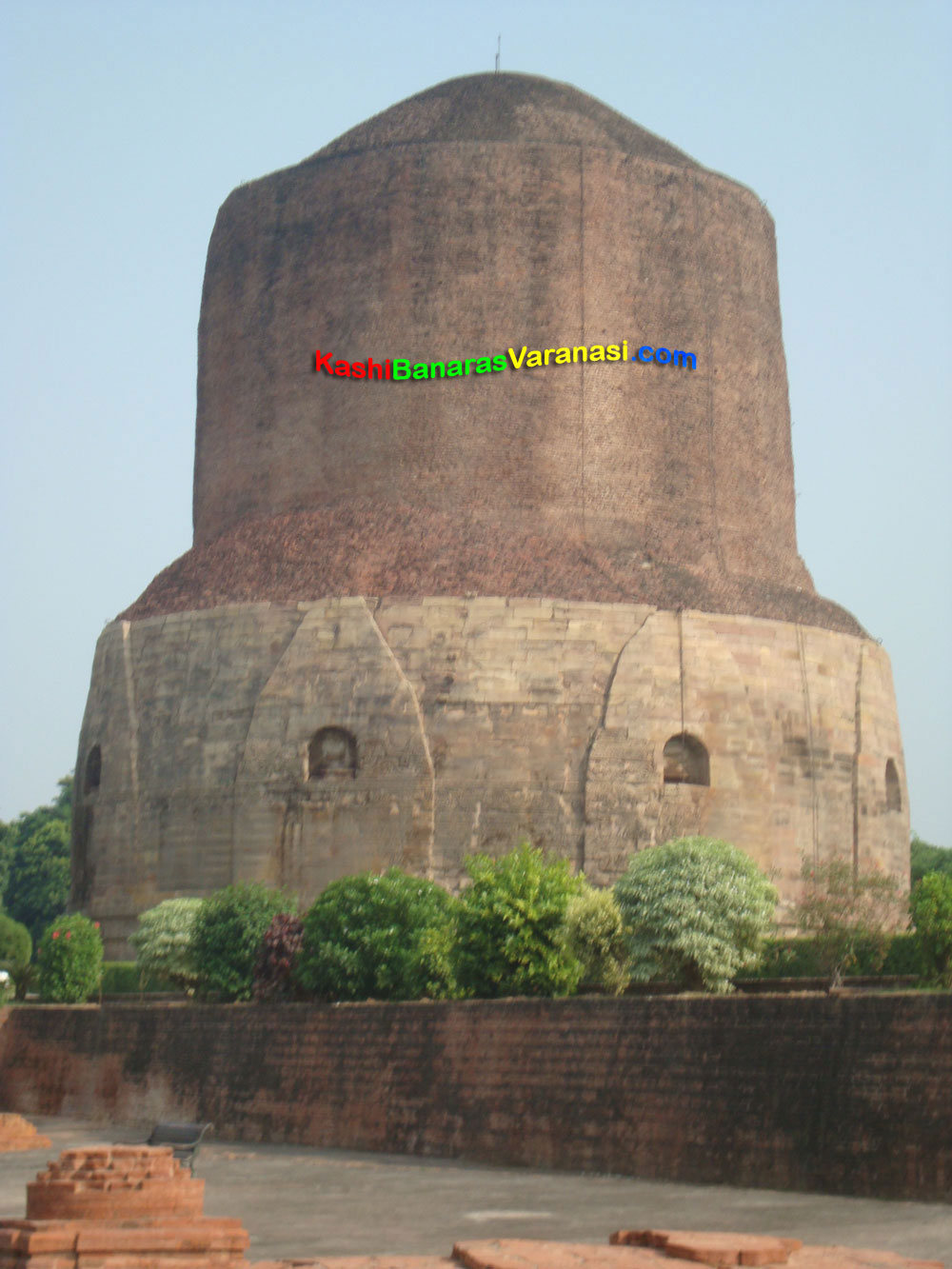
Sarnath Museum: It is situated 1.5 km from Sarnath Railway Station. The Archaeological Museum in Sarnath is a must-see for every historical fan. Buddhist antiquities were moved there from their original location at the site of Buddha’s first lecture. This sandstone museum dates back to the early 20th century. In 1910, the museum first opened to the public. The museum is accessible from 9 a.m. to 5 p.m. If you plan on visiting Sarnath, keep in mind that the museum is closed on Friday. The cost to get in is Rs. 5.
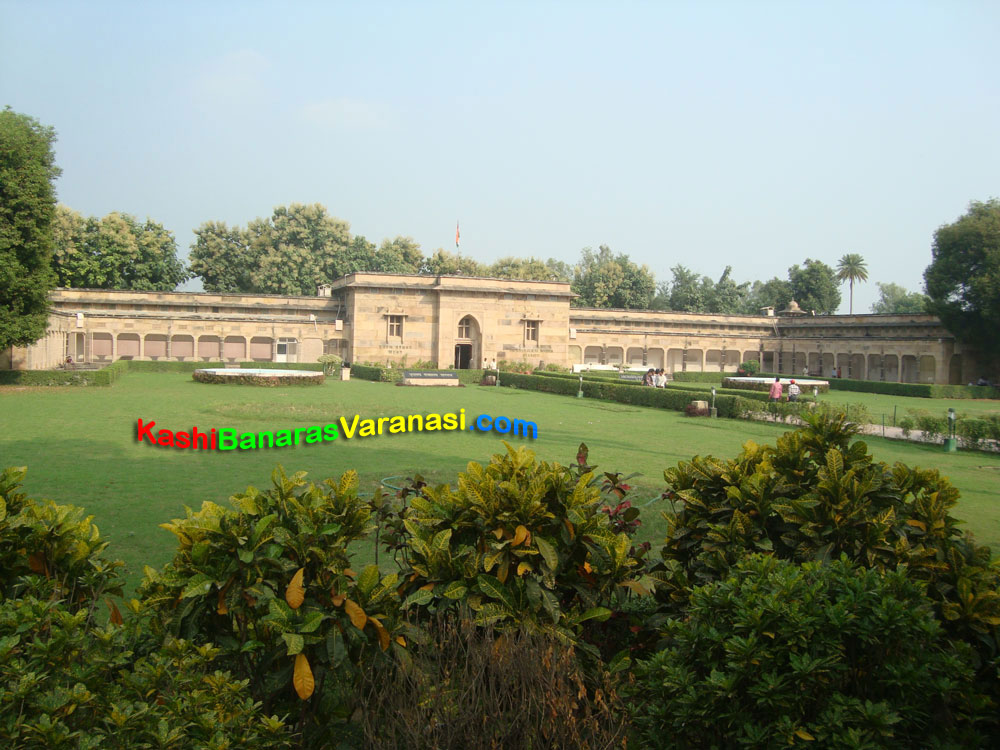
Mulagandhakuti Vihar: It is situated 1 km from Sarnath Railway Station. The majority of visitors come to Sarnath to see this. The tall structure stands at a height of 110 feet. This is where Lord Buddha stayed when he visited Sarnath. The entry hours are from 4.30 AM – 11 AM & 1.30 PM – 5.30 PM. The entry for all the visitors is free.
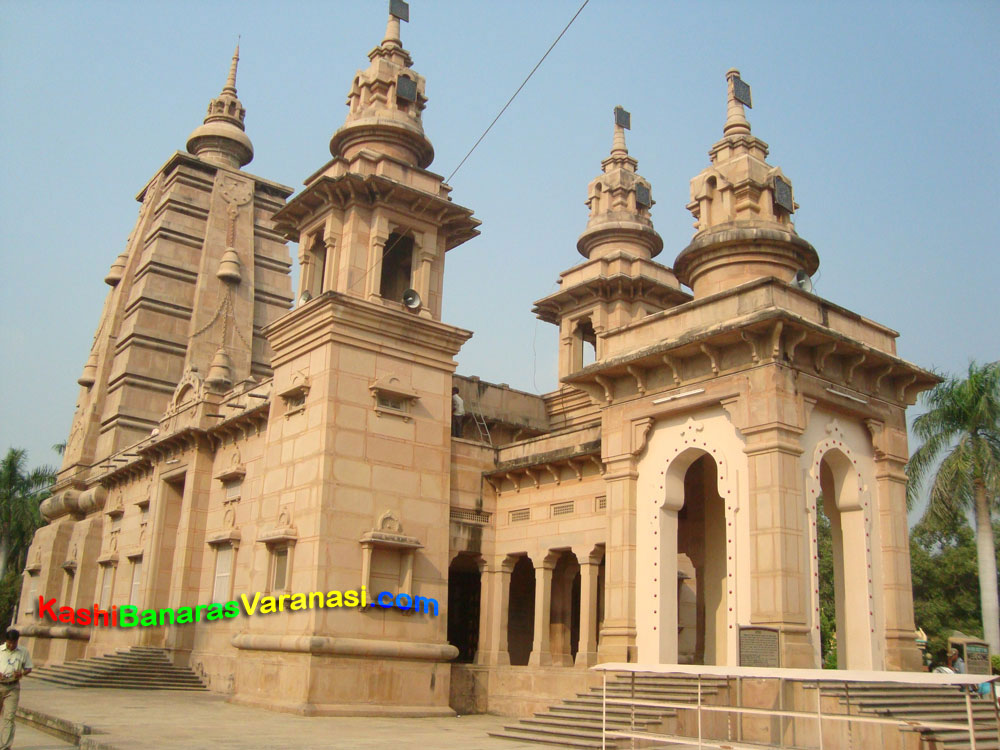
Thai Temple: It is located 1.5 km from Sarnath Railway Station. The temple, also known as Wat Thai, is filled with beautiful images of Buddha, such as the Laughing Buddha and Buddha instructing his students. The gorgeous architecture, calm environment, and inspiring Buddha sculptures create an atmosphere of calmness. Just beyond the temple’s walls is a lovely garden. The entry hours are from 6 a.m. to 6 p.m. The entry for all the visitors is free.
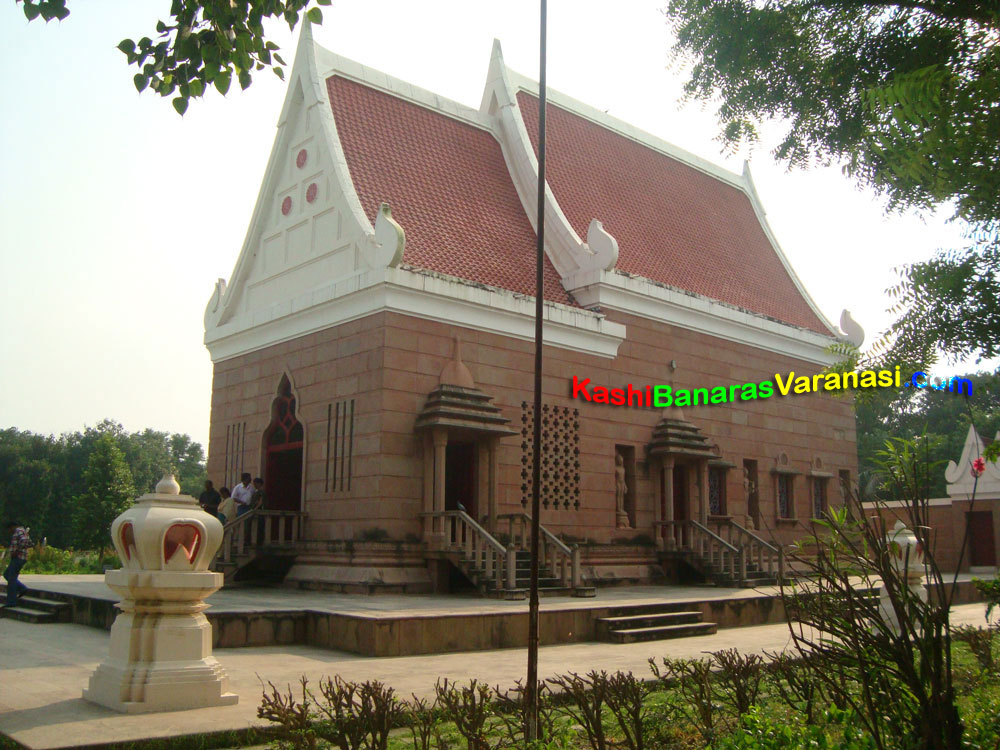
Buddha Statue: A big Buddha Statue is located at the Thai Buddha vihara of height 80 ft. It is considered as the tallest standing Buddha statue at Sarnath. It was built originally of stone over 14 years during the Indo-Thai joint effort.
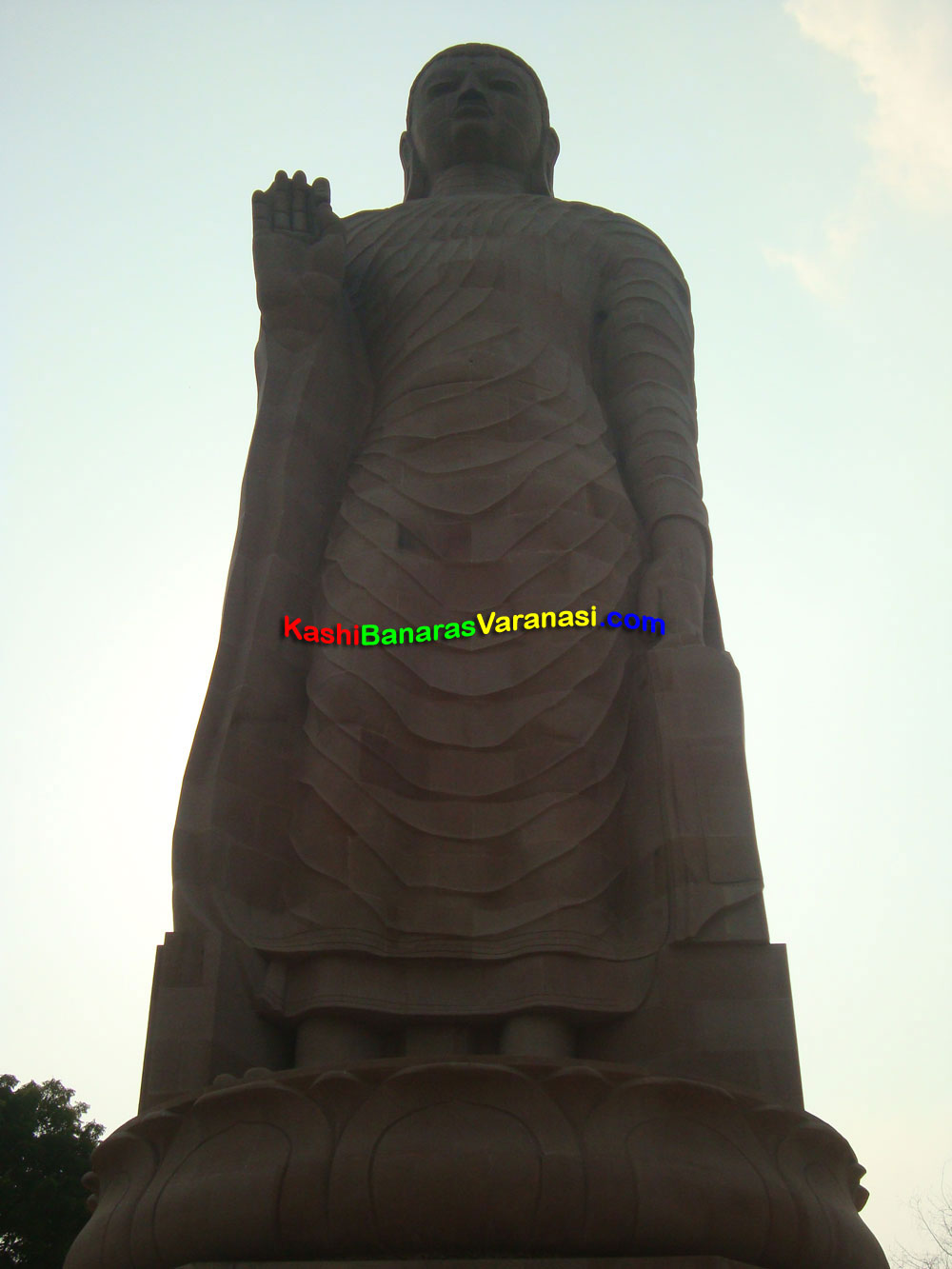
Sri Digamber Jain Temple: Sri Digamber Jain Temple is located near to the Dhamekh Stupa. It is the most religious place for the Digambara monasticism which is a branch of the Jain Dharma.
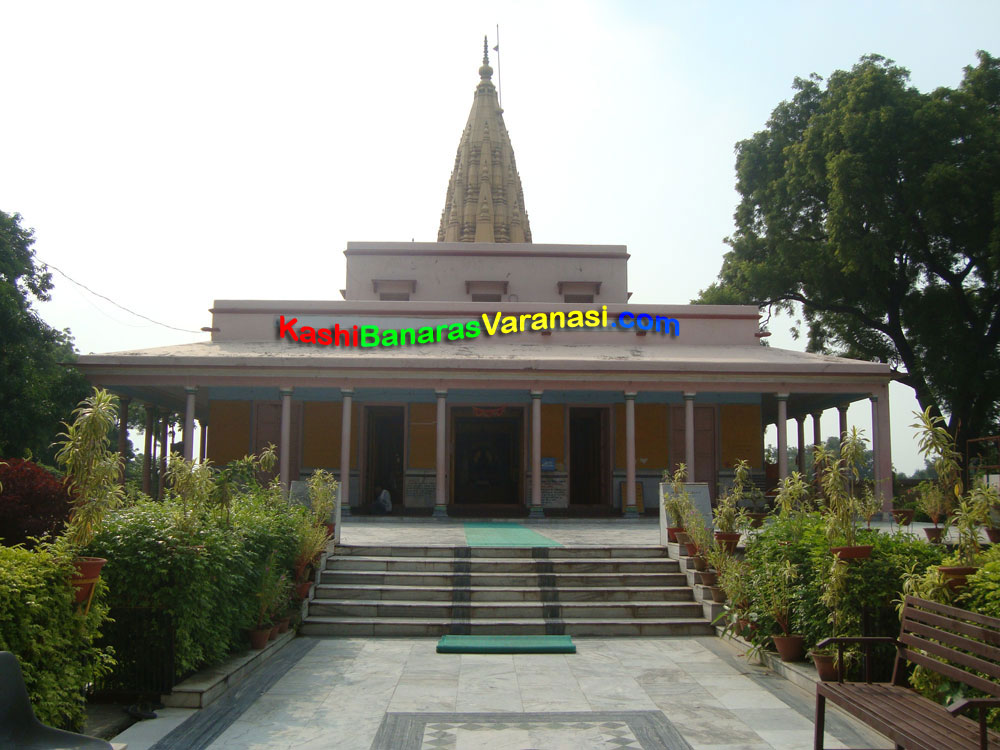
Dharmarajika Stupa : Dharmarajika Stupa is the very significant place located near to the Dhamekh Stupa. It is considered that this place has the remains of bones of the Lord Buddha. It was built by the King Ashoka which was destroyed in 1794 by the Jagat Singh (to get bricks for another construction purpose) during which a box with bones was found. The box is still kept safely at the Indian Museum, Kolkata. It is considered as the bones were disposed off in Ganga by the Jagat Singh.
Bodhi Tree : It is located near to the Mulagandhakuti Vihara Buddhist temple, called as the holy Bodhi vriksha. It is the most holy place for the people of Buddhist religion as Lord Buddha had attained his enlightenment here beneath the tree. It is planted at the Sarnath by the founder of Maha Bodhi Society of India (Sri Devamitta Dhammapala) on 12 th of November in 1931 by taking a branch from the real Sri Maha Bodhi tree of Anuradhapura, Sri Lanka.
Singhpur: It is thought that Shreyansanatha, the 11th Jain tirthankara, was born in Singhpur (Simhapuri), a village about 1.7 kilometers (1.1 miles) northwest of Sarnath. It is also where four of the five good things in Shreyansanatha’s life happened. Shreyansanatha was one of the twenty Jain tirthankaras who reached moksha in Sametshikhar.
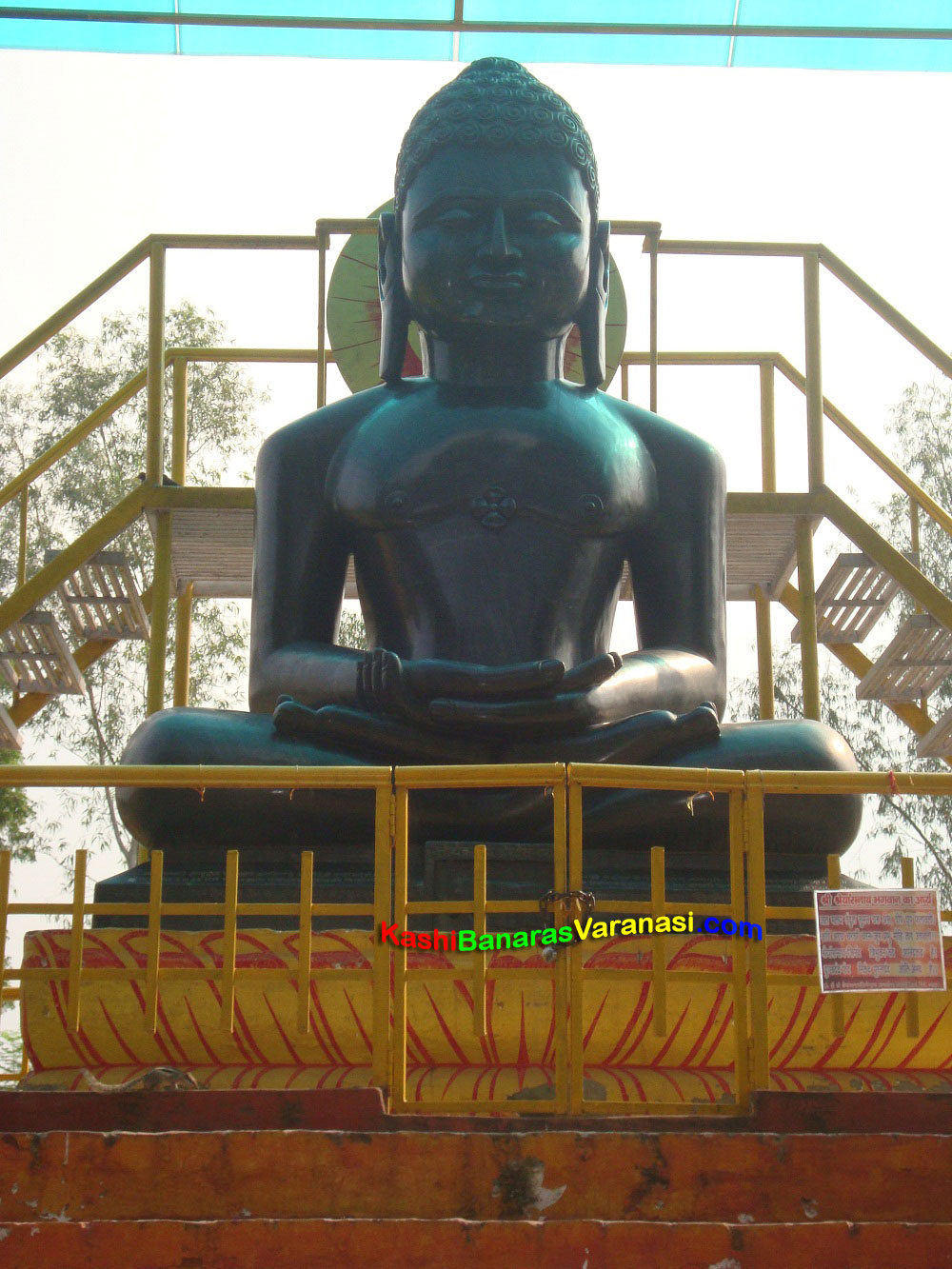
Nichigai Suzan Horinji Temple/Japanese temple : The Nichigai Suzan Horinji Temple is one of the Japanese temples located at Sarnath. This is a very nice temple of great importance to the Buddhism.
Migadawun Myanmar Temple : Migadawon Myanmar Temple is one of the earliest Buddhist Temples located at near to the Deer Park (means Migadava) at Saranath. It was built in the month of February in 1908. In February 2008 it had celebrated the Anniversary after completing 100 Years.
Burmese Buddhist Temple : The Burmese Buddhist Temple at Sarnath is a holy destination for the Buddhism, located at west side of Deer Park. It was built in the 1910 following the ancient Buddhist tradition, Theravada.
How to Reach Sarnath
Sarnath is about 10 kilometers from Varanasi, making it convenient for visitors to travel there using any kind of transportation. There are several affordable options for getting there. However, taking an auto-rickshaw or an Ola cab is the simplest option.
By Air: Lal Bahadur Shastri International Airport is the closest airport to Varanasi. Sarnath is about 20-25 kilometers away from there. After departing at the airport, you’ll need to take a taxi or some other kind of transportation to reach Sarnath.
By Train: Sarnath has its own train station and is well connected to local stations of Varanasi. The distance between Varanasi Cantt railway station to Sarnath is about 6 km. From Deen Dayal Upadhyay Junction, Sarnath is about 17 km. However, from Banaras station the distance of Sarnath is about 14 km. Upon reaching station, you can take a bus, cab, or a shared auto to reach the destination.
By Road: Road networks in and around Sarnath are adequate. You can go there through a taxi or a bus. If you like, you can use your own car or another mode of transportation. The bus stop, Chaudhary Charan Singh is about 6-7 km from Sarnath.
Best Time to Visit Sarnath
All seasons provide their unique charm to Sarnath. If you’re wondering when to visit Sarnath, the best months are from October to March. From April to October, the weather is extremely hot, making exploration difficult. When planning your trip, you may also want to take into account the various festivals celebrated here, which fill the area with the colors and chants of spirituality. Sarnath is a must-see for any tourist because of how beautiful it is and how important it is spiritually.
Origin of great names in Sarnath:
Mrigadava was named because of deer-park in sarnath. Isipatana was named because holy men have landed here. The devas rose into air and disappeared, only their sound fell on ground. It is believed that Pacceka Buddhas have spent their seven days in contemplation in the Gandhamādana and took bathe in the Anotatta Lake. After taking bathe in the lake he came to the habitations of men by the air. They came to earth at Isipatana through the air.
The Deer Park in the Sarnath was forest and gifted by the king of Benares for the purpose where deer might wander unmolested. Sarnath originated from Saranganath known as the “Lord of the Deer”. This park is still exists there today.
History of Gautama Buddha at Isipatana
The Gautam Buddha went from Bodhgaya to Sarnath after 5 weeks of his enlightenment. Before attaining his enlightenment, the Gautam has given up the Pañcavaggiya monks to his austere penances and friends then he left them and went to the Isipatana.
He enlightened five former companions using his spiritual powers as they were able to understand Dharma quickly. It is believed that he had to cross the Gange through air because he had no money to pay the ferryman. The Gautam Buddha had given his sermon to five monks known as his first sermon and called the Dhammacakkappavattana Sutta. He spent his first rainy season at the Mulagandhakuti of sarnath. The Buddha Sangha or community had grown from 5 to 60 in number. They sent by Buddha to all corner of the world to travel alone in order to teach the Dharma to people.
There are many other suttas preached by the Buddha at Isipatana besides the Dhammacakkappavattana, some of them are:
- The Anattalakkhana Sutta
- The Saccavibhanga Sutta
- The Panca Sutta
- The Rathakara or Pacetana Sutta
- The two Pasa Suttas
- The Samaya Sutta
- The Katuviya Sutta
- The Metteyyapanha of the Parayana
- The Dhammadinna Sutta
It is believed that, there is an ancient well at Isipatana which was used by the monks to live at the Buddha’s time.
Buddhism is flourishes in Sarnath because of kings and other wealthy merchants live in Varanasi. Sarnath had become a great center of arts by the third century. In the 7th century, it was noted that 30 monasteries and 3000 monks were founded at Sarnath. Sarnath is famous because it has became a major centre of earliest Sammatiya school of Buddhism. At Sarnath, the image of Lord Shiva and Brahma were found. A Jain temple is located at Chandrapuri close to the Dhamekh Stupa.
Legendary characteristics of Isipatana
According to the Legends, it is believed that all the Buddhas of Buddha Sangha had preached their first sermon at the Isipatana. Isipatana is known by different names such as Khema-uyyāna and etc. Many of the ancient buildings were damaged by Turks but still an impressive Dhamek Stupa of 128 feet height and 93 feet diameter is stand at sarnath. The Chaukhandi Stupa and ruins of the Mulagandhakuti vihara denotes that Buddha met his first disciples and he spent his first rainy season respectively.
The modern Mulagandhakuti Vihara has beautiful wall paintings and cute deers are still to be seen there. The original Ashoka Pillar stands there surmounted by Lion Capital of Asoka but it was broken during Turk invasions. It has became the India’s National Emblem and national symbol of our flag.
Sarnath also known as Isipatana, is one of the four pilgrimage sites where Gautama Buddha has been designated. The other three are Kushinagar, Bodh Gaya, and Lumbini.
Sarnath has become a pilgrimage place in Varanasi for Buddhists of all over the world. In some countries the Buddhism has become dominant religion. Some of them are Thailand, Myanmar, Japan, Tibet, Sri Lanka etc.
Sarnath photos
It is the beautiful image of the notebook like big stone written the history of the Dhamekh Stupa. It was written in the 6th – 7th century. This circular stoned body was made up of the Mauryan bricks.
Shri Digambar Jain Temple
What an attractive look of the Shri Digambar Jain temple located at Sarnath. It has very nice, fresh and natural environment having very beautiful gardens on both sides. People come here to see the natural historical monuments at Sarnath. This is the main entry gate of the Shri Digambar Jain temple at Sarnath. What a natural scenery it has. Devotees and travelers come regularly here from all over the India as well as outside the country to see this natural monument in the Varanasi. Some people are enjoying their great time at the entry gate.
Temple of the Tibetan community What a nice photo of the temple of the Tibetan community located at the Sarnath. It has beautifully organized entry gate having two nice Dwarpal on both side. Both side of the entry gate has written some information in the Hindi and Tibet language. Some people with their children are coming outside of the entry gate after seeing the Tibetan community temple. This is the inside view of the temple of the Tibetan community. It is the main temple, Tibetan Buddhist monastery, located inside the main entry gate. Both side of the temple has beautifully organized gardens. A traveler is seen taking the snapshot of the temple. This is the very inside view of the Tibetan Buddhist monastery, well designed and beautifully decorated. IT has the collection of many historical things. Devotees are sitting inside the temple and praying. One of the travelers is taking their snapshot from the side. This the great picture of the Ashoka wheel located in the circle having 24 sticks. A huge photo of the Lord Buddha is located behind the wheel. Both side of the wheel has nice looking greenery scenes. A well lighting system is there to give an amazing look to the scene at night. This is also the picture of the Ashoka wheel taken from another side. It is decorated with the lots of beautiful flowers in well organized manner. Surroundings greenery enhances its beautifulness. Buddha statue This is the picture of the Buddha statue located in the Sarnath. It is very big statue of the Lord Buddha looking very attractive and beautiful. It is a solid body made up of a stone structured by the architecture. Devotees are around the statue and looking at the statue. This is also the picture of the Lord Buddha taken from long distance to capture the natural scenes around. People are enjoying the scene by wandering all around.
This is the much closer view of the photo of the Lord Buddha taken to show the natural beauty of the statue and art of the architecture. This is the side view picture of the Buddha temple taken to show the sidewise natural looking of the scene. One of the travelers sits in the garden to have some shadow and rest. People are wandering inside the temple to have full pleasure.
This is the picture of the Lord Buddha temple located inside the Sarnath. A small pond full of water enhances its beautifulness. It has nice looking environment and greenery scenes.
This is also the one part of the Lord Buddha temple located in the Sarnath. It is very beautifully organized temple looking very attractive and amazing.
This is the picture of the Lord Buddha located inside the Buddha temple at Sarnath. What a nice looking image made up of the stone and wrapped in the yellow cloth. There are some flowers in the feet of the Buddha offered by the devotees. Ashokan Pillar
This is the picture of the Ashokan Pillar located at Sarnath. It is netted with the net for security purpose. Back side of the pillar has historical monuments. This is the image of the stone notepad in the side of the Ashokan Pillar written the history of the Ashokan Pillar. This Ashokan Pillar was created by the Mauryan Emperor Ashoka using Chunar Sand stone. This is the side view of the Buddha temple located at Sarnath showing the natural scenes of the nature. People are enjoying the beautifulness of the temple. This is the amazingly looking photo of the Lord Buddha inside the Buddha temple. A golden statue of the Lord Buddha is looking very attractive and so natural. This statue is located beneath the Pepal tree inside a temple looking structure. One of the statue is showing meditation and another one giving blessings to the devotees. This is another pic of the Buddha temple with the long statue of the Lord Buddha in the side at Sarnath. What an amazing look of the greeneries in the surroundings. This is the pic of the Dhamek Stupa taken from long distance to have other small historical monuments of the time of Lord Buddha. Travelers are wandering inside the surrounding area to seen the historical monuments and their importance. This is also the pic of the Dhamek Stupa taken from side to have the look of other small historical monuments. This is the pic of the real small monuments of the time of Lord Buddha. These monuments are real and as it were without any changes. It is a monumental railing made up of the Chunar sandstone and discovered by the Mr. Oertel during digging in 1904 and 1905. It measures around 2.54m in length. This is the picture of the Dhamek Stupa taken from small distance to have accurate view of this historical monument. Mulagandha Kuti This is the picture of the Mulagandha Kuti located at Sarnath, Varanasi. Mulagandha Kuti history is written on the stone notebook to have real ideas of it. This is also the image of the Mulagandha Kuti taken from much closer to have clear look of the history. This is the place where Lord Buddha was used of meditating.
Sarnath Tourism
This is the picture of the newly built structure at Sarnath showing the Buddha temple behind it. Regular working is continue at this place to add attraction. This is the pic captured to show the real art of that time. It is full of natural look and greenery scenes.
Dharamshala at Sarnath: This is the picture of the Dharamshala at Sarnath, Varanasi. It is built to fulfill the purpose of providing shelter to the travelers came to visit Sarnath.
FAQs on Sarnath
Ans. Sarnath is a special place for people who follow Buddhism. It is located near Varanasi in India. It is a place where Buddha taught his followers about Buddhism long ago. Many Buddhists come here to worship and show respect to Lord Buddha.
Ans. The Lion Capital of Ashoka is a symbol made by Emperor Ashoka a long time ago in Sarnath, India. It was originally on top of a big pillar, but now it’s in a museum.
Ans. Some historians argue that Buddha selected Sarnath because it was situated near Varanasi, a city renowned for its scholarly pursuits. This would allow him to engage in discussions with knowledgeable individuals and bring his teachings directly to the heart of Vedic tradition.
Ans. In the past, some Turkish Muslim invaders came to Sarnath and ruined a lot of things there. But still Sarnath is a very important place for Buddhist learning for a long time.
Ans. Sarnath, located in Varanasi in UP, was called by different names a long time ago. It is known as Sarangnath, Isipatana, Rishipattana, Migadaya, or Mrigadava in ancient times.
Related Posts
Tulsi manas mandir temple varanasi, durga temple varanasi, bharat mata mandir, bharat kala bhawan, jantar mantar of varanasi.
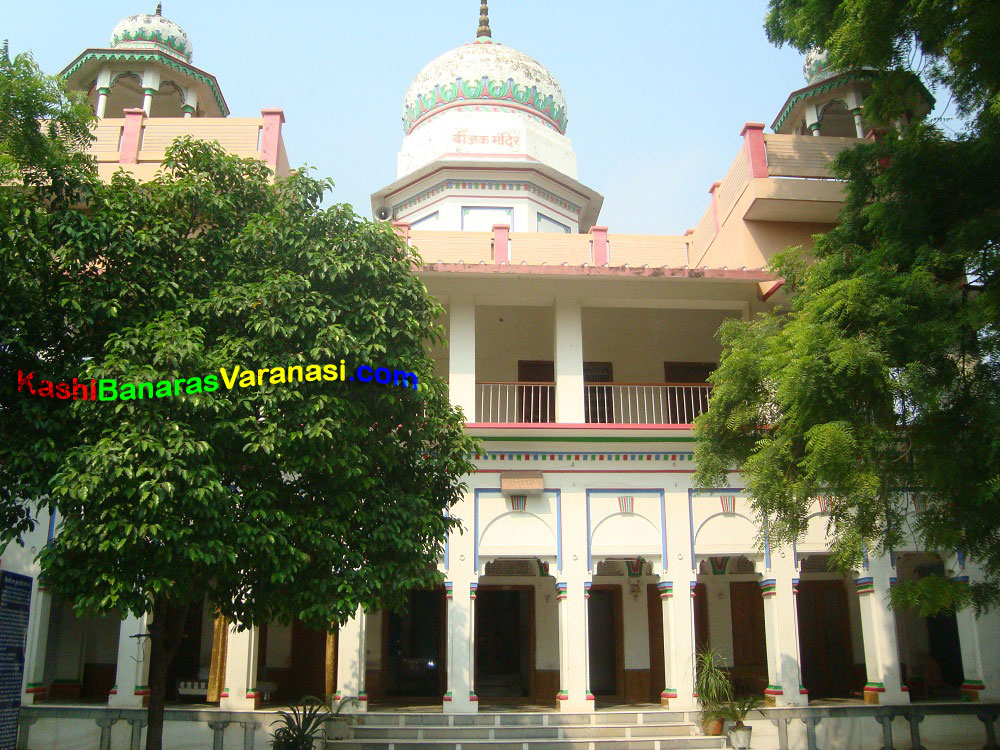
Ramnagar Fort Varanasi
Sankat mochan temple, ganga aarti varanasi, places to visit in varanasi.

Varanasi to Sarnath Day Trip – The Ultimate Travel Guide
Architecture , Uttar Pradesh

Last Updated on: May 20, 2021
Sarnath is one of the major pilgrimages for the Buddhists for this is the place where Lord Buddha gave his first sermon. Someone once told us that each and every stone of Sarnath is steeped in history. This spiritual destination near Varanasi was originally known as Isipathana . We had already explored a part of Varanasi when we decided to make a day trip from Varanasi to Sarnath and explore the place of Lord Buddha.
In this blog, we are going to share our experience about our trip from Varanasi to Sarnath, what are the places that you can visit in Sarnath and also about the small skirmish we had with our auto rickshaw driver.
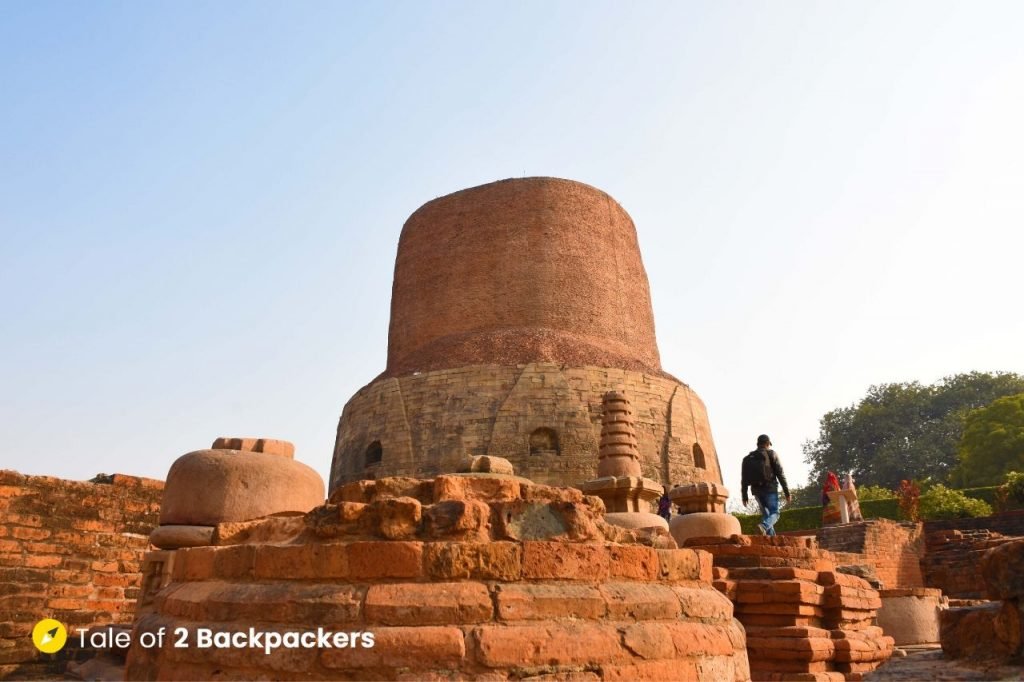
Sarnath – The History
It is true that Sarnath is full of history. Each and every corner of the place seems to tell a story. Located about 10 km from Varansi, Sarnath has a strong influence of Buddhism. The stupas, especially the magnificent Dhamekh Stupa, the various Buddhist temples and monasteries emphasize that importance of Buddhism in Sarnath.
After all, Sarnath is one of the four places that are associated with the life of Gautam Buddha. It is the place where Lord Buddha delivered his first sermon, also known as Dharmachakrapravartansthala after he attained enlightenment at Bodh Gaya. He decided to preach to his five disciples first. At Sarnath, Lord Buddha proposed the Four Noble Truths, which forms the essence of Buddhist teachings.
After this, Sarnath emerged as the centre of Buddhism and Lord Buddha established the first Buddhist Sangha here at Sarnath along with his 5 disciples. Later he sent those 5 disciples to different directions to preach the tenets of Buddhism.

Sarnath was originally known as Sarangnath , which means “The Lord of the Deer” . Sarangnath is another name for Lord Shiva. After all, Varanasi is known as the original land that Lord Shiva and Devi Parvati created. So Sarnath was also known as the land of Shiva before Lord Buddha arrived.
Almost 200 years after the Mahaparinirvana of Lord Buddha, King Ashoka built several stupas at Sarnath. He had also erected a pillar that is now known as the Ashokan Pillar and can be seen at the Sarnath Museum. During the Sunga period, a number of pillars were erected as well. During the reign of Kanishka, many Bodhisattva statues were built. The most beautiful ones were erected in the Gupta period.
Most of the historical account of Sarnath can be found from the accounts of the Chinese travellers Fa-Hein or Faxian who visited India during the 4th century AD and Hiuen Tsang or Xuan Zang , who visited India during the 7th century AD. With the increase of Buddhism in China, these explorers visited the land where Lord Buddha lived.
When Xuan Zang visited Sarnath, the place was a thriving centre of Buddhism with 1500 monks living there. But Buddhism went into decline after the Muslim invaders ransacked the city. Sarnath went into oblivion. It was only in 1835 when British archaeologists again found the lost city of Sarnath amidst rubbles and mounds.

Archaeological Excavations in Sarnath
Sarnath has been one of the most important historical sites in India and has been in the attention of many scholars and archaeologists. One of the first accounts of excavation was in 1794 by Jonathan Duncan . He had recorded the discovery of 2 urns by Babu Jagat Singh of Banaras. Jagat Singh was apparently digging a mound to obtain bricks for construction when he found the two urns and a marble box containing gold, silver, pearls and rubies and even a few bones. These were found near a sculpture dated 1026. Jagat Singh had discovered treasures!

The first formal excavation at Sarnath was done in1815 by Colonel Colin Mackenzie . However, the major successful excavations were done by Alexander Cunningham from 1834 to 1836 . He had excavated the main stupas of Sarnath along with the remains of the monasteries. He had excavated a large number of statues, inscriptions, votive stupas, panels and many more. All these artefacts can now be seen in the Archaeological Museum.
The main religious complex at Sarnath was discovered by Friedrich Oertel excavated the main shrine between 1904-05 and discovered the religious centre of the complex at Sarnath. The Ashokan Pillar and several statues of Buddha were excavated by him.
In 1907-08, Sir John Marshall had taken up the excavations and the remaining monasteries were found out. He also found the remains of a “hospital” near the main shrine.
The last major excavation was started in 1921 by Daya Ram Sahni . He had discovered a number of structures between Dhamekh Stupa and the main shrine as well as a number of passageways.
Sarnath Tourist Map
Take a look at this Sarnath Tourist Map and plan your exploration accordingly!
Places to see in Sarnath
While the ancient stupas, statues and edifices are found all around Sarnath, recently a number of Buddhist temples were built following the architectural styles of Thai, Burmese, Korean and Chinese temples. These temples give a unique perspective to this ancient town. Here are a few places that you can visit on your trip from Varanasi to Sarnath.
Sarnath Buddhist Complex

The Sarnath Buddhist Complex is the main archaeological complex in Sarnath. The main attraction of the complex is undoubtedly the colossal Dhamekh Stupa. There are, however, a few other stupas, monastery sites and other relics found all around the complex. Visit the Sarnath Buddhist Complex was one of our main reasons for our trip from Varanasi to Sarnath.
The remains of the ancient structures that can be seen today in Sarnath actually belonged to a period between the 3rd Century BC and 12th Century AD . Structures were built, they fell down, and sometimes another structure was erected over the broken one. So, all the structures in the complex obviously do not belong to the same time period.
Let us take you through the main structures and ruins inside the Sarnath Buddhist Complex.
Opening Time: Sunrise to Sunset
Entry Fee: Indian, SAARC and BIMSTEC citizens: Rs.5/- and others Rs.100/-
Dhamekh Stupa

Dhamekh Stupa or Dhamekha Stupa is the most famous monument in Sarnath. The massive stupa was originally built in 249 CE during the reign of Mauryan emperor Ashoka. With time, the stupa has undergone several additions and changes.
The Dhamekh Stupa stands as a solid cylindrical structure made of red bricks and stone having a height of 43.6 m and a diameter of 28 m. It is believed that Lord Buddha preached his first sermon after attaining enlightenment at this place. This famous event in the life of Lord Buddha is known as Dharma Chakra Pravartana or setting of the “Wheels of Law”. It is perhaps from the word “ Dharma Chakra ” that the word Dhamekh had evolved.
The place also marks the formation of the first ever Buddhist Sangh. Buddhist pilgrims from around the world visit the Dhamekh Stupa and circumambulate it and offer their prayers to Lord Buddha. It was evident from the remains of the intricate art work on the stupa that the structure might have had beautiful ornamentation and carvings.
YOU MAY ALSO LIKE: DIAMOND TRIANGLE – THE BUDDHIST HERITAGE IN ODISHA
When we visited the Dhamekh Stupa, we saw a number of Buddhists from Japan visisting the site. It was quite beautiful to see a group of pilgrims wearing the same coloured robe praying peacefully at the equally serene place. We sat down on the green lawn for some time soaking in the peace and calm. It was required after the little altercation we had with our auto driver. More on that, later.
Dharmarajika Stupa

It is believed that the original Stupa was built by King Ashoka in 3rd Century BC. The stupa was then enlarged at different times. This was, however, largely destroyed by Jagat Singh in 1794.
2 very beautiful statues of Buddha were excavated from the site of this stupa. Those are now found in the Archaeological Museum.
Main Shrine
A little north of Dharmarajika Stupa lays the main shrine. This shrine is totally in ruins today. Quite naturally, it used to be a grand structure in its heydays. The famous Chinese traveller and monk Hiuen Tsang had noted in his journal that the main shrine was almost 60m in height.
Ashokan Pillar

To the west of the main shrine is the remains of the Ashokan Pillar surrounded by a glass case. What remains of the pillar is the lower portion of the original 5.25 m high pillar crowned atop with the Lion Capital.
The Pillar has three inscriptions on it. The earliest one is the one in Brahmi script and is an Ashokan edict. In the inscriptions, the King warns the monks and nuns of punishment if they created a divide in the Sangha. The King wished to keep the Sangha united forever.
The second inscription is from the Kushan period and the third one is from from the earlier Gupta period.
Rectangular Courtyard

Between the Dhamekh Stupa and the main shrine lies a rectangular courtyard. There are a number of smaller shrines and votive stupas in this courtyard.
Panchayatana Shrine
The Panchayatana Shrine is located just south to the courtyard and looks like a Hindu Temple. The structure datyes back to the Gupta period
Monastery I – VII
There are 3 sites in the complex that is marked as monastery. Monastery I has an open courtyard and rows of cells on three sides. Monastery I probably belonged to 12 th Century AD. Sir John Marshall discovered an underground tunner 55 m in length at this site.
Monastery II belonged to Gupta period and is about 30 sq metre in area. There are only traces of nine cells surviving today in this one.

Monastery III dates back to the Kushan period having a similar plan to Monastery II.
Monastery IV is not yet fully excavated. The exposed portion consists of some cells and the remains of a verandah.
There are other remains of monasteries around the complex. You can simply roam around and take a look at the ruins of these monasteries to get an idea of the period.

Sarnath Deer Park
The Deer Park is the place where Lord Buddha preached his first sermon at Sarnath and the place where the first Buddhist Sangha came into being. In ancient times, Sarnath was also known as Mrigadava, meaning a place where deer can roam around freely. Also, Sarangnath means the “Lord of Deer”. Sarnath has a deep connection with deer.
In today’s time, the Deer Park is a sprawling area in the Sarnath Buddhist Complex where a number of deer roam around freely. The Deer Park is a lovely place to visit, though we did not visit there.
There is a lovely Buddhist story about the former incarnation of Lord Buddha, when he was the king of the deer. It is so believed according to Buddhist fables that the place where the current deer park is located was once a forest. In the forest lived two deer Kings Devdutta and Bodhisattva with their respective clan of 500 deer each.
One day, the king of Kashi visited the forest on a hunting expedition. Bodhisattva, the king of one of the deer clan went to the king and told him, “ Dear King! You set the forest on fire and killed my subjects with arrows. I request you to kindly permit me to send one deer every day so that you may get fresh and pure flesh, which would allow us to live for a little longer. “
The King was happy with the proposal and returned to the palace. Thus, every day, a deer was sent to the palace for sacrifice. One day, it was the turn of a mrigi (doe). She was from the herd of Devdutta and was pregnant. She went to Devdutta and said that she was ready to die, but her unborn child should not be harmed. King Devdutta was angry to hear this, but the mrigi said to Devdutta whether it was dharma to kill an unborn.
Devdutta was in a dilemma and shared this to Bodhisattva. King Bodhisattva, then decided to go to Kashi in place of the doe. He went to the King of Kashi and narrated the story of Mrigi to the King. The King of Kashi then realized his mistake and his lack of compassion and empathy. He not only freed Bodhissatva and ended this tradition of sacrifice; he also created a sanctuary for the deer to live in peace and without fear. That is why the forest came to be known as Mrigadav.
Mulgandha Kutir Vihara

The ancient Mulgandha Kuti Vihara is now in ruins and they can be seen from the Dhamekh Stupa. At the ancient site, there is a plaque that says probably Lord Buddha sat at the place for meditation. The ancient temple was perhaps made during the Gupta period. According to Xuang Zang, the height of the temple was almost 61 m.
The new Mulgandha Kutir Vihara is located right adjacent to the ruins of the ASI excavation site. Shri Angarika Dharampal, the Sri Lankan Buddhist was the founder of the Mahabodhi Society . The society built the new Mulgandha Kutir Vihara in 1931.
There is a beatific golden statue of Lord Buddha inside the temple.

The temple is best known for its beautiful frescoes created by the Japanese artist Kosetsu Nosu. He had previously worked on the frescoes of Ajanta Caves and made wonderful copies of the frescoes seen there. These frescoes inside the temple depict the life of Lord Buddha from his birth to the attainment of Nirvana. There is a huge bell in front of the temple.
A relic of Lord Buddha is enshrined in the temple. The relics were discovered by the Archaeological Survey of India (ASI) during excavations at Nagarjuna Konda in Madras and Taxila in Punjab (now in Pakistan). These relics were presented to the Mahabodhi Society during the period of British Governor-General Wellington. The relic is brought out during Buddha Purnima when thousands of Buddhist pilgrims visit the site to seek blessings.

To the east of the Mulgandha Kuti Vihara, there is another complex with some Buddhist shrines. There is also a scene of Buddha giving his first sermon to his first five disciples recreated by a group of Burmese Buddhist devotees. The first sermon delivered at the Deer Park at Sarnath is written in both Pali script and English in front of the statues.
The statues are in front of a huge Bodhi tree. Legend has it that Emperor Ashoka’s daughter Sanghamitra visited the Bodhi tree at Bodh Gaya where Lord Buddha achieved enlightenment, and took a branch from there and planted it in Anuradhapura in Sri Lanka. The branch converted into a tree and from that tree, Angarika Dharampala took a sapling and planted it at this place in Sarnath in 1931. The tree now stands as a symbol of serenity providing shadow and respite to tired travellers.
Chaukhandi Stupa

Chaukhandi Stupa is another beautiful structure in Sarnath and was also declared as a monument of national importance by the ASI in June 2019. Chaukhandi Stupa is located just 600 m south of the main Sarnath Buddhist Complex.
The stupa is believed to be built at the place where Lord Buddha met his first disciple on his way from Bodh Gaya to Sarnath. The stupa is a lofty structure made from bricks having an octagonal tower on the top. The name “ Chaukhandi ” perhaps comes from the four-armed plan of the stupa.
Chaukhandi Stupa was mentioned in the writings of Hiuen Tsang. So as far as documentary evidence are concerned, this stupa was present during the mid-seventh century AD.
Excavations were done in 1835 and later in 1904-05 when the stepped terraces were discovered on the eastern side of the stupa. These structures date to the Gupta period between the 4th to 6th century AD. The excavations also led to the discovery of an image of Buddha seated in Dharmachakra-mudra, a Bodhisattva and a few other bas-relief structures.
The octagonal tomb on the stupa was erected much later and was commissioned by the Mughal Emperor Akbar in 1567 in memory of his father Humayun who had visited Sarnath in 1532. Akbar was known for his secularism and religious tolerance.

Chaukhandi Stupa is located a little away from the other main monuments of Sarnath. But the place is quite peaceful. When we visited, theer were hardly any people at the Stupa. Only a group of young boys and girls had climbed up to the octagonal tower and were taking selfies. From the Chaukhandi Stupa, you can also see the Garden of Spiritual Wisdom.
Vishwa Shanti Stupa

The Vishwa Shanti Stupa is located just 1 km south-east from the main Buddhist complex at Sarnath. It is also adjacent to the Japanese Buddhist Temple. The entrance to the Stupa is the replica of one of the gateways at the Great Sanchi Stupa. As you enter through the gate, you will also see the replica of the Ashokan pillars flanked by the lion capitals. The original ones are, however, in the archaeological museum.

The stupa was inaugurated in November 25, 2010 and is dedicated to the people of the world with the aspiration for a sustainable and peaceful planet. Well, the white stupa is definitely within a peaceful environment and looks quite marvelous.
Japanese Temple or Nichigai Suzan Horinji Temple

Nichigai Suzan Horinji Temple or the Japanese Temple is one of the many new temples in Sarnath. The temple is within a walking distance from the Dhamekh Stupa and looks like many of the aesthetically pleasing temples in Kyoto in Japan.
The interiors of the temple are beautiful and completely peaceful. There is a beautiful statue of Lord Buddha in a reclining pose. The statue reminded us of the Buddha statues we had seen in Yangon, Myanmar .

There was hardly anyone at the temple complex when we visited. It was such a peaceful place. Located a little away from the main road, the Japanese Temple and the Vishwa Shanti Stupa is the ideal place for calm and peaceful meditation.
Chinese Buddhist Temple
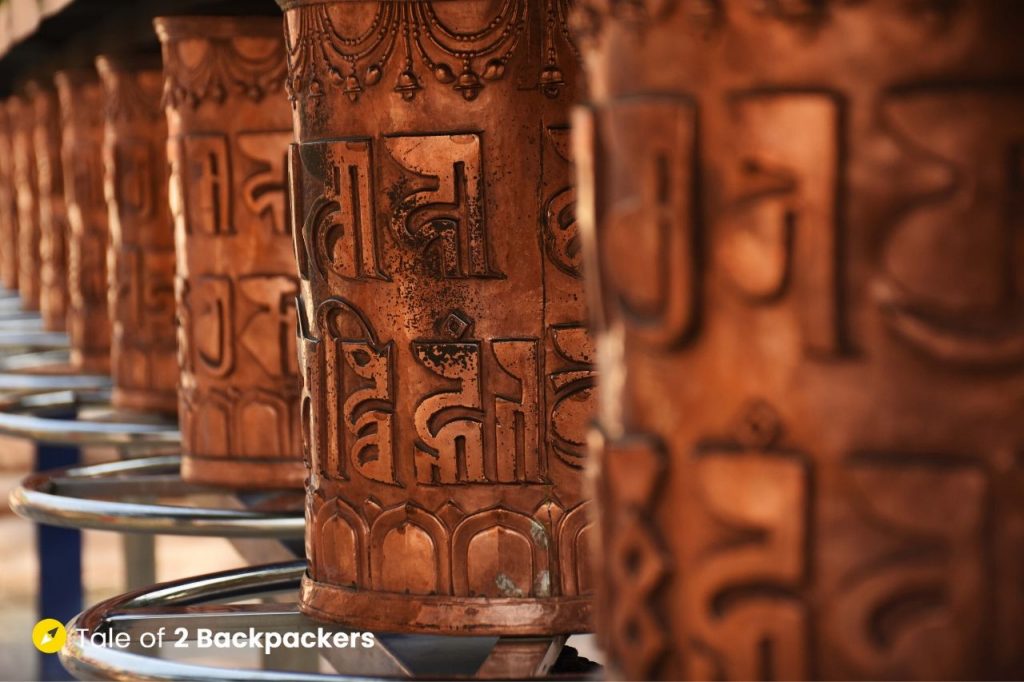
The Chinese temple is located about 600m east from the main entrance of the ancient Buddhist complex in Sarnath. The temple is simple in structure, but the place is extremely peaceful.
The Chinese Temple was built in 1939 by the abbot of Beijing Tao-Kai and the President of Eastren Asia Buddhist Association Fa-Yuan-Tsu . There is an information board in the temple complex showing the route taken by Hiuen Tsang who embarked on a journey towards India from China in 629 AD and travelled extensively in Northern India between 635 AD to 645 AD. He had documented his experiences in India in his journal which is a great historical source of information for scholars.
Inside there is a small statue of Lord Buddha in seating position. The entire complex exudes calm and tranquility. This was definitely one of the most beautiful places we visited in Sarnath.
Giant Buddha Statue and the Thai Temple

The Giant statue of Buddha completely mesmerized us. It is said to be the tallest statue of Lord Buddha in India. After seeing the beautiful frescoes at Mulgandha Kuti Vihara, we visited this place next. The colossal statue of Lord Buddha and the Thai Temple is located within 2.5 acres of a beautiful lush green garden with flowering plants and fountains.
The complex is located about 300 m south to the ancient Buddhist complex in Sarnath. The construction of the statue was started in 1997. However, the idea of the statue was the brainchild of Rasmi Sashan, a Buddhist monk from India and Prakash Samadhiguna . They had thought of building such a statue almost 27 years back. Work started in 1997, only to be stopped after 3 years. The construction work again resumed in November 2006.
The statue was finally completed and unveiled in March 2011. The estimated cost of building the statue was around two lakh fifty thousand Pounds and the money was donated by Buddhist devotees and other people all around the world.

The impressive and imposing statue stands at a height of 25m and its beauty is enhanced by the fountain in front of it and the beautiful garden surrounding it.
At one corner of the garden stands the Thai Temple. This beautiful small red temple is known as the Hinayana Buddha temple and also as Wat Thai Temple by the Thais. The Thai Temple was built in 1933 by Thai dignitaries. The temple is surrounded by a number of statues of Lord Buddha. There is a statue of laughing Buddha and the statue depicting Lord Buddha preaching his first sermon to his followers.
The Thai Temple is one of the most visited places in Sarnath after the main archaeological complex in Sarnath. The place is quite beautiful.
Tibetan Temple or Lhaden Chenmo Tibetan Monastery

The Lhaden Chenmo Tibetan Monastery, also known as the Tibetan temple is located about 600 m south-east from the ancient Buddhist complex at Sarnath. The monastery was built in 1955 and is the first monastery and temple to be built in India by His Holiness Dalai Lama, XIV .
The entrance of the monastery is flanked by carvings of two lions. Once you enter the complex, there is a pink coloured stupa. It has been built by the Tibetans to show their gratitude to the Indian Government for granting them asylum in India. The main temple is beyond this stupa. There are some beautiful frescoes adorning the walls of the temple. Inside, there is a huge statue of Sakyamuni Buddha, in a resting position.
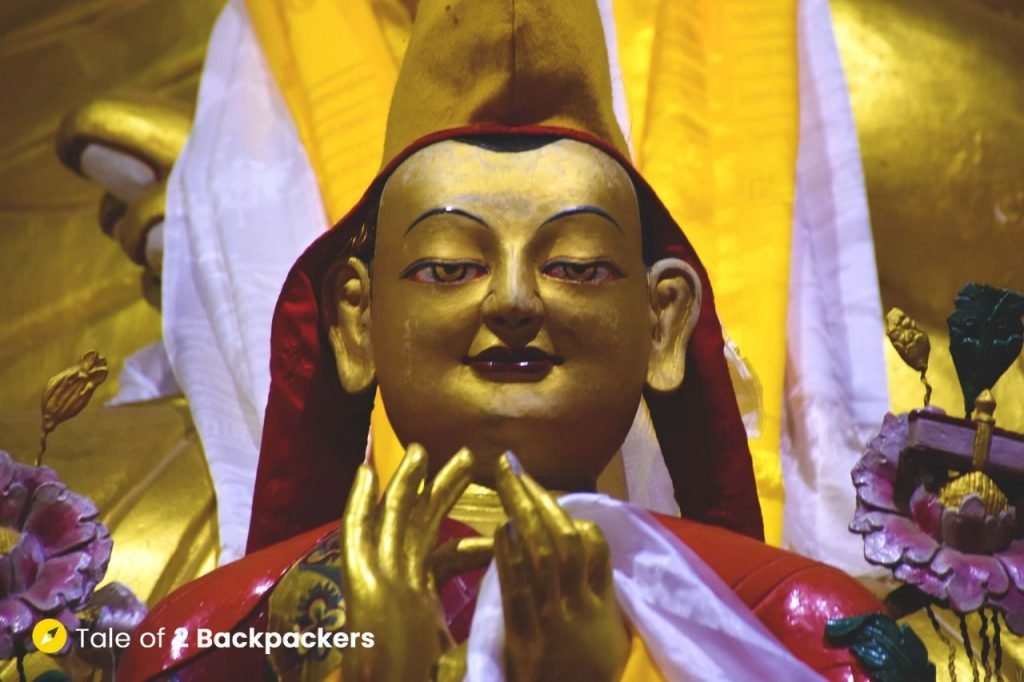
It is possible to stay overnight in the monastery next to the temple by paying a small donation. We definitely wish to stay at this place the next time we visit Varanasi and explore Sarnath more at our will.
Archaeological Museum, Sarnath
The Sarnath Archaeological Museum is a treasure trove of Buddhist artifacts. There are many statues and idols of Buddhas and Bodhisattvas along with other valuable treasures. The Lion Capital from the Ashokan Pillar is also placed inside the Museum. The Lion Capital is the National Emblem of India.
The Museum remains open from 10 AM to 5 PM and remains closed on Friday.
Our Trip from Varanasi to Sarnath
After watching Subah-e-Banaras at Assi Ghat and having a sumptuous breakfast of Kachori and Sabzi, we decided to go for a trip from Varanasi to Sarnath. We looked for an auto and after a bit of bargaining, we zeroed on to one. The auto would take us to Sarnath, take us around the place and bring us back to Varanasi.

We took the road from Varanasi to Sarnath and finally reached our destination. The auto stopped in front of the Mulagandha Kuti Vihar first. We explored the place and visited the famous Bodhi Tree just adjacent to the place. After this visit, the auto driver took us to a place where there were a few guides. One of the guides approached us and offered his services. We did not want to take a guide with us, but he was quite insistent. Instead of Rs.100 that he asked first, he now agreed to guide us for Rs.50. I felt a little bad and agreed to take him on. I thought that might be the tourist season is lean and an Rs.50 will not quite break my bank.
But little did we know that the problem with guides were elsewhere. He took us to the Buddha Statue and Thai Temple and told us a few stories (things that we already knew). Then he suddenly asked us whether we would like to see some weavers in Sarnath. I have a keen interest in handloom and so I wanted to go there. He took us to a small room where a person was weaving. And then he took us to a saree shop. That’s when we understood that he was waiting for his commission when we buy something from the shop.
YOU MAY ALSO LIKE : BANARASI SILK SARI – THE PAST, PRESENT & FUTURE
We did not buy anything and came out. Well, he did look a bit disappointed. Then we arrived in front of the Sarnath Buddhist Complex. He told us a bit about the place and informed us that the tour has ended! We were a bit confused. Our auto driver also said that after the Complex and the Museum, we would return back to Varanasi.
That was the last straw. I got really angry. Agni would not say anything, but I had to yell at the auto driver that if he did not take us to the rest of the places, we would not pay him a single penny and he can simply leave us at Sarnath and go. We would find some other means of transport to return.
After a bit of disagreement, we decided to leave the auto. We paid him half the amount decided and explored Sarnath on our own. I think that was the best decision we made. Not only we explored the place in peace, we also did not have to look at our watch every now and then.

Sarnath is basically a compact place and almost all the monuments and temples are within a short distance from each other. You can highly walk around and explore the place.
Our trip from Varanasi to Sarnath was a beautiful one, inspite of the little problem we had. We explored the place at our own pace and enjoyed each moment spent there. We, however, could not visit the Burmese Buddhist Temple and the Museum.
How to reach from Varanasi to Sarnath?
Sarnath is located only 10 km from Varanasi. From Varanasi, you can hire an auto or car for a day trip to Sarnath. If you are getting a random auto from the road, we would suggest you to talk to him about the places he would take you and the rate beforehand. Or else, you might face the problem we did.
Where can I stay at Sarnath?
There are a few hotels at Sarnath, if you wish to stay there. The Tibetan Monastery also offers place for staying for tourists against donation. Otherwise, you can stay at Varanasi and make a day trip to Sarnath.
How to commute within Sarnath?
You can hire an auto for going around Sarnath. It is a small and compact place and all the attractions are located within a short distance. You can also walk around to explore the place.

Did you like this blog? If you found this article useful, please share it your you family, friends, neighbours and anyone you like to. Please share your thoughts about Sarnath by commenting below.
Pin this for a later read!

Agni Amrita
Related posts.
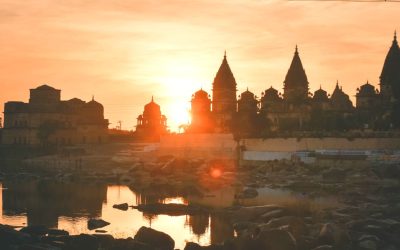
Best Places to Visit in Orchha – A Complete Travel Guide
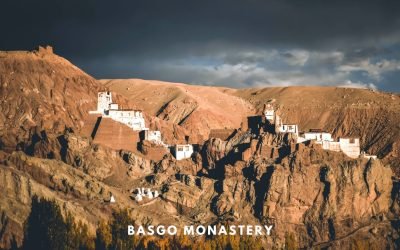
Basgo Monastery, Ladakh – Ruins of Palace and Fort

Rani ki Vav, Patan – The Queen of Stepwells Built by a Queen
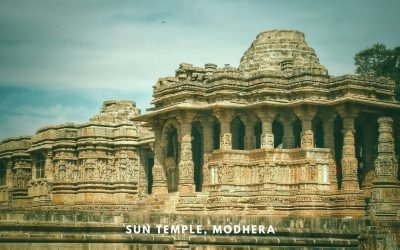
Sun Temple Modhera, Gujarat – History, Architecture & Interesting Facts
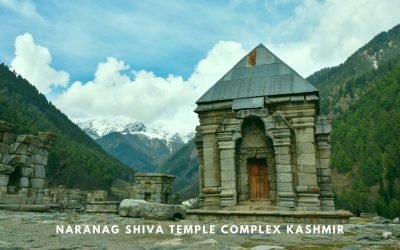
NARANAG TEMPLE COMPLEX – Ancient Shiva Temple of Kashmir

Chausath Yogini Temple Morena – Looking for the Esoteric in Mitawali
Submit a comment cancel reply.
Your email address will not be published. Required fields are marked *
Submit Comment
This site uses Akismet to reduce spam. Learn how your comment data is processed .
Pin It on Pinterest

14 Best Places to Visit in Varanasi
Written by Joni Sweet Updated Mar 20, 2023 We may earn a commission from affiliate links ( )
The best places to visit in Varanasi give you the chance to experience the spirituality of India at its most vibrant. Head to the Banaras ghats to watch Hindu devotees wash away their sins in the Ganges River each morning and return for fire-fueled prayer ceremonies as the sun sets.
You can see perpetually burning funeral pyres at the Manikarnika Ghat, a holy cremation ground for Hindus. Feeling inspired? You can deepen your connection with this side of Indian culture by releasing your own floating offering, available from vendors along the ghats.
More than a spiritual center, Varanasi also has a strong artistic side . Visit the museum at Banaras Hindu University to see a fantastic collection of miniature paintings or try creating your own masterpiece in a hands-on workshop at Ruchika Art Gallery. When you need a pick-me-up, make your way to Vishnu Tea Emporium for a cup of the best chai in India (along with tea souvenirs to bring home).
Discover more of this ancient city with our list of the best places to visit in Varanasi.
1. Ganges River
2. dasaswamedh ghat, 3. assi ghat, 4. manikarnika ghat, 5. dhamek stupa, 6. shri kashi vishwanath temple, 7. banaras hindu university, 8. ruchika art gallery, 9. shri durga temple, 10. ramnagar fort, 11. darbhanga ghat, 12. shivala ghat, 13. sankat mochan hanuman temple, 14. vishnu tea emporium, map of places to visit in varanasi.
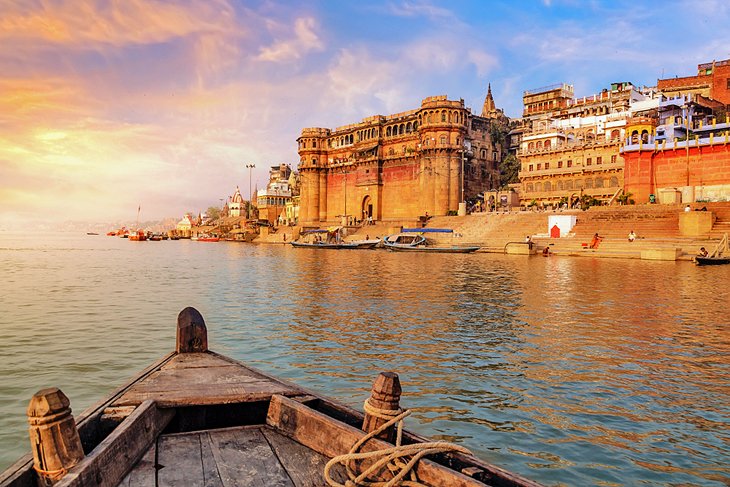
Named after the Hindu goddess Ganga, the Ganges River is one of the most revered natural sites in India. The river extends southeast from the Himalayas in the north to the Bay of Bengal. Between 400 million and 600 million people rely on the Ganges River to provide water for daily bathing and drinking.
Hindus come to Varanasi from all around the world to purify themselves in the holy Ganges water and perform rituals along the dozens of ghats along the river . For tourists, the river helps provide a fixed point of orientation for navigating around the labyrinthine city, and you'll no doubt spend lots of time sightseeing and watching life happen around the Ganges.
Consider waking up early and taking a sunrise cruise along the river — negotiate with one of the countless boatmen hanging out along the ghats.
In the afternoon or early evening, one of the top things to do in Varanasi is to purchase a small floating offering filled with fresh flowers and a candle , and release it onto the Ganges River. The blissful experience will connect you more deeply with Hindu culture and stay in your mind for years to come.
Read More: Best Things to Do in India
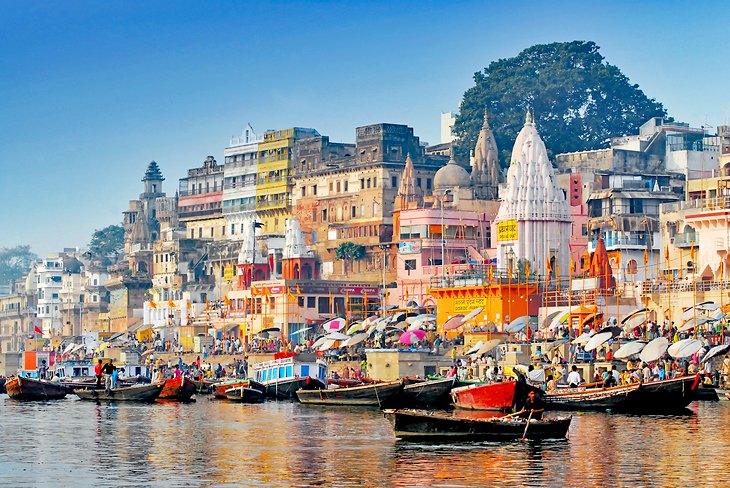
The lively atmosphere of the Dasaswamedh Ghat makes it one of the best places to visit in Varanasi. This tourist attraction is a swirling hodgepodge of flower sellers touting bright blossoms, boat operators hawking rides along the Ganges River, and sadhus (holy men) with face paint. You can spend hours people-watching in this area during the day.
Hindu priests put on the Ganga Aarti every night at the Dasaswamedh Ghat, starting at around 7pm. Donning saffron-hued robes, the priests spread out plates of flower petals and other offerings and blow a conch shell to signal the start of the spiritual ceremony.
Thousands of tourists gather to watch the priests chant and wave tiered plates of sandalwood-scented incense in intricate patterns for about 45 minutes. It's an extravagant sight and one of the top things to do here.
Hot tip: Get to the ghat at least a couple of hours early if you want to beat the crowds and score a great spot for the show. You can also get incredible views from boats along the river or from shop balconies above the ghat.
Address: Dasaswamedh Ghat Road, Bangali Tola, Varanasi
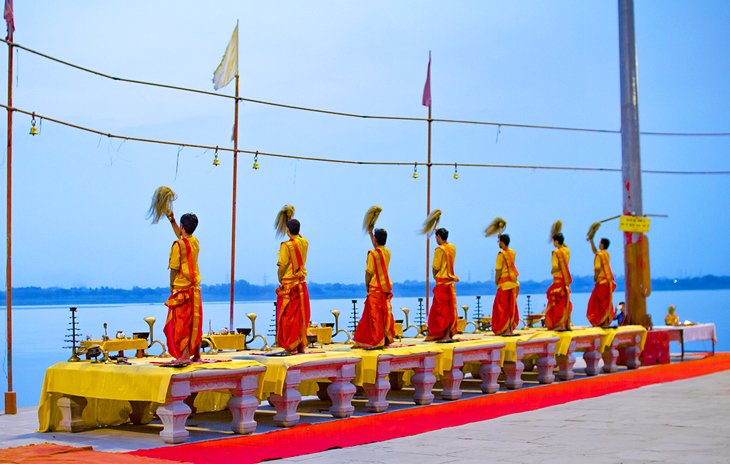
When it comes to famous places to visit in Varanasi, the city's southernmost main ghat regularly tops the list. Assi Ghat's star attraction is a Shiva lingam (phallic representation of the Hindu deity) beneath a sacred fig tree. It draws hundreds of pilgrims every day, who come to worship Lord Shiva after rinsing in the Ganges River.
Feeling a little stiff from traveling? Swing by Assi Ghat at sunrise, when you can get your downward-facing dog on with dozens of others during free morning yoga classes accompanied by live music every day. Tourists can also see another Ganga Aarti performance here in the evening, which is slightly smaller and more intimate than the one at Dasaswamedh Ghat. It typically starts around 6:30pm.
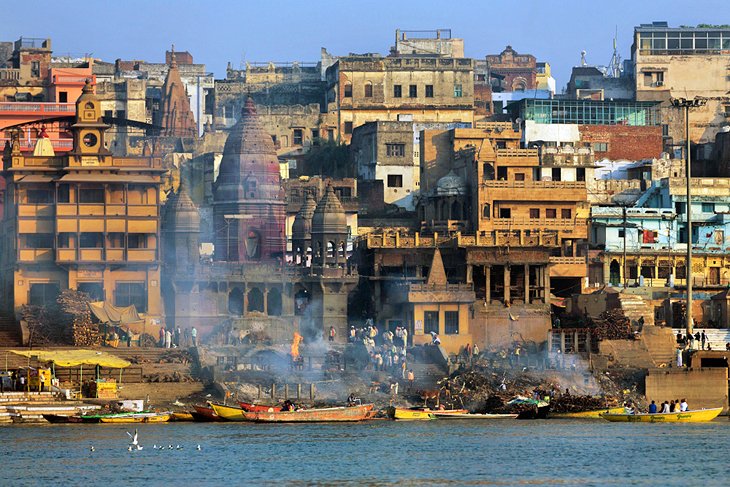
Plumes of smoke swirl toward the sky at Manikarnika Ghat. No, it's not from a factory — it's from the perpetual cremations that happen on this ghat. Hindus believe that Manikarnika Ghat is one of the most auspicious places for the departed to reach moksha (emancipation from the cycle of spiritual rebirth). The funeral pyre at this ghat burns 24/7, and the flame that feeds it is believed to have been lit for centuries. Roughly 100 cremations take place at this site every day.
Priests or guides frequently offer to lead tourists through the fascinating ghat; however, some can be aggressive in their demands for money. You may see doms (members of an untouchable caste) carrying cloth-wrapped bodies on makeshift stretchers, along with piles of firewood stacked up, ready to feed the pyre.
You may also be offered the chance to see a cremation up close — for a fee, of course. While profound, the experience is not for the faint of heart, nor is it a tourist attraction in the traditional sense. Know your limits; be respectful; and avoid taking photos of the funerals, mourners, and the departed.
Hot tip: If you're interested in the ritualistic cremations, but can't stomach the idea of seeing them up close, consider passing by Manikarnika Ghat on a boat tour along the Ganges River . The distance dampens the effect while still giving tourists a sense of what's happening in this important place.
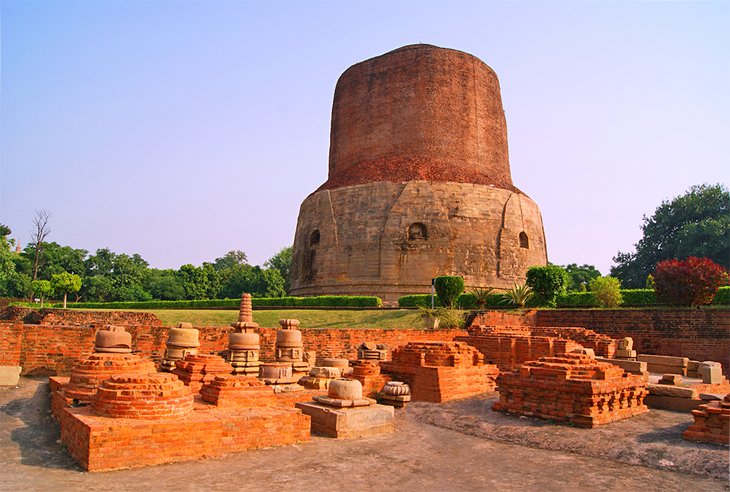
Hinduism certainly has a stronghold on Varanasi, but Buddhism has a major presence less than 12 kilometers away in the village of Sarnath . Here, you'll find the Dhamek Stupa, a massive stone and brick structure that's 43.6 meters tall and 28 meters in diameter. The stupa was built more than 1,500 years ago as a replacement for a structure that dated back to 249 BCE.
The devout believe that the Buddha came to Dhamek Stupa to give his first sermon, which revealed the Eightfold Path after he achieved enlightenment. Take a look at the elegant carvings of birds, people, and flowers that cover the walls of the stupa as you wander around the attraction.
Sarnath also has plenty of other tourist places that make it a worthwhile day trip destination from Varanasi. Check out the Chaukhandi Stupa (a Buddhist shrine that dates back to at least the 6th century), then make your way to the Sarnath Museum to see the Lion Capital of Ashoka , a sculpture that used to sit atop the Ashoka Pillar in 250 BCE and became the National Emblem of India in 1950.
Round out the day with sightseeing at the peaceful Tibetan Temple, located near the main market, before making your way back to Varanasi.
Address: Dharmapala Road, Singhpur, Sarnath, Varanasi
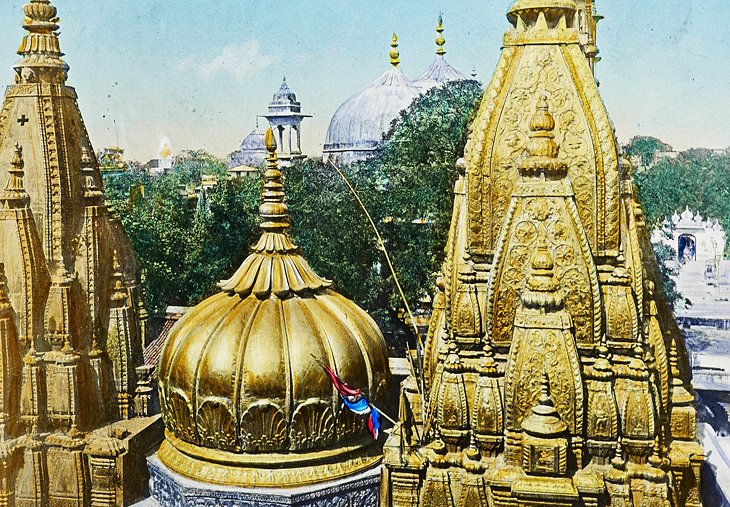
Hindu pilgrims and tourists alike travel for thousands of miles to reach the Shri Kashi Vishwanath Temple , a sacred attraction around four kilometers from the Varanasi Junction railway station near the Manikarnika Ghat .
The impressive structure, dedicated to the Hindu deity Shiva, has earned the nickname "The Golden Temple" for its striking spire — plated in some 800 kilograms of pure gold. The distinctive design of this temple has gone on to inspire the architecture of hundreds of other temples across India.
Strict security measures around the complex require that tourists stash their cameras, phones, bags, and other belongings in a rentable locker nearby. Foreigners will also need to get their passports and visas verified at the Darshan Booking Desk. Expect to ditch your shoes and wait in line with hundreds of other visitors, all eager to touch the 60-centimeter-tall, sin-absolving Shiva lingam in a silver alter . It's an intense, yet rewarding experience
Hot tip: Skip this attraction on Hindu holidays, when devotees wait in line for up to two full days to enter the temple.
Address: Lahori Tola, Varanasi
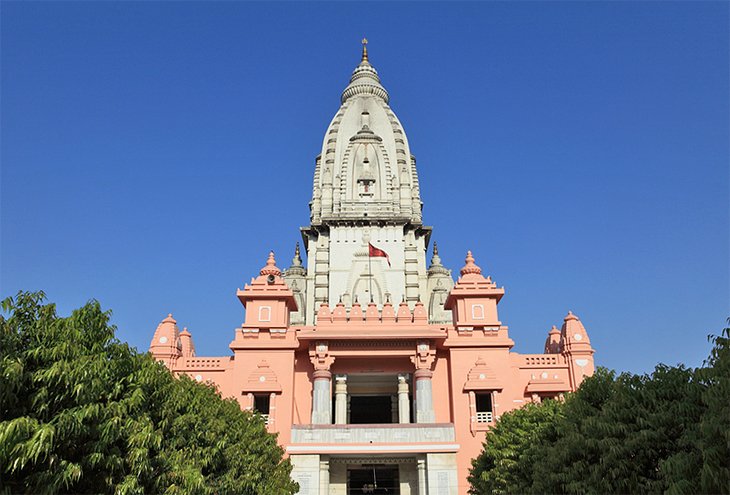
Banaras Hindu University has been a central part of Varanasi's identity since its inception in 1916. The well-respected public university is home to more than 25,000 students, making it one of Asia's largest residential universities.
There are no hill stations near Varanasi, so if you're looking for an escape from the crowds and busy city, come to this lush 1,300-acre campus. The serene area is shaded by hundreds of tall trees and offers a breath of fresh air from the hectic atmosphere at the Banaras Ghats.
While on campus, swing by the New Vishwanath Temple, a famous temple that finally finished its decades-long construction in 1966. Standing 77 meters high, the temple is one of the tallest in India and draws architectural inspiration from the nearby Shri Kashi Vishwanath Temple.
Visitors to the university should also make a point to explore the on-campus museum, Bharat Kala Bhavan . The cultural institution features a spectacular collection of miniature paintings , along with over 100,000 other artifacts of archeological and artistic importance.
Want to take a piece of Varanasi home with you? Look no further than the Ruchika Art Gallery , just off Ravindrapuri Road . The gallery's namesake owner, Ruchika Mehrotra, has created a warm, delightful shop to display a vibrant collection of paintings that capture the energy of Varanasi and the ghats in a rainbow of colors.
While there are some larger works that would require shipping, many of the paintings are small enough to pack in a suitcase as souvenirs. There are also charming postcards available for purchase.
In addition to showcasing locally made creative works, Ruchika Art Gallery also invites tourists to pick up a paintbrush during artistic workshops . Get in touch with Ruchika to see what's on the calendar during your trip to Varanasi.
Address: 1 Ground floor, Shwetabh Building, near Sankat Mochan Mandir and Lanka Post Office, Lanka Road, Varanasi
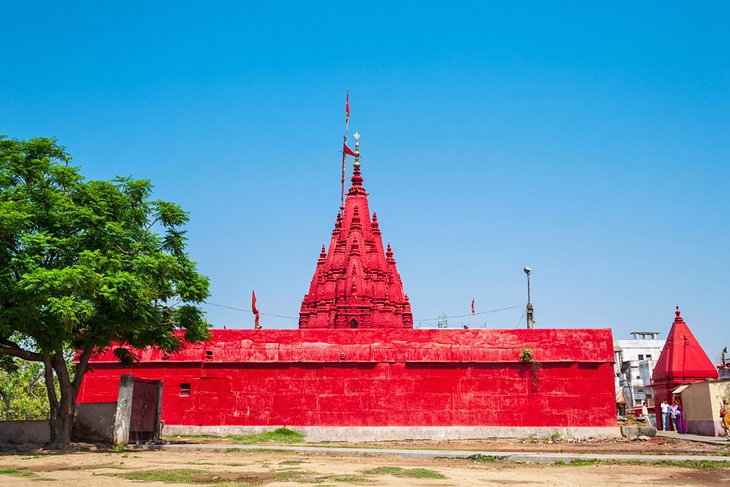
Spiritual activities around Varanasi aren't solely confined to the ghats. Just a five-minute walk west of Assi Ghat , the Shri Durga Temple is a popular attraction for Hindus who wish to pay tribute to the goddess Durga. You can't miss the 300-year-old temple — it's painted bright red from top to bottom.
The temple's nickname, "Monkey Temple," gives you a clue about the creatures you might find swinging about in this area. You may also see a couple of graceful swans floating on the pool of water outside the temple.
Address: 27, Durgakund Road, Durgakund, Anandbagh, Bhelupur, Varanasi
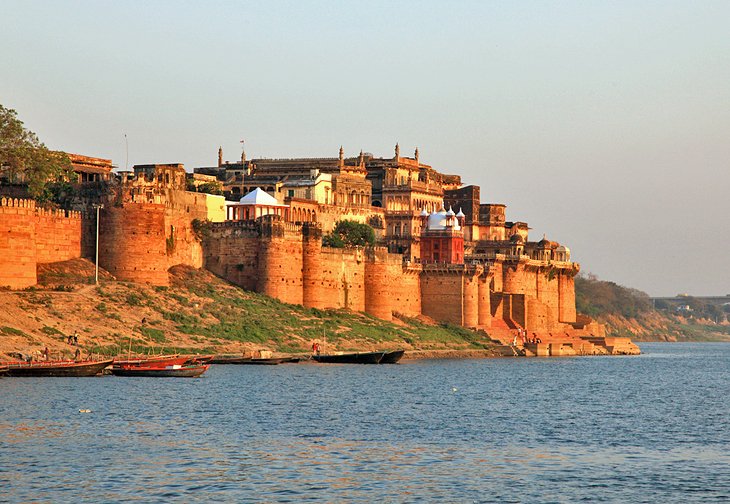
There are few destinations in India without a fort, and Varanasi is no exception. About 14 kilometers from the city center, you'll find Ramnagar Fort.
The 18th-century sandstone fort and palace is no longer used as a defensive structure but instead houses a quirky museum brimming with vintage automobiles, elaborate hookahs, antique weapons, sedan chairs decked out in jewels, and a one-of-a-kind astronomical clock that's more than 150 years old.
After enjoying an archeological treasure hunt at the museum, check out the fort's temples, one of which honors Veda Vyasa, author of the Mahabharata and other important Hindu epics.
Address: Mirzapur - Varanasi Road, Purana, Ramnagar
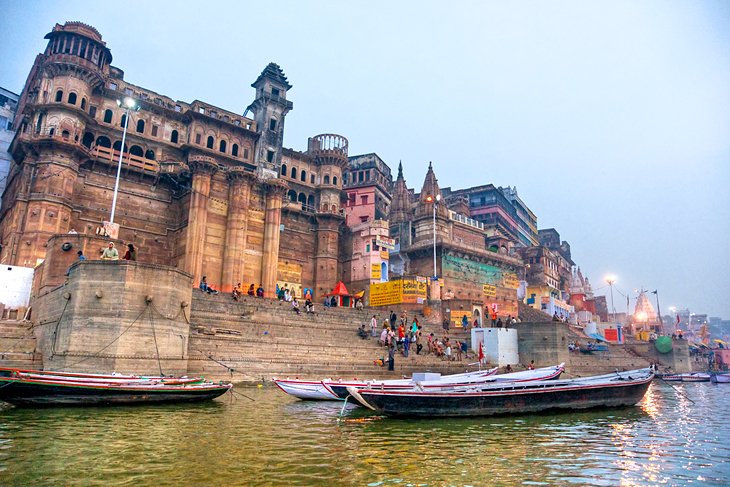
Photographers, take note: Darbhanga Ghat offers the best opportunity to get amazing shots of Varanasi. The stairs leading down to the riverbank are crowned by the ultra-luxurious BrijRama Palace , an old fort that has since been converted into a heritage hotel. The property's Greek pillars and rounded balconies give the area (and your photographs) a regal backdrop.
Plan to get here around dawn to capture unobstructed views of the incredible sunrise over the horizon of the Ganges River.
Location: Near Ahilyabai Ghat, Bangali Tola, Varanasi
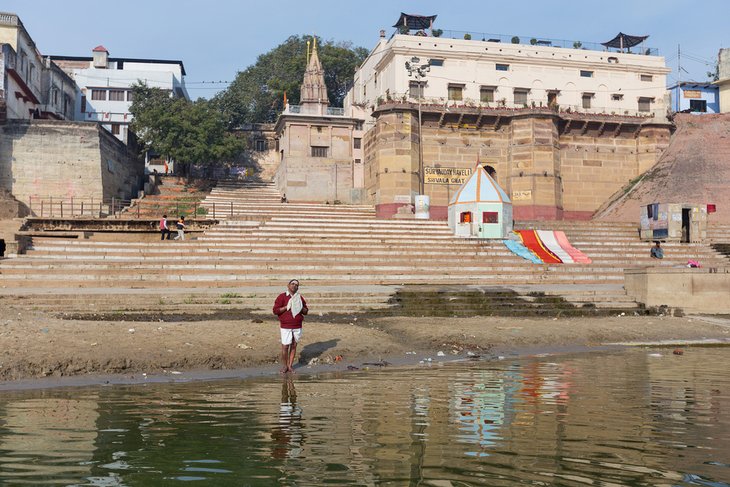
While not as active as other riverfront spots in Varanasi, Shivala Ghat is a pleasant place to visit if you're looking for some peace and quiet along the Ganges.
The lack of crowds at the ghat makes it easier to respectfully observe the devout doing their ritualistic dips in the holy river and families gathering for prayers and tea in the morning. Don't be surprised if you wind up sharing the space with water buffalo, which are known to hang about in the area. You can also see a palace built by Nepalese king Sanjay Vikram Shah in the 19th century.
It's also worth devoting a few hours to wander the maze-like alleyways leading to Shivala Ghat. The densely packed neighborhood offers a glimpse at what everyday life is like for locals in Varanasi.
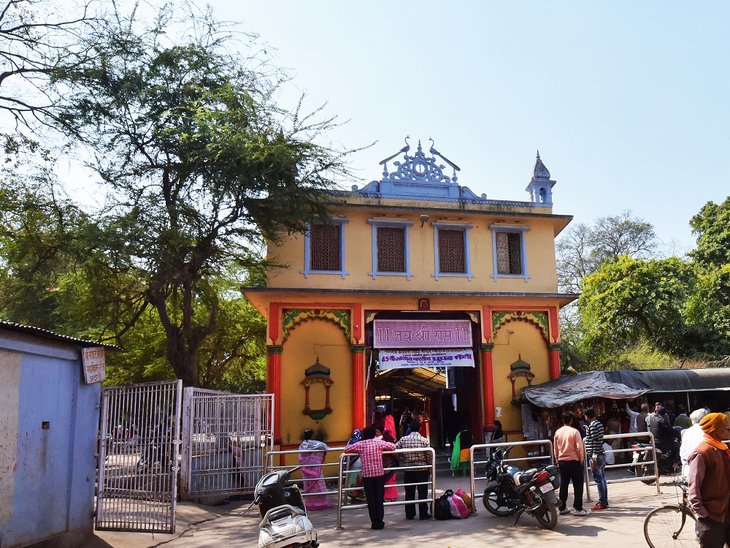
Situated on the banks of the Assi River, the Sankat Mochan Hanuman Temple draws thousands of visitors a day, all eager to make an offering of sweets and flowers to the Hindu god Hanuman.
Legend has it that this temple was constructed exactly where Hindu saint and poet Goswami Tulsidas had a vision of the monkey god. Speaking of monkeys, keep your eye out for the mischievous creatures who are regularly spotted bouncing around the temple.
Hot tip: April or May can be a particularly great time to visit this Varanasi attraction. That's when the temple hosts its annual "Sankat Mochan Sangeet Samaroh," a festival of classical music and dance recitals held over a series of five to six days. Performers come from all over the world to take part in the nearly 100-year-old event.
Address: Sankat Mochan Road, Padampuri Colony, Jawahar Nagar Colony, Bhelupur, Varanasi
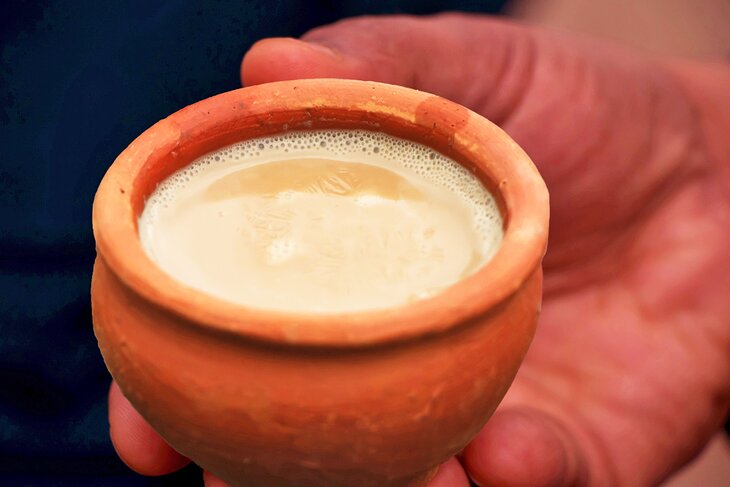
Tea is practically a way of life in India — you're almost never more than a few steps away from a chaiwala (tea seller) whipping up spicy, creamy masala chai from roadside stands.
Take a deep dive into this culinary ritual with a visit to the Vishnu Tea Emporium. Just a four-minute walk from Dasaswamedh Ghat, this casual shop offers up-close demonstrations of how to make masala chai from spices and fresh ingredients.
It also offers a curated selection of tasty tea and spice blends for tourists to recreate the classic Indian drink at home. There's no pressure to make a purchase, but this is one souvenir you won't regret buying.
Address: D 15/51 Manmandir, Dasashwamedh Road, Varanasi

More on India
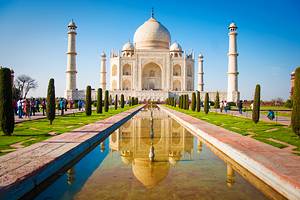
- SKIP TO MAIN CONTENT
- उत्तर प्रदेश सरकार
- Government of Uttar Pradesh
- A+ Font Size Increase
- A Normal Font - Selected
- A- Font Size Decrease
- A High Contrast
- A Normal Contrast - Selected

- Tourist Places
Sarnath is a place located 10 kilometres north-east of Varanasi near the confluence of the Ganges and the Varuna rivers in Uttar Pradesh, India. The deer park in Sarnath is where Gautama Buddha first taught the Dhamma, and where the Buddhist Sangha came into existence through the enlightenment of Kondanna.
Photo Gallery

How to Reach:
The nearest airport to Sarnath lies at Varanasi - the cultural capital of India. Varanasi Airport at Babatpur is located about 30 km from Sarnath. It is one of the important domestic airports in India. Almost all public and private airlines in India operate regular flights to and from Varanasi. From Varanasi you can avail direct flights to cities like Delhi, Mumbai, Khajuraho, and others. You can also board flight from Kathmandu to reach Varanasi.
Sarnath has a railway station of its own, which is connected to Varanasi and Gorakhpur by passenger trains. The nearest railhead to Sarnath is at Varanasi too, which is one of the major railway junctions in the region. Varanasi railway station is connected to the rest of India by a large number of important trains. There are train links from Varanasi to various cities within Uttar Pradesh as well as cities in other parts of India like New Delhi, Mumbai, Kolkata, Agra, Lucknow, Bangalore and Ahmedabad, to name a few.
Sarnath in Uttar Pradesh is well connected with other parts of the state by decent roadways. The nearest mega terminus from Sarnath lies at Varanasi, about 10 km downtown from Sarnath. Varanasi is well connected by bus with major cities like Lucknow, Bareilly, Kanpur, Allahabad, Agra and Mathura. Regular buses run by Uttar Pradesh State Road Transport Corporation as well as private operators ply from Varanasi to these destinations. Hence, Sarnath is easily accessible by road from Varanasi and other major destinations in Northern India.
Sarnath Travel Essentials
Ideal duration: 1 day
Best Time: October to March Read More
Planning a Trip? Ask Your Question
"One of the four holiest places to the Buddhists"
Sarnath tourism.
A quiet and spiritual town set amidst the otherwise densely populated state of Uttar Pradesh, Sarnath is a city of historical marvel with numerous Buddhist stupas, museums, excavated ancient sites and beautiful temples that prove to be a source of immense wonder and astonishment to tourists due to their mystical and serene setting. Being just 10 kms from Varanasi, Sarnath is often flocked with devotees is the perfect pilgrimage site for Buddhists, Jains and Hindus, alike.
A pilgrimage place for Buddhists, Sarnath features a number of temples and completely serene surroundings with its various historically significant, architectural marvels. Being the place where Lord Buddha preached his first sermon, Sarnath has since been a popular tourist attraction and is well known for its cultural significance as well as the mystical setting. To name a few attractions contributing to the spiritual significance of Sarnath, we have, Ashoka's Pillar, Dharma Stupa built by Emperor Ashoka and many more.
Places To Visit In Sarnath

Dhamek Stupa

Sarnath Archaeological Site

The Mahabodhi Society Temple

Chaukhandi Stupa

Ashoka Pillar, Sarnath

Thai Temple
Top Hotels In Sarnath
9.8 (57 reviews)
₽ 42,175 onwards
9.5 (95 reviews)
₽ 3,328 onwards
9.5 (52 reviews)
₽ 5,972 onwards
9.3 (107 reviews)
₽ 2,884 onwards
9.3 (44 reviews)
₽ 3,550 onwards
9.1 (629 reviews)
₽ 7,991 onwards
More on Sarnath Travel
History of sarnath, the city of enlightenment, ancient buildings and structures, restaurants and local food in sarnath, suggested itinerary for sarnath, best time to visit sarnath, nearby places.

How to Reach Sarnath
How to reach overview, how to reach sarnath by flight, how to reach sarnath by road, how to reach sarnath by train, local transport in sarnath, browse package collections, nearby destinations for packages, sarnath photos.

+ 22 photos
How To Reach Sarnath
Faqs on sarnath, what is the best time to visit sarnath, what are the places near sarnath, what are the things to do in sarnath, what are the top hotels in sarnath, what is the best way to reach sarnath, what is the local food in sarnath, who should visit sarnath, what is not so good about sarnath, what is famous about sarnath, have a question on sarnath.

Popular Questions And Answers on Sarnath
Q. What kind of Lord Buddha's possessions are on display at the museum here?

Pallavi Siddhanta
Sarnath Reviews
Kovid Kapoor
Similar Places

Get the best offers on Travel Packages
Compare package quotes from top travel agents
Compare upto 3 quotes for free
- India (+91)
*Final prices will be shared by our partner agents based on your requirements.
Log in to your account
Welcome to holidify.
Forget Password?
Share this page

- Destinations
15 Best Places to Visit in Varanasi for First-Timers
Varanasi is one of the oldest living cities in the world and is a hub of spirituality, history and culture. Be sure to check out these top places to visit in Varanasi, India!

Varanasi is one of the top destinations in India and is unlike any other city in the country. It’s known as the City of Temples and the Spiritual Capital of India! Situated along the sacred Ganges River in Uttar Pradesh, there are many reasons tourists are drawn to Varanasi.
The city is full of bustling alleys, ancient temples, vibrant ghats and delicious food shops. It’s a popular pilgrimage site for Hindus and is a historically significant city along the mystical Ganges. There are so many places to visit in Varanasi when you travel here!
Having lived in India for several years, my trip to Varanasi was one of my most memorable experiences in India. I was overwhelmed by the narrow roads, the cremation of bodies along the river, and the remarkable views of the city with such a vibrant culture. I’d highly recommend Varanasi for anyone that plans to travel to India!
This list highlights the best places to visit in Varanasi for people traveling to the city for the first time! Enjoy these spots for an authentic insight into life in the city and the rich history that made Varanasi what it is today.
Related Posts:
8 Famous Tourist Attractions in India You Have to Visit
Travel Guide to India: Everything You Need to Know to for a Great Vacation!
Ultimate India Packing List: 49 Must-Haves to Bring on Your Trip
This post is all about places to visit in Varanasi.
Best Places to Visit in Varanasi
#1 dashashwamedh ghat.
Dashashwamedh Ghat is a must-see for anyone traveling to Varanasi! It’s an authentic glimpse into the city’s vibrant culture and spirituality along the majestic Ganges River.
What makes this ghat one of the most popular in Varanasi is because of the Ganga Aarti that happens every evening when the sun sets. Many people come here to watch the ritual and offering to the river, and it is one of the best experiences in Varanasi! During the Ganga Aarti, pandits, or priests, gather by the river front and perform a ceremony with fire, incense, hymns and choreographed movements.
Dashashwamedh Ghat is also bustling during the day too. Pilgrims cleanse themselves in the Ganges and boats float along in the river. It’s a very lively and bustling vibe and full of people.

#2 Kashi Vishwanath Temple
Kashi Vishwanath Temple is one of the most famous temples in Varanasi. The city is full of temples, but the beauty and ancient history draws visitors and devotees.
The temple is dedicated to Lord Shiva, one of the three major deities in Hinduism. The Jyotirlinga, a sacred representation of Lord Shiva, is inside the temple. It’s believed that viewing the linga can free someone from the cycle of birth and death.
The temple is full of ancient history. It has been destroyed and rebuilt many times over thousands of years due to various conflicts and invasions. Most recently, it was re-constructed in the 19th century. The architecture is beautiful and has many intricate designs and carvings.
The temple is open everyday until 11pm and is free to enter. You can participate or watch people offer puja, or prayers, and perform rituals throughout the day. Since it’s a temple, you should dress modestly and you’ll need to remove your shoes before going inside.
#3 Assi Ghat
The Assi Ghat is where the river Assi meets the Ganges. Unlike the bustling Dashashwamedh Ghat, Assi Ghat is known for its serene atmosphere.
It’s a popular spot for yoga and meditation. You can spend time sitting on the steps and soaking in the city in a relaxed way. It’s also a popular spot to see the sunrise and sunset which offer stunning views. Even if you aren’t interested in yoga or meditation, it’s a peaceful respite from the lively city.
#4 Banaras Hindu University (BHU)
Banaras Hindu University is one of the top places to visit in Varanasi. It has a rich cultural heritage and is architecturally beautiful. It’s one of the most prestigious universities in India and is famous for its academic excellence and history.
You can explore the campus and relax on the spacious lawns. There are also guided tours for visitors and sometimes they offer cultural shows, exhibitions and various events.
#5 Bharat Kala Bhavan Museum
The Bharat Kala Bhavan Museum is located in the BHU campus. It’s a well-designed museum that showcases a collection of paintings, sculptures, textiles and artifacts. If you’re interested in learning more about India’s cultural heritage, it’s the perfect stop.
When looking for the best places to visit in Varanasi, this museum doesn’t always make the list. But I think it is one of the hidden gems of the city and gives beautiful insight into the past. The treasury room is especially interesting!

#6 Manikarnika Ghat (one of the most memorable places to visit in Varanasi)
Manikarnika Ghat is a very old and sacred ghat on the holy Ganges River. It’s one of the most famous places to visit in Varanist because it’s recognized as the cremation ghat. Hindu cremation rituals are performed all day because it’s believed that being cremated here ensures liberation from the cycle of death and rebirth.
The ghat has been mentioned in scriptures and texts for centuries. It’s also believed that Lord Shiva dropped his earring (manikarnika) here while dancing.
Visitors can sit on the steps of Manikarnika Ghat and the view can be overwhelming. You will see cremations and rituals being carried out. There is a constant flow of cremation fires happening on the banks of the river and it’s an experience you will never forget.
#7 Ramnagar Fort
Ramnagar Fort is on the eastern bank of the Ganges River and is a historical marvel among the city. The architecture is absolutely stunning and shows a blend of Mugal and Rajput styles. There’s carved balconies and intricate designs throughout the fort.
Explore the fort and museum that has a nice collection of vintage artifacts and weapons. There is also a Durga Temple dedicated to the Goddess Durga which many tourists visit.
If you happen to be traveling to Varanasi in October or November, you should check out the Ramnagar Ramlila that happens for Dusserha. It’s a dramatic reenactment of the ancient Hindu epic, the Ramayana. The festival is hugely celebrated in the region and the fort is a great place to experience the festivities!
#8 Jantar Mantar
The Jantar Mantar is one of the best places to visit in Varanasi for history buffs and anyone interested in astronomy. It’s a collection of astronomical instruments built in the early 18th century.
There are several large-scale instruments made of stone and masonry. The instruments were meticulously designed and aligned to witness and observe celestial phenomena. It showcases the technological and scientific advancements of their time.
Some of the most remarkable instruments include the Samrat Yantra (giant sundial) and Dhruva Yantra (north-south pole indicator). Visitors can explore the various instruments on your own or with a guided tour if you are really interested in learning more.

#9 Dhamek Stupa, Sarnath (one of my favorite places to visit in Varanasi)
Sarnath is an area outside the heart of Varanasi and absolutely worth visiting. It’s famous because it’s where Lord Buddha delivered his first sermon after attaining enlightenment. The Dhamek Stupa is a structure marking the spot where Buddha preached and is a symbol for Buddhism’s origins.
In Sarnath, you can also visit the Ashoka Pillar. The area near the Ashoka Pillar is full of green lawns and various ancient structures. It’s also near the Sarnath Museum which is an archeological museum full of various artifacts and relics and is perfect to learn more about the rich Buddhist history in the city.
#10 Sankat Mochan Temple
Sankat Mochan Temple is a famous temple dedicated to Lord Hanuman, popularly recognized as the monkey god. He is a symbol of strength, devotion and protection in Hinduism.
The temple has an ancient history and is full of intricate carvings and sculptures. Visitors can see the Hanuman idol and offer a puja, or prayer. Sankat Mochan translates to “reliever of troubles” and some people believe that praying here can alleviate difficulties in life.
There are regular Aartis or prayer ceremonies offered here. Dress modestly and remove your shoes before entering. Tuesdays and Saturdays are usually more busy at the temple because they are considered auspicious days for Lord Hanuman.
#11 Chunar Fort
Chunar Fort is situated on the banks of the River Ganges outside the busy heart of Varanasi. It has a rich history going back over a thousand years and has been used under the rule of several dynasties. The architecture is beautiful and is a mix of various styles due to the renovations throughout history.
Explore the fort and soak in the massive walls, courtyards and underground passages. There is a central tower that offers panoramic views of the Ganges and surrounding area. It’s a protected heritage site and is a beautiful way to learn about the region’s past.
There is a famous tale associated with the fort and Emperor Akbar. It’s believed the famous musician, Tansen, who played for the emperor’s court, was imprisoned here before showing his musical talents that gained his release. There are many fun stories of Akbar which are especially entertaining for children!
#12 Temples such as Kala Bhairava Temple and Annapurna Temple
Varanasi is famously known as the City of Temples and there are so many that you can visit during your stay! There are literally around 3000 temples, it’s almost overwhelming. Kala Bhairava Temple and Annapurna Temple are two of the best temples to visit if you have extra time.
The Kala Bhairava Temple is dedicated to Lord Bhairava, a manifestation of Lord Shiva. It’s believed to be one of the most powerful temples in the city. Devotees visit this temple to seek protection and blessings from Lord Bhairava, known as the guardian deity and protector.
The Annapurna Temple is dedicated to Goddess Annapurna, the deity of food and nourishment. It’s an ancient temple and many visitors come for blessings in food, nourishment and fulfillment of their daily needs from the Goddess.

#13 Ganges River
While there are many ghats to experience the sacred Ganges, one of the most popular ways is to take a boat ride along the river. It’s a beautiful way to see the city and soak in the stunning views.
There are several ghats where you can start a boat tour, including Dashashwamedh Ghat, Assi Ghat, Raj Ghat and Scindia Ghat. There are various types of tours you can go on with different boats. You can also choose how long of a tour you want, generally between 30 minutes and 2 hours.
I did a simple tour in a rowing boat for one hour and I would highly recommend it! The guide didn’t speak much about the city, but we saw the major ghats and it was the most picturesque way to see the city. Definitely one of the highlights on my trip!
#14 Ghats including Raj Ghat and Tulsi Ghat
Like there are a lot of temples, there are also many ghats to visit in Varanasi! The city is known for having 84 ghats along the Ganges River. Raj Ghat and Tulsi Ghat are two worth-wile spots if you are looking for more ghats to visit during your trip.
Raj Ghat is a less crowded ghat along the river and is known for its tranquil ambiance. It’s a peaceful place to sit and relax and also has beautiful views of the river.
Tulsi Ghat is named after the famous saint poet, Tulsidas. It’s also known for its peaceful vibe and sometimes hosts various cultural events.
#15 Restaurants – you have to try the lassi and chaats!
The food in Varanasi is amazing and there are so many famous dishes to try! These are some of the best restaurants and shops that cover all kinds of foods.
- Baati Chokha Restaurant – This is a bustling spot that’s especially famous for its Baati, a wheat ball, and Chokha, mashed vegetables. It’s a delicious option and super cheap, plus the inside of the restaurant looks really neat with carvings on the wall!
- Shree Shivay Thali – This is a local style restaurant with the best thali! It’s the perfect place for travelers because a thali is a meal that is served on a large plate with tons of different dishes to try in small bowls. This is the best place for a thali to experience the regional food and taste lots of different dishes at one time.
- Kashi Chat Bhandar – This is the best place for trying street food! It’s a small shop that’s famous for their savory snacks. Enjoy delicious chaat, a street food that is famous in Varanasi.
- Blue Lassi – Lassi is a popular drink in Varanasi which is a traditional yogurt-based drink. To be honest, it takes an acquired taste if you ask me, but of course it’s loved by many! Blue Lassi isn’t exactly a restaurant, but it’s a great spot to order lassi and is famous for its variety of flavors and toppings.
- Roma’s Cafe Diner – If you’re looking to take a break from Indian food, Roma’s Cafe is a beautiful restaurant. There’s also rooftop seating with stunning views of the city. It’s famous for its Italian cuisine like pasta and pizza.
You Might Also Like:
Best Places to Travel in India: Top Destinations for Each State
9 Best Things to do in Rishikesh for First Timers
Mawlynnong: A Guide to Asia’s Cleanest Village
This post was all about the best places to visit in Varanasi.
You may also like

7 Best Goa Beaches for the Perfect Vacation

8 Famous Tourist Attractions in India You Have to Experience

15 Unique Things to Do in Mumbai for an Unforgettable Experience
Previous Post

Complete List of Places to Visit in Varanasi in 2 Days
Disclosure: This post may contain affiliate links. I earn from any qualifying purchases, at no additional cost to you.
This post is a Varanasi travel guide listing a suggested Varanasi itinerary that contains all the best places to visit in Varanasi in 2 Days. Let me know what you think of it in the comment section below!
Varanasi, also known as Banaras or Kashi is an ancient holy city in India. Set beside the mighty holy Ganges, Varanasi is an ancient city with a modern side to it as well. You must visit Varanasi if you wish to gain a deeper insight into Hindu customs, mythology and beliefs. Whether it's watching the famous prayer at a Varanasi ghat, going to one of the many Varanasi temples or enjoying the street food of Varanasi, there are lots of things to do and places to visit in Varanasi in 2 days or even more.
Save this for later!

Places to Visit in Varanasi in 2 Days: Varanasi Itinerary
Varanasi got its name from tributaries of the river Ganga on two ends of the city - Varuna and Assi. In present-day Varanasi city, Varuna is a Ganga tributary whereas Assi is a ghat located on one end of Varanasi. While most Indians who visit Varanasi come here for a pilgrimage, there's a lot more to do in Varanasi than to just explore the many temples. This Varanasi travel guide contains a list of all the best places to visit in Varanasi in 2 days - giving you a suggested Varanasi itinerary along with lots of travel info to help you plan your Varanasi trip.
Best Time to Visit Varanasi
- Spring (March - April) : Varanasi can get either too hot or too cold. Thus the spring months of March and April are one of the best times to visit Varanasi .
- Summer (April - June) : The summer months can get extremely hot in Varanasi. The heat can get too overbearing to handle. It's best to avoid visiting Varanasi during summer.
- Monsoon (July - September) : While it doesn't rain a whole lot in Varanasi compared to the tropical regions of India, the combination of humidity and heat is terrible.
- Fall (October - November) : This is, in my opinion, the best time to visit Varanasi . The weather is neither too hot nor too cold. The days are pleasant. Whats more, the famous Dev Diwali festival is celebrated in November in Varanasi. Read more on that below.
- Winter (December - February) : The cold winter months are the best season to visit Varanasi if you like to avoid the crowds.
How to Reach Varanasi
1. by flight.
The Lal Bahadur Shashtri airport in Varanasi is well connected to the major Indian cities like Delhi and Mumbai. The airport is located roughly an hour's drive from the city. Upon exiting the airport, one can book a cab ride to the city centre using a ride booking app such as Ola.
2. By Train
The Varanasi junction railway station as well as Manduadih railway station are both located right in the middle of the city. In fact, both these railway stations are huge landmark in themselves. You will find trains to Varanasi from cities all over India.
In case you want to make a budget trip to Varanasi, you can get around using the Uttar Pradesh state transport buses. Not just that, you will even find private air conditioned buses to Varanasi from nearby major cities.
Must Read: Places to Visit in Goa in 3 Days
Delhi to Varanasi
There are numerous ways to cover the 846 km distance between Delhi and Varanasi. You can get direct flights from Delhi to Varanasi and vice versa. Similarly, there are many trains running between Delhi and Varanasi. You can also get a night sleeper bus to reach Varanasi from Delhi. In case you are also planning a trip to Delhi, then you might find this Delhi travel guide useful.
Best Hotels in Varanasi - Near Ghats
If you're looking to enjoy all the places to visit in Varanasi in 2 days then it's advisable to stay near the Varanasi ghats since that gives you easy access to all the sightseeing places in Varanasi. Here you will find the best hotels in Varanasi as well as budget hotels and even hostels. It's advisable to stay close to Dashashwamedha ghat since it's the location of the famous Ganga aarti and it has a popular shopping market nearby plus lots of good restaurants and cafes.
Find hotels in Varanasi on Booking.com
Places to Visit in Varanasi in 2 Days: A Suggested Varanasi Itinerary for 2 Days
Apart from a plethora of ghats and temples, there are lots of places to visit in Varanasi in 2 days. You can take a boat ride to view all the ghats, go temple hopping, shop for Banarasi silk clothing and sample the local street food among other things to do in Varanasi. Take a look at some of the top Varanasi sightseeing places, below, complied in the form of a suggested Varanasi itinerary.
DAY 1 OF VARANASI ITINERARY FOR 2 DAYS
1. kashi vishwanath temple.

Kashi Vishwanath temple is the most popular Varanasi temple which is dedicated to the Hindu Lord Shiva . There are two temples of the same name in Varanasi. One of them is the old Kashi Vishwanath temple (pictured above) located near Dashashwamedha ghat whereas the new one is located inside the Banaras Hindu University(BHU). The old temple was the target of a terror attack back in 2010 due to which there is heavy security and no electronic devices are allowed inside. The queue to get inside the temple can be hours long so it is recommended to book a VIP tour of the temple that costs Rs 300 per person and lets you visit by skipping the queue. It's a wildly popular pilgrimage site. On the other hand, the new temple inside BHU is a lot quieter.
2. Ramnagar Fort

Ramnagar Fort is an old fort on the outskirts of Varanasi located approximately 15-20 km from the city. This Mughal style fort was built back in 1750 by Kashi Naresh Raja Balwant Singh. Parts of the fort have been turned into a museum that holds artefacts and relics from the time that the Kashi Naresh lived in this sandstone palace. The magnificent fort looks over the river Ganga. It's a good place to spend the evening in Varanasi.
Must Read: Top Tips for Visiting the Taj Mahal in India
3. Dashashwamedh Ghat for Evening Ganga Aarti

If you had to visit just one place or ghat in Varanasi, Dashashwamedh ghat would be it. This is the ghat where the very famous Ganga aarti is performed. Every evening, just after sunset, a group of local priests gather to perform a grand evening prayer at the ghat. The sight is nothing short of spectacular! While you're at the ghat, be sure to take some time out to talk to a local priest about the legends and myths associated with the formation of the ghat.
Must Read: Bangalore 1 day Itinerary
DAY 2 OF VARANASI ITINERARY FOR 2 DAYS
1. assi ghat.

Assi is a ghat which is located at one end of all the ghats in Varanasi. This is the place where all the nice river-side restaurants and trendy cafes are located. I suggest making your way to Assi ghat, renting a boat here to cruise along the ghats then return back and try local food at one of the many restaurants and cafes here. While you're at this ghat, do try the local masala chai. It's a unique chai that's exclusive to the Varanasi ghats.
2. Varanasi Ghats

Among all the places to visit in Varanasi in 2 days, the ghats occupy the top spot among all the sightseeing places. Ghat is a term for a riverside spot that has steps leading down to the river. Varanasi is world famous for it's many ghats. A trip to Varanasi is futile if you haven't done a boat ride along the Varanasi ghats . Personally, I found the best way to experience the Varanasi ghats was to take a one-way boat ride from Assi ghat to Dashashwamedha ghat and then walk back along the ghats back to where I started.
3. Kabir Math

Did you know that Varanasi is also termed as a music city? Some of the most renowned musicians, artists and poets in India are born in Varanasi. Among all these artists, Kabir Das , a 15th century saint , is the most famous poet to be born in Varanasi. He was found floating in a lake as a baby by a local couple in Lahartara, Varanasi. Today, his remains have been kept near the very same lake. In-fact, his final resting place has been turned into a mansion cum temple.

Sarnath is another one of the top places to visit in Varanasi in 2 days. While technically it is not within Varanasi city, it is located at a mere distance of 10 km from the city, making it a perfect day trip from Varanasi. Sarnath is believed to be one of the 4 pilgrimage sites that a dutiful Gautam Buddha follower must visit. This religiously-significant place has been known by many names such as Mrigadeva, Migadāya, Rishipattana, and Isipatana. Among the things to see in modern day Sarnath, you'll find various stupas , an archaeological museum , the Ashoka pillar , many ruins, and a Buddha statue .
Shopping for Banarasi Silk Clothing

The famous but crowded Godowlia market for shopping in Varanasi
Anyone planning a Varanasi itinerary for 2 days or even just 1 day can't leave without shopping some traditional banarasi silk clothing items. Varanasi or Banaras is famous for the Banarasi silk weave. For this reason, one can easily find lots of Banarasi silk clothing items are various shops across the city. However, Godowlia market is the most famous Varanasi shopping spot. Here one can very easily step find Banarasi dupattas , salwar kameez , sarees and fabric in various prints, colours and in any budget. Moreover, the market is located right near the Dashashwamedha ghat and even has a good local food scene going on.
Celebrating Dev Deepavali in Varanasi

Dev Deepavali or Dev Diwali is a festival celebrated with huge fervor in Varanasi. This festival takes place on the day of Kartik Purnima in accordance with the Hindu calendar. According to Hindu mythology, on this day, all Gods came together and defeated the demons Tripurasura and thus celebrated Dev Diwali i.e. Diwali of the Gods . On the occasion of Dev Deepavali in Varanasi, there are diyas (lamps) lit up on all ghats. Scores of people flock to the Dashashwamedha ghat to see the evening aarti and to take a boat ride to see the ghats.
The best way to enjoy Dev Diwali in Varanasi is to get to Assi ghat well before sunset and grab a good seat on a boat. Make sure you tell your boatman to stop at Dashashwamedha ghat during the evening Ganga aarti. It's the best way to beat the crowds and celebrate a hassle-free Dev Deepavali festival.
Places to Eat in Varanasi

Varanasi is famous for the plethora of street food items. You just cannot skip out on trying the scrumptious food here while you're making your way through the places to visit in Varanasi in 2 days. Some of the must-try food in Varanasi is kachori , chole samosa , chaat , paan and baati chokha . You can find these food items almost everywhere. Kashi Bhandar located in Godowlia market is the go-to place for chaat items. Read about all the street food to try in Varanasi . On the other hand, if you're looking for western food, Assi ghat has many restaurants and cafes that specialise in both Indian and Western fare.
Must Read: Top 8 Instagrammable Spots in Delhi, India
Did you Enjoy this Varanasi Itinerary listing all the Places to Visit in Varanasi in 2 Days?
If you liked reading this Varanasi itinerary listing down all the places to visit in Varanasi in 2 days then follow me on my social media handles Instagram , Facebook , Pinterest to receive quick updates, see beautiful pictures of my travels and to be the first one to know when I release a new blog post!

What a great guide! Thanks for sharing it.
Pingback: Famous Temples in India That You Must Visit | Tale of 2 Backpackers
The food is expensive and the taste is average but it’s recommended for its ambience. Also, this is perhaps one of the few places around the ghats where you can get non-vegetarian food.
Comments are closed.
- Online Ticket Booking
the Archaeological Museum sarnath
The dhamek stupa, drawing competition, international museum day, welcome to archaeological museum sarnath, welcome to sarnath museum.
Amid natural surroundings,lies the Archaeological Museum; which exhibits the Buddhist Cultural wealth, recovered from the site of Lord Buddha's first sermon at deer park Mrigadava in Sarnath. As the findings are mostly from Buddhist monasteries or vihar, the plan of building was designed by James Ransome on the pattern of a Sangharam or a vihar. The noble idea was conceived by Sir John Marshal, the then Director General of Archaeology in view of Buddhist character of antiquities. The construction of museum building began in 1904 & was completed in 1910. The Central hall is as main chapel, galleries as monastic cells and verandah occurring as in front of cells in a monastery. The whole building is made of sandstone with flat roof.
HISTORY OF SARNATH
Sarnath is one of the four most important Buddhist Pilgrimage centers. According to Mahaparinibbna Sutta, Buddha himself told his disciples to visit four places- Lumbini, BodhaGaya, Sarnath and Kusinagara which were connected with his birth, enlightenment, first preaching and decease ( nirvana) respectively. In ancient Buddhist literature the places finds mention as Rishipatana Mirgadava or Mirgadaya. The Place was called Rishipatana, as it was here the bodies of five hundred Pratyaka Buddhas Or Rishis (sages) fell after their attainment of nirvana ( salvation). The inscriptions of early medieval period found Sarnath referred to this place as Dharmacharkra or Saddharmachakrapravarttanavihara ( Convent of the Turning of the Wheel of the law). The Modern name Sarnath seems to be a contraction of Saraganatha (Lord of deer) still borne by the Lord Shivaenshrined in a temple nearby. Sarnath is also sacred to the Jainas because they look upon it as the site of asceticism and death of Sreyansantha the eleventh Trithankara . Buddha the great sage after attaining enlightenment at BodhGaya came to Sarnath and delivered his first sermon to five monks (i.e. Kaundinya, Vappa, Bhadriya, Mahanaman and Asvajit) for redeeming humanity. It is this place where foundation of new order of monks (Sangha) and new order of religious doctrine (Dhamma) was laid.
Read more...
Photo Gallery
Planing a visit.
- Our Gallery
Sarnath (lat 25 0 22'N. ; long 83 0 01'E.; District Varanasi, Uttar Pradesh), renowned for ancient remains of Buddhist stupas, monasteries and temple , is situated at a distance of 9 K.m. to the north of Varanasi city which is well connected by road , rail and air. Sarnath Museum Celebrated International Museum Day on 18.05.2015
- Quotation for award of contract for providing manpower to work as Data Entry Operators (DEO)
- Supply of Flooring tiles at Sarnath Museum (Digital Rustic full Body vitrified tiles, Design, Faggio Antico of PAVIT)(Size 700x200mm thickness 11mm)
- SR (P) to conservation of basement area of Man Mahal,Varanasi
- SR (P) to construction of dwarf wall with M.S. grill fencing at (Ghoshita Ram Vihar) excavated site, Kaushambi.
- SR (P) to Structural Repairs of Southern side of Excavated Remains (Ghosit Ram Vihar) at Kaushambi
Acc No - 22
Acc No - 122
Acc No - 50
Acc No - 222
Latest News
International Yoga Day 21 June 2023
International Museum Day (18th May, 2023) Celebration Archaeological Museum Sarnath, Varanasi
Archaeological Museum Sarnath reopened today on 8th Feb, 2022 for the general public. Presently, Museum visiting hours is between 10 AM to 5 PM.
- पुरातत्व संग्रहालय सारनाथ आज दिनांक २१ सितम्बर को आम जनता के लिए पुन: खोल दिया गया है | वर्तमान समय में संग्रहालय सुबह १० बजे से शाम ५ बजे तक ही खुला रहेगा | कोविड-१९ के कारण संग्रहालय १७ मार्च २०२० से बंद था |
Archaeological Museum Sarnath reopened today on 21st September, 2020 for the general public. Presently, Museum visiting hours is between 10 AM to 5 PM. Due to COVID-19 the museum was closed since 17th March, 2020.
Celebration of International Museum Day-18 May 2020.
Please download the Mobile App from Google Play Store "Archaeological Museum Sarnath" to know more about Sarnath Museum and also share the App with your friends and relatives.
Inauguration of photo exhibition by D.M. Kushinagar on the occassion of Buddha Purnima representing the theme of "Bhagwan Buddha aur unka Jeevan", Kushinagar
Photo Exhibition on the occasion of World Photography Day (19th August 2015).
Archaeological Museum Sarnath
- Planning a Visit
- Tourist Aminties
- Publication
- Museum Shop
- Sarnath circle
- Archaeological Survey of India-Delhi
- Ministry of Culture
- National Culture Fund (NCF)
- Uttar Pradesh State Archaeology, Lucknow
- List of Government Approved Tourist Guides, Minister of Tourism Govt. of India
- List of Approved Tourist Guide, U. P. Tourism
- Privacy & Policy
How It Works
- Tell us details of your holiday plan.
- After you submit the form, one of our travel experts will get back to you with customised holiday package based on your requirement, within 24 hours.
- Grab the deal and start packing your bags for an indelible holiday with Tour My India.
Call Us for details
+91-9212777225
Request a quote.
North India
- Himachal Pradesh
- Uttarakhand
- Jammu & Kashmir
South India
- Andhra Pradesh
- Maharashtra
Central India
- Madhya Pradesh
- Chhattisgarh
Union Territories
- Andaman and Nicobar Islands
- Dadra and Nagar Haveli
- Daman and Diu
Popular India Tourism Destinations by Interest

- Hill Station
- Yoga and Ayurveda
Adventure Tourism
- Motor Biking
- Peak Climbing
- Mountain Biking
- River Rafting
- Horse Safari
- Camel Safari
- Jeep Safari
Pilgrimage Tourism
- Christianity
Packages by State
Holidays by interest.
- Heritage Tours
- Ayurveda Tours
- Special Interest
Popular Tour Packages
- Golden Triangle Tour
- Classical India Tour
- Golden Triangle with Tiger Tour
- Sikkim Darjeeling Tour
- Frozen River Trek
Luxury Train Tour
- Palace on Wheels
- Heritage on Wheels
- Maharaja Express
- Royal Rajasthan on Wheels
- Buddhist Circuit Train
Special Packages
- Indian Wildlife Tour
- Temple Trails Tour India
- Buddhist Circuit Tours
- Himalayan Wonder
Fixed Departure Tour
- Chadar Trek
- Chopta - Chandrashila Trek
- Snow Leopard
- Dzongri Goecha La Trek
- Agra Hotels
- Jaipur Hotels
- Udaipur Hotels
- Manali Hotels
- Ladakh Hotels
Wildlife Resorts
- Ranthambore National Park
- Bandhavgarh National Park
- Corbett National Park
- Kanha National Park
- Pench National Park
- Tadoba National Park
Beach Resorts
- The Park Calangute
- Neelam the Grand
- Hotel Calangute Towers
- Alor Holiday Resort
- Lazy Lagoon Sarovar Portico Suites
Luxury Hotels
- Aman-i-Khas, Ranthambore
- Hyatt, Bangalore
- Hyatt Regency, Delhi
- Leela Palace, Udaipur
- ITC Grand Chola, Chennai
Top Weekend Breaks & Short Getaways Near Your City
- Weekend Getaways Delhi
- Weekend Getaways Mumbai
- Weekend Getaways Chennai
- Weekend Getaways Bangalore
- Weekend Getaways Nagpur
- Weekend Getaways Hyderabad
- Weekend Getaways Cochin
- Weekend Getaways Chandigarh
- Weekend Getaways Ahmedabad
- Weekend Getaways Pune
- Weekend Getaways Jaipur
- Flight Booking
- International NEW
International

- Pilgrimage in India
- Buddhist Pilgrimage in India
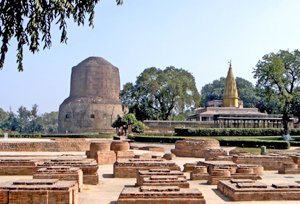
The word Sarnath has been derived from Saranganath (Lord of the Deer). After attaining enlightenment in Bodh Gaya, the Lord Buddha visited Sarnath. This place became one of the centers of pilgrimage after the Lord Buddha named Sarnath along with other three to be considered sacred to his followers before his death. Kushinagar, Bodh Gaya and Lumbini are the other three places considered holy and listed as Buddhist pilgrim centers.
The great emperor, The Ashoka, visited the holy land around 234 BC and constructed a Stupa. He is considered among the first followers who spread the Lord's messages across the Asia during his regime. Furthermore, it is discovered that during the 3rd and 11th century BC many followers and devotees built several Buddhist structures and monuments in Sarnath.
Facts about Sarnath
Best Time to visit: October to March Altitude: 80.71 m STD Code: 0542 Language: Hindi, English
Tourist Attractions in Sarnath
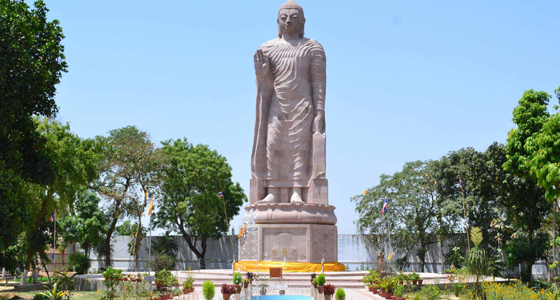
Thai Temple: The countries like Japan, Sri Lanka, India, Thailand, and so on having a large number of Buddhist followers or population have built (contributed) a temple or monastery in Sarnath. Every country has built their own structures in Sarnath that represents their respective architectural style. Among the several temples, monasteries and structures, Thai Temple is the most famous place of worship that is managed by only Thai Buddhist Monk.
Ashoka Pillar: Ashoka Pillar is also known as Sarnath Pillar. Ashoka Pillar depicts four lions in standing posture and a chakra at its bottom. It has an image of an elephant at the top and a galloping horse and a bull mounted on the bottom of Chakra. The Ashoka Pillar is 50m tall and the most attractive spot for the tourists. The animals symbolize the different phases of the Lord Gautama Buddha. The Elephant stands for his notion, bulls point to his birth, horse denotes his separation from royal life, and lions stand for the attainment of enlightenment. It is the 'must see' place in Sarnath.
Getting there
By Air: The nearest domestic airport is in Varanasi. Varanasi airport is well-connected to the metro cities such as New Delhi, Mumbai, Lucknow, etc.
By Rail: Multiple trains connect to Sarnath and Varanasi that begins from neighboring states of Uttar Pradesh.
By Road: If you have reached Varanasi, then it takes just a few minutes by a three-wheeler or taxi to cover the 10kms stretch to Sarnath. Furthermore, there are State Transport Buses that heads from all the nearby cities towards Varanasi and Sarnath.
Buddhism Pilgrimages in India
- Ajanta and Ellora Caves
- Nagarjunakonda
- Thotlakonda
Buddhism Tour Packages
- India and Nepal Buddhism Tour (17 Days)
- Buddhist Pilgrimage Tour (10 Days)
- Temple Tour with Footprint of Lord Budhha (14 Days)
- Journey of Buddhism (16 Days)
- Soul of Buddhism (16 Days)
- Buddhist Heritage Tour (12 Days)
- Buddhist Spiritual Tour (09 Days)
- Buddhhist Spiritual Holiday (12 Days)
- Buddhist Tour of North East (14 Days)
Other Pilgrimage in India
- Hindu Pilgrimages in India
- Sikh Pilgrimages in India
- Christian Pilgrimages in India
- Muslim Pilgrimages in India
- Jain Pilgrimages in India
Other Pilgrimage Tour Packages

Plan Your Trip
Request a FREE Quote

Our head office
0800 088 6002, [email protected], client log in, reset password, agent log in.

Exploring Sarnath: An ancient Buddhist site in Varanasi, Uttar Pradesh - A key destination on the Buddhist Pilgrimage Circuit
Sarnath, located in the ancient city of Varanasi in the northern Indian state of Uttar Pradesh, is an unparalleled destination for those embarking on India tours seeking to delve into the rich tapestry of Buddhist history and spirituality.
This sacred site holds profound significance as the place where Lord Buddha, also known as Siddhartha Gautama, delivered his first sermon to a small gathering of disciples, marking the inception of the Buddhist Sangha and the dissemination of his teachings.
Amidst the serene environs of Sarnath lies an archaeological treasure trove, adorned with magnificent pillars and stupas, all harkening back to a pivotal moment in the journey towards enlightenment.
In this article, we shall embark on a journey through the hallowed grounds of Sarnath, exploring its historical and spiritual importance and its architectural marvels that continue to draw pilgrims and history enthusiasts from around the world.
What is the history of Sarnath, and why is it considered an archaeological and pilgrimage site of great significance?
The history of Sarnath is deeply intertwined with the life of Lord Buddha (Siddhartha Gautama or Gautama Buddha) and is a testament to the origins of Buddhism. Sarnath, situated just a few kilometers away from Varanasi in Uttar Pradesh, India, holds immense historical and spiritual importance.
Sarnath's significance stems from the fact that it is where Lord Buddha delivered his first sermon, known as the Dhammacakkappavattana Sutta or the "Turning of the Wheel of Dharma." This event occurred shortly after Buddha attained enlightenment under the Bodhi Tree in Bodh Gaya. In Sarnath, he shared his profound insights into the Four Noble Truths and the Eightfold Path with five of his former ascetic companions. This momentous occasion marked the formal establishment of the Buddhist Sangha or monastic community.
Archaeologically, Sarnath boasts a rich heritage. Emperor Ashoka of the Maurya Dynasty, a fervent Buddhist, visited Sarnath in the 3rd century BCE and erected a series of stupas and monasteries to commemorate Buddha's teachings. Among the most famous structures is the Dhamekha Stupa, which is believed to mark the very spot where Buddha gave his first sermon. The Ashoka Pillar, crowned with four lions, was also erected here and is now a symbol of India.
Over the centuries, Sarnath's significance as a Buddhist pilgrimage site grew. Monasteries flourished, attracting monks from various parts of India and abroad. However, with the decline of Buddhism in India, Sarnath fell into a state of neglect.
In the 19th and 20th centuries, archaeological excavations unearthed the ancient ruins, stupas, and pillars, shedding light on its historical importance. Today, Sarnath stands as a living testimony to Buddhism's birth and evolution, attracting pilgrims, scholars, and history enthusiasts from across the globe. It remains a site of immense archaeological and spiritual significance, allowing visitors to connect with the teachings of Lord Buddha and the rich history of Buddhism in India.
Where is Sarnath located within Varanasi, Uttar Pradesh, and how can travelers access this sacred site on their India tours?
Sarnath is located in the northern Indian state of Uttar Pradesh, within the city limits of Varanasi. Varanasi, also known as Benares, is one of the oldest continuously inhabited cities in the world and is renowned for its spiritual and cultural significance.
To access Sarnath during their India tours, travelers typically start from the city of Varanasi, which is well-connected by various means of transportation:
By Air: The nearest major airport is Lal Bahadur Shastri International Airport, also known as Varanasi Airport (VNS). This airport serves both domestic and international flights. From the airport, Sarnath is easily accessible by taxi or hired car.
By Train: Varanasi Junction (Varanasi Cantt) is a major railway station in the region and is well-connected to major cities across India. Travelers arriving by train can take a taxi or an auto-rickshaw to reach Sarnath, which is approximately 12 kilometers away from the station.
By Road: Varanasi is well-connected by roadways, and travelers can hire taxis, auto-rickshaws, or use public buses to reach Sarnath. It is about a 30-minute drive from the city center of Varanasi to Sarnath.
Once in Sarnath, visitors can explore the sacred site on foot. The key attractions, including the Dhamekha Stupa, the Ashoka Pillar, and various monasteries and museums, are situated within a compact area, making it convenient for tourists to navigate and fully experience the historical and spiritual ambiance of this revered Buddhist pilgrimage site.
How can visitors reach the iconic Dhamekha Stupa and the renowned Ashoka Pillar in Sarnath?
Visitors to Sarnath can easily reach the iconic Dhamekha Stupa and the renowned Ashoka Pillar, both of which are prominent landmarks within this historical Buddhist site. Here's how to access them:
On Foot: The Dhamekha Stupa and Ashoka Pillar are within walking distance of each other within the Sarnath complex. Most visitors choose to explore these attractions on foot, as it allows them to take in the serene atmosphere and absorb the historical significance of the area. The walking path is well-marked, and there are informative signboards along the way.
Auto-rickshaw or Taxi: For those who prefer a quicker mode of transportation, auto-rickshaws and taxis are readily available in Sarnath. Visitors can hire an auto-rickshaw or taxi from the main entrance or nearby areas in Varanasi. The drivers are familiar with the Sarnath circuit and can drop you off directly at the Dhamekha Stupa or Ashoka Pillar.
Guided Tours: Many tourists opt for guided tours when visiting Sarnath. Local guides are knowledgeable about the history and significance of the site and can provide a comprehensive tour that includes both the Dhamekha Stupa and the Ashoka Pillar. These tours often offer valuable insights into the Buddhist history and the archaeological findings at Sarnath.
Bicycles: Some travelers choose to rent bicycles to explore Sarnath, including its key attractions. This option allows for a leisurely exploration of the area at your own pace.
Once you arrive at either the Dhamekha Stupa or the Ashoka Pillar, take the time to appreciate their historical and cultural significance. The Dhamekha Stupa, in particular, is believed to mark the spot where Lord Buddha delivered his first sermon, making it a focal point for pilgrims and visitors seeking a deeper connection to Buddhism's roots. The Ashoka Pillar, crowned with four lions, is an emblem of India and a symbol of Emperor Ashoka's commitment to the Buddhist faith. Both of these landmarks offer a unique glimpse into the ancient history of Sarnath and its importance in Buddhist heritage.
When is the best time to plan a visit to Sarnath to fully experience its historical and spiritual atmosphere?
The best time to plan a visit to Sarnath to fully experience its historical and spiritual atmosphere largely depends on weather conditions and personal preferences. Here are some considerations for different seasons:
Winter (October to March): Many travelers find the winter months to be the best time to visit Sarnath. During this period, the weather is cool and pleasant, making it ideal for exploring the historical and spiritual sites without the discomfort of extreme heat. Clear skies and comfortable temperatures make it an excellent time for sightseeing and photography. However, it's advisable to carry some warm clothing, especially during the evenings and early mornings, as temperatures can drop.
Spring (March to April): Spring is another favorable time to visit Sarnath. The weather remains pleasant, and the landscape often comes alive with blooming flowers and lush greenery. It's an excellent season for outdoor exploration, and you can enjoy the serenity of the site without the crowds that are common during peak tourist season.
Early Autumn (September): September marks the beginning of the post-monsoon season in India, and it can be a good time to visit Sarnath. The weather is generally mild, and the lush vegetation from the monsoon adds to the scenic beauty. However, there may be occasional rainfall, so it's a good idea to check the weather forecast before planning your trip.
Monsoon (July to August): Monsoon season can be challenging for visitors to Sarnath due to heavy rainfall and high humidity. The site may become slippery, and outdoor activities might be limited. However, some travelers enjoy the lush green surroundings and the relative lack of crowds during this time.
Summer (April to June): Summer in Varanasi and Sarnath can be scorching, with temperatures often exceeding 40°C (104°F). It's not the most comfortable time to visit, as the heat can be exhausting. If you choose to visit during this season, it's advisable to plan your activities early in the morning or late in the evening to avoid the hottest part of the day.
Who should consider visiting Sarnath, and what cultural and spiritual insights can they gain from the trip?
Sarnath is a destination that holds immense appeal for a wide range of travelers, and it offers valuable cultural and spiritual insights to those who visit. Here's a breakdown of who should consider visiting Sarnath and what they can gain from the experience:
Buddhist Pilgrims: Sarnath is one of the most important pilgrimage sites for Buddhists around the world. Pilgrims seeking a deeper connection to the life and teachings of Lord Buddha should definitely include Sarnath on their itinerary. It is here that Buddha delivered his first sermon and set in motion the wheel of Dharma. Visitors can meditate and reflect upon the Four Noble Truths and the Eightfold Path in the very place where these teachings were first expounded.
History Enthusiasts: Sarnath is an archaeological treasure trove with a rich history dating back thousands of years. History enthusiasts and archaeology buffs will find the site fascinating. The ancient stupas, monasteries, and the iconic Ashoka Pillar are tangible remnants of India's past, and exploring these structures can provide valuable insights into the region's cultural and historical evolution.
Spiritual Seekers: Sarnath offers a serene and contemplative atmosphere that appeals to spiritual seekers, regardless of their religious affiliation. The peaceful ambiance, combined with the historical significance of the site, creates an environment conducive to meditation, reflection, and spiritual growth. Even those on a spiritual quest outside of Buddhism can find inspiration here.
Cultural Explorers: Travelers interested in India's diverse culture and heritage will find Sarnath to be a captivating destination. It provides an opportunity to immerse oneself in the country's spiritual traditions and witness the coexistence of multiple faiths and cultural influences.
Photographers and Artists: The picturesque landscapes, intricate carvings, and the play of light and shadow on ancient structures make Sarnath a paradise for photographers and artists. The site offers endless opportunities for capturing the beauty and spirituality of India's heritage.
Students and Scholars: Sarnath is also a hub of academic interest, drawing students and scholars from various fields such as history, religion, archaeology, and art. It provides a living classroom for studying the evolution of Buddhism and the influence of Emperor Ashoka's patronage.
Why should travelers include Sarnath on their itinerary, and what makes it a must-visit destination for history enthusiasts and pilgrims?
Travelers should include Sarnath on their itinerary for several compelling reasons, making it a must-visit destination, especially for history enthusiasts and pilgrims. Here's why Sarnath is such a significant and rewarding place to explore:
Historical Significance: Sarnath is steeped in history and is considered one of the most historically significant sites in India. It is where Lord Buddha delivered his first sermon, known as the "Turning of the Wheel of Dharma." This event marked the beginning of the spread of Buddhism, a pivotal moment in the history of this ancient religion.
Archaeological Marvels: Sarnath boasts a wealth of archaeological treasures, including ancient stupas, monasteries, and the iconic Ashoka Pillar. These structures provide valuable insights into India's rich heritage and the architectural achievements of different time periods.
Ashoka's Legacy: Emperor Ashoka, one of India's most famous rulers, visited Sarnath in the 3rd century BCE and erected the Ashoka Pillar here. This pillar, crowned with four lions, has become a symbol of India and Ashoka's conversion to Buddhism. Pilgrims and history enthusiasts can see this iconic monument in its original location.
Spiritual Significance: Sarnath is a place of deep spiritual significance for Buddhists. Pilgrims visit to pay homage to the spot where Buddha first taught the path to enlightenment. The serene ambiance and the presence of monasteries create an atmosphere conducive to meditation and reflection.
Diverse Cultural Experience: Travelers to Sarnath can experience the confluence of different cultures and religions. In addition to Buddhist sites, Sarnath is home to Jain temples and a medieval mosque, showcasing the coexistence of various faiths over the centuries.
Educational Opportunities: Sarnath serves as an educational hub for those interested in Buddhism, history, and archaeology. Scholars and students often visit to conduct research and study the ancient artifacts and inscriptions.
Beautiful Landscapes: Sarnath's serene gardens and lush greenery offer a peaceful escape from the hustle and bustle of urban life. It's a place where travelers can relax, unwind, and connect with nature while exploring its historical treasures.
Cultural Exchange: Sarnath attracts visitors from all over the world, creating a multicultural and diverse atmosphere. Interacting with fellow travelers and locals can provide unique cultural insights and experiences.
Photographic Opportunities: The intricate carvings, grand stupas, and tranquil settings make Sarnath a paradise for photographers. The play of light and shadow on ancient structures offers numerous opportunities for capturing stunning images.
Pilgrimage Experience: For Buddhists, visiting Sarnath is a pilgrimage experience that allows them to follow in the footsteps of Lord Buddha and deepen their connection to their faith and its history.
How much does it cost to explore the various attractions in Sarnath, including entry fees and guided tours?
Exploring the various attractions in Sarnath involves a combination of entry fees for specific sites and the optional cost of guided tours. Here's a breakdown of the typical expenses you can expect when visiting Sarnath:
Entry Fees: Many of the key attractions in Sarnath have nominal entry fees. Here are some common entry fees:
- Dhamekha Stupa: Indian nationals: ₹15, Foreign nationals: ₹200
- Sarnath Museum: Indian nationals: ₹5, Foreign nationals: ₹100
- Mulagandha Kuti Vihara: Entrance fee may apply.
- Ashoka Pillar: Entrance fee may apply.
- Chaukhandi Stupa: Entrance fee may apply.
Please note that entry fees are subject to change, and it's advisable to check the most up-to-date rates before your visit.
Guided Tours: While not mandatory, many visitors opt for guided tours to enhance their understanding of Sarnath's history and significance. The cost of guided tours can vary widely depending on the duration and level of expertise of the guide. It's a good idea to negotiate the price with your guide or book a tour through a reputable agency in Varanasi.
Transportation: The cost of transportation to and from Sarnath will depend on your starting point in Varanasi. Auto-rickshaws and taxis are common modes of transport, and prices may vary based on distance and negotiation.
Optional Expenses: Visitors may choose to make additional donations at monasteries, temples, or religious sites as a sign of respect or support for the local community. Additionally, if you plan to participate in meditation sessions or rituals, there may be associated costs or suggested donations.
Food and Refreshments: Sarnath has a few restaurants and stalls where you can enjoy local cuisine. The cost of meals and refreshments will depend on your preferences and dietary choices.
Shopping: Sarnath offers opportunities for purchasing souvenirs, religious items, and handicrafts. The cost of shopping will depend on what you choose to buy and your bargaining skills.
Overall, the cost of exploring Sarnath can be relatively affordable, especially when compared to many other tourist destinations. It's a good practice to budget for entrance fees, transportation, and any guided tours or additional activities you plan to participate in. Additionally, keeping some extra funds for unexpected expenses or personal purchases is advisable for a more enjoyable visit.
What is the recommended dress code for visitors to Sarnath, respecting its spiritual significance and local customs?
Visitors to Sarnath are encouraged to dress modestly and respectfully, keeping in mind the spiritual significance of the site and local customs. Here are some recommendations for the dress code when visiting Sarnath:
Covered Shoulders and Knees: Both men and women should wear clothing that covers their shoulders and knees. Sleeveless tops, short skirts, and shorts are generally not considered appropriate attire for visiting religious and sacred sites in India.
Loose-Fitting Clothing: Opt for loose-fitting clothing that is comfortable for walking and sitting, as Sarnath may involve a fair amount of walking and meditation. Loose clothing also helps in maintaining modesty.
Avoid Revealing Attire: Avoid clothing that is too revealing or low-cut. It's important to show respect for the religious and spiritual environment by dressing modestly.
Remove Shoes: At certain sites within Sarnath, such as temples and monasteries, visitors are required to remove their shoes before entering. Wearing slip-on shoes or sandals that are easy to remove can be convenient.
Head Covering (Optional): While it's not mandatory, some visitors choose to cover their heads as a sign of respect when entering temples or participating in religious ceremonies. Carrying a scarf or shawl that can be used for this purpose is a good idea.
Light Colors: Light-colored clothing is not only practical in the Indian climate but is also considered respectful and traditional in many Indian cultures.
Comfortable Footwear: Sarnath involves a fair amount of walking, so comfortable and sturdy footwear is recommended. Sandals or flip-flops may not provide the necessary support for exploring the site.
Weather Considerations: Depending on the time of year you visit, consider the weather conditions. In the summer, lightweight and breathable fabrics are preferable, while in the winter, you may need warmer clothing, especially for early morning and evening visits.
Carry a Shawl or Scarf: It's a good idea to carry a shawl or scarf that you can drape over your shoulders if needed for added modesty or to protect yourself from the sun.
Respect Local Customs: Observe and respect any specific dress code rules or customs that may be in place at individual temples or monasteries within Sarnath. Some may have stricter requirements.
By dressing modestly and respectfully, visitors not only show consideration for the spiritual and cultural values of the site but also help create a harmonious atmosphere for all those who come to Sarnath to seek enlightenment, reflection, and inner peace.
What are the opening hours of the key sites in Sarnath, such as the Chaukhandi Stupa and Ashoka Pillar?
The opening hours of key sites in Sarnath, including the Chaukhandi Stupa and Ashoka Pillar, can vary, and it's advisable to confirm the timings locally or through reliable sources as they may change over time. Here are the general opening hours for these sites:
Chaukhandi Stupa: The Chaukhandi Stupa is usually open to visitors during daylight hours. It typically opens in the morning and closes in the evening. A common guideline for many historical and archaeological sites in India is to open around sunrise (approximately 6:00 AM) and close around sunset (approximately 6:00 PM). However, specific hours may vary seasonally.
Ashoka Pillar: The Ashoka Pillar in Sarnath is often open during daylight hours as well. The opening and closing times are typically aligned with those of the Chaukhandi Stupa, opening in the morning and closing in the evening.
Dhamekha Stupa: The Dhamekha Stupa is typically open to visitors during daylight hours. It generally opens in the morning and closes in the evening, aligning with sunrise and sunset times.
Sarnath Museum: The Sarnath Museum typically operates on a schedule similar to other museums in India. It may open around 9:00 AM and close in the late afternoon, around 5:30 PM. It is closed on Fridays and on national holidays.
Mulagandha Kuti Vihara: The opening hours for the Mulagandha Kuti Vihara can vary, but it is usually open to visitors in the morning and afternoon. It is advisable to inquire locally or check at the entrance for the specific timings on the day of your visit.
Please note that these opening hours are subject to change due to factors such as weather conditions, maintenance, or local regulations. Additionally, it's a good idea to arrive at the sites well in advance of their closing times to ensure you have enough time to explore and fully appreciate the historical and spiritual significance of these landmarks.
For the most up-to-date information on opening hours and any special considerations for visiting these sites, you can inquire with local authorities, tourism offices, or the staff at the entrance to Sarnath when you arrive.
How can travelers immerse themselves in the serene ambiance of Sarnath and connect with the teachings of Lord Buddha during their visit?
Travelers seeking to immerse themselves in the serene ambiance of Sarnath and connect with the teachings of Lord Buddha during their visit can follow these steps to make the most of their experience:
Meditation and Contemplation: Sarnath is an ideal place for meditation and contemplation. Find a quiet spot within the grounds, such as near the stupas or under the shade of a tree, and take some time to meditate or simply sit quietly. Reflect on the teachings of Lord Buddha and the significance of the site.
Attend a Prayer or Meditation Session: Many monasteries and meditation centers in Sarnath offer prayer and meditation sessions. Check in advance if there are any scheduled sessions during your visit and consider participating to immerse yourself in the spiritual atmosphere.
Visit the Stupas: Explore the various stupas in Sarnath, including the Dhamekha Stupa and Chaukhandi Stupa. These ancient structures hold historical and spiritual significance. Circumambulate (walk around) them clockwise, which is a traditional practice, while contemplating the Buddhist teachings.
Explore the Museums: Sarnath has museums that display ancient artifacts, sculptures, and relics related to Buddhism. Visit the Sarnath Museum to gain a deeper understanding of the history and art associated with the site.
Observe Monastic Life: Sarnath is home to several monasteries, and you can often observe the daily activities of monks and nuns. Be respectful and considerate when observing their way of life, and if appropriate, engage in respectful conversations to learn more about their practices and beliefs.
Offer Prayers and Offerings: If you follow a Buddhist tradition or simply wish to show respect, you can offer prayers or light incense at the shrines and altars within the monasteries or temples.
Read and Study: Bring along books or materials related to Buddhism and Lord Buddha's teachings. Reading passages from Buddhist scriptures or writings on Buddhist philosophy can enhance your connection to the teachings.
Connect with Locals: Engage in conversations with locals, including pilgrims and residents, to gain insights into the spiritual and cultural aspects of Sarnath. Their perspectives and stories can provide a richer context for your visit.
Participate in Ceremonies: If there are any religious ceremonies or rituals taking place during your visit, consider participating respectfully. These events can offer a profound experience of the local traditions and spirituality.
Practice Mindfulness: Embrace the practice of mindfulness as you explore Sarnath. Be fully present in the moment, observe the details of the architecture and surroundings, and appreciate the sense of peace and tranquility that pervades the area.
By combining these practices and approaches, travelers can create a meaningful and spiritually enriching experience in Sarnath, connecting with the teachings of Lord Buddha and the profound historical and cultural heritage of this sacred site.
Search our Blog
Related tours.
Travel overland from India to Nepal, taking in Delhi, Jaipur and Agra plus less visited sites and villages, holy Varanasi, Buddhist Sarnath and Lumbini and wildlife safaris in Bardia National Park before finishing in Kathmandu.
Small Group
This comprehensive northern India tour explores Rajasthani towns, remote villages, forts and palaces, visits a National Park, and sees the Taj Mahal and Agra Fort before heading to the holy city of Varanasi on the River Ganges.
This tour extends our Incredible India route from Delhi and the Taj Mahal in Agra, remove Hinduan and the Pink City of Jaipur, to the holy city of Varanasi on the banks of the Ganges.
RECENT POSTS FROM OUR BLOG
Need some travel inspiration or looking for some handy travel tips? Our blog provides excellent insight into our travel destinations - from tour updates to country guides, packing lists to little known things to do, you'll find it all in our travel blog.
Exploring the Holiest Sikh Shrine: Visit the Golden Temple in Amritsar (Sri Harmandir Sahib)
Discover the Rich Sikh Heritage at Golden Temple Amritsar, a Marvel of Marble, and the Holiest Sikh Temple.
Amritsar: A Spiritual Pilgrimage Hub for Sikhs in Punjab with the Golden Temple as a Revered Attraction
Explore Amritsar: A Sikh Pilgrimage Centre with the Golden Temple (Harmandir Sahib), the Holiest City in Punjab, near Pakistan Border.
The Wagah Border Ceremony in Amritsar: Timing, entry fee details and more
Discover the mesmerizing Wagah Border Ceremony in Amritsar, with timing, entry fee details, and more. Witness the thrilling border ceremony at Wagah.
Kalka Shimla Toy Train: One of the most beautiful railway journeys on the Kalka Shimla Railway, timings, booking and more for the Himalayan Queen Railway
Discover the UNESCO World Heritage Site: Kalka Shimla Toy Train Railway. Travel from Kalka to Shimla, book your journey, and explore the hill station.
The Yamuna River: A sacred river in India nurturing Hindu traditions
Discover the Yamuna River of Northern India: A sacred river in New Delhi, holding profound significance in Hindu Culture. Read more!
Mughal Heritage Walk Agra: A guided walking tour through Kachhpura Village - Taj Mahal, Agra Fort, and more
Mughal Heritage Walk in Agra: Explore monuments of the Mughal era on a guided walking tour through the village of Kachhpura, featuring views of the Taj Mahal and Agra Fort, and more.
Celestial Wonders of UNESCO World Heritage Monument, Jantar Mantar in Delhi: A Journey from New Delhi to Jaipur
Explore Jantar Mantar in Delhi, a UNESCO World Heritage site symbolizing a profound example of the coming together of the universe, society, and beliefs. Read about entry fees, timings, and more of this celestial wonder.
City Palace Jaipur: Timing, entry Fee, fascinating insights into the City Palace of Jaipur, and the Legacy of Jaipur's Royal Family
City Palace Jaipur is one of many incredible historical structures in India: In this City Palace of Jaipur guide, discover timings, entry fee, and insights into the royal legacy in the Pink City of Jaipur

COMMENTS
5. Ashoka Pillar, Sarnath. Top Attraction 3.5 /5. 0 km. from city center 5 out of 9. Places To Visit in Sarnath. The national emblem of India and a mark of Emperor Ashoka's visit to Sarnath, this 50 m tall pillar crafted out of a stone is an impressive structure. Read More.
A visit to this historic site is a must for those interested in Buddhism and the rich cultural heritage of Sarnath. 3. See the Mulagandha Kuti Vihar. Mulagandha Kuti Vihar- best places to visit in Sarnath. Sarnath is a serene and historic place where you can experience the spiritual and cultural heritage of India.
Pilgrimage. #10 of 12 Places to Visit in Sarnath. At a distance of 500 m from Sarnath Railway Station, and 9 km from Varanasi Junction, the Chinese Temple is a Buddhist temple situated in Sarnath, Uttar Pradesh. Next to Mulagandha Kuti Vihar, it is one of the popular Buddhist temples in Sarnath and among the prominent Sarnath tourist places.
Sarnath is located about 8 miles northeast of Varanasi in Uttar Pradesh. Travel time is about 30-40 minutes, making it an easy half-day trip from Varanasi. There are various ways of getting there, depending on your budget. The most convenient way is to take an auto-rickshaw or Ola cab (the Indian version of Uber.
Places to Visit in Sarnath. 1. Ashoka Pillar. 2. Dhamekh Stupa, Sarnath. Dhamek Stupa is a massive stupa located at the archaeological site of Sarnath in the state of Uttar Pradesh, India...
If you are visiting this holy city, keep this list of top 10 things to do in Sarnath handy for a comprehensively fun travel experience. 1. Witness The Majestic Bodhi Tree. 2. Visit Chaukhandi Stupa. 3. Seek Enlightenment At Dhamek Stupa. 4. Visit The Place Where The Buddha Rests In Peace.
Here are 12 amazing places to visit in Sarnath. Let's get started. 1. Dhamek Stupa. Dhamek Stupa. Dhamek Stupa is situated just behind Mulgandha Kuti Vihar. Dhamek Stupa is a group of buildings that includes, stupas, monasteries, ruins, temples, museums, and gardens.
Bengaluru, India45 contributions. Serene Tranquil - Relive Buddha Ashoka and their relics. Sarnath is a place located 10 kilometres north-east of Varanasi near the confluence of the Ganges and the Varuna rivers in Uttar Pradesh. The deer park in Sarnath is wherein, circa 528 BCE, at 35 years of age, Gautama Buddha taught his first sermon after ...
Sarnath is a holy place 13km east of Varanasi, and the religion of this holy place is kindness. Sarnath is an important pilgrimage site for Buddhist and Jain monks, and you will encounter many of them when you explore the interiors. While in Sarnath, you can visit many temples, stupas and the iconic Ashokan Pillar. Sarnath is a great place for ...
Places to visit in Varanasi ; Things to do near Sarnath; Search. Things to Do near Sarnath. Sarnath Tours. When are you travelling? Start Date. End Date. Search. Clear Dates. ... Sarnath, Varanasi 221007 India. Experiences from ₹3,990. See 6. Experiences. Sarnath Zoo. 6 Reviews. Dharmapala Road Sarnath, Varanasi 221007 India. Buddha Fountain.
Sarnath is a small village in Uttar Pradesh, India, about 13 km north-east of Varanasi.It's famous as the site of the deer park where Gautama Buddha first taught the Dharma and also where the original Sangha was formed. Consequently, it is one of the 4 main Buddhist pilgrimage destinations.. Dhamekh Stupa. Within the deer park complex is the large Dhamekha Stupa, constructed by the Emperor ...
Dhamek Stupa is a prominent Buddhist site located in Sarnath, near Varanasi in Uttar Pradesh, India...
At a distance of 9 km from Varanasi Junction, Sarnath is a revered Buddhist pilgrimage center located near the confluence of Ganga and Varuna Rivers in Uttar Pradesh. It is one of the popular Buddhist pilgrimage sites in India and also one of the must visit Varanasi Tourist Places.
Sarnath Importance and Places to Visit. Sarnath is a treasure trove of historical artifacts. A few must-see places to visit in Sarnath include Dhamekh Stupa, Sarnath Archaeological Museum and Chaukhandi Stupa. ... this city has some serious tourist attractions. Varanasi is one of the oldest continuously inhabited cities in the world and serves ...
See ways to experience (89) 8. Shri Kashi Vishwanath Temple (Golden Temple) 1,753. Architectural Buildings. Standing on the western bank of India's holiest river Ganges, Varanasi is the oldest surviving city of the world and the cultural capital of India. It is in the heart of this city that there stands in its fullest majesty the Kashi ...
The cost to get in is Rs. 25 for Indians and Rs. 100 for foreigners. Sarnath Museum: It is situated 1.5 km from Sarnath Railway Station. The Archaeological Museum in Sarnath is a must-see for every historical fan. Buddhist antiquities were moved there from their original location at the site of Buddha's first lecture.
Varanasi to Sarnath Day Trip - The Ultimate Travel Guide. Sarnath is one of the major pilgrimages for the Buddhists for this is the place where Lord Buddha gave his first sermon. Someone once told us that each and every stone of Sarnath is steeped in history. This spiritual destination near Varanasi was originally known as Isipathana.
13. Sankat Mochan Hanuman Temple. 14. Vishnu Tea Emporium. Map of Places to Visit in Varanasi. 1. Ganges River. Sunset view of Varanasi from the Ganges River. Named after the Hindu goddess Ganga, the Ganges River is one of the most revered natural sites in India.
SARNATH. Sarnath is a place located 10 kilometres north-east of Varanasi near the confluence of the Ganges and the Varuna rivers in Uttar Pradesh, India. The deer park in Sarnath is where Gautama Buddha first taught the Dhamma, and where the Buddhist Sangha came into existence through the enlightenment of Kondanna.
Get the best Information about Sarnath Tourism. Get travel guides and plan your trip to Sarnath with tour packages, places to visit, sightseeing, hotels, and reviews by other travellers. ... The top places near to Sarnath are Varanasi which is 8 km from Sarnath, Vindhyachal which is located 57 km from Sarnath, Allahabad which is located 118 km ...
#9 Dhamek Stupa, Sarnath (one of my favorite places to visit in Varanasi) Sarnath is an area outside the heart of Varanasi and absolutely worth visiting. It's famous because it's where Lord Buddha delivered his first sermon after attaining enlightenment. The Dhamek Stupa is a structure marking the spot where Buddha preached and is a symbol ...
Sarnath is another one of the top places to visit in Varanasi in 2 days. While technically it is not within Varanasi city, it is located at a mere distance of 10 km from the city, making it a perfect day trip from Varanasi. Sarnath is believed to be one of the 4 pilgrimage sites that a dutiful Gautam Buddha follower must visit.
Planing A Visit. Sarnath (lat 25 0 22'N. ; long 83 0 01'E.; District Varanasi, Uttar Pradesh), renowned for ancient remains of Buddhist stupas, monasteries and temple , is situated at a distance of 9 K.m. to the north of Varanasi city which is well connected by road , rail and air. Sarnath Museum Celebrated International Museum Day on 18.05.2015
Getting there. By Air: The nearest domestic airport is in Varanasi. Varanasi airport is well-connected to the metro cities such as New Delhi, Mumbai, Lucknow, etc. By Rail: Multiple trains connect to Sarnath and Varanasi that begins from neighboring states of Uttar Pradesh. By Road: If you have reached Varanasi, then it takes just a few minutes by a three-wheeler or taxi to cover the 10kms ...
Sarnath, located in the ancient city of Varanasi in the northern Indian state of Uttar Pradesh, is an unparalleled destination for those embarking on India tours seeking to delve into the rich tapestry of Buddhist history and spirituality.. This sacred site holds profound significance as the place where Lord Buddha, also known as Siddhartha Gautama, delivered his first sermon to a small ...
Varanasi is one of the most prominent tourist places in India.The city attracts millions of domestic and international tourists. The temples across the city attract pilgrims.The ghats and the Buddhist site Sarnath attract tourists from abroad. Varanasi is one of the oldest cities in the world, which makes it rich with cultural heritage. The city is home to ghats, temples, museums, and many ...